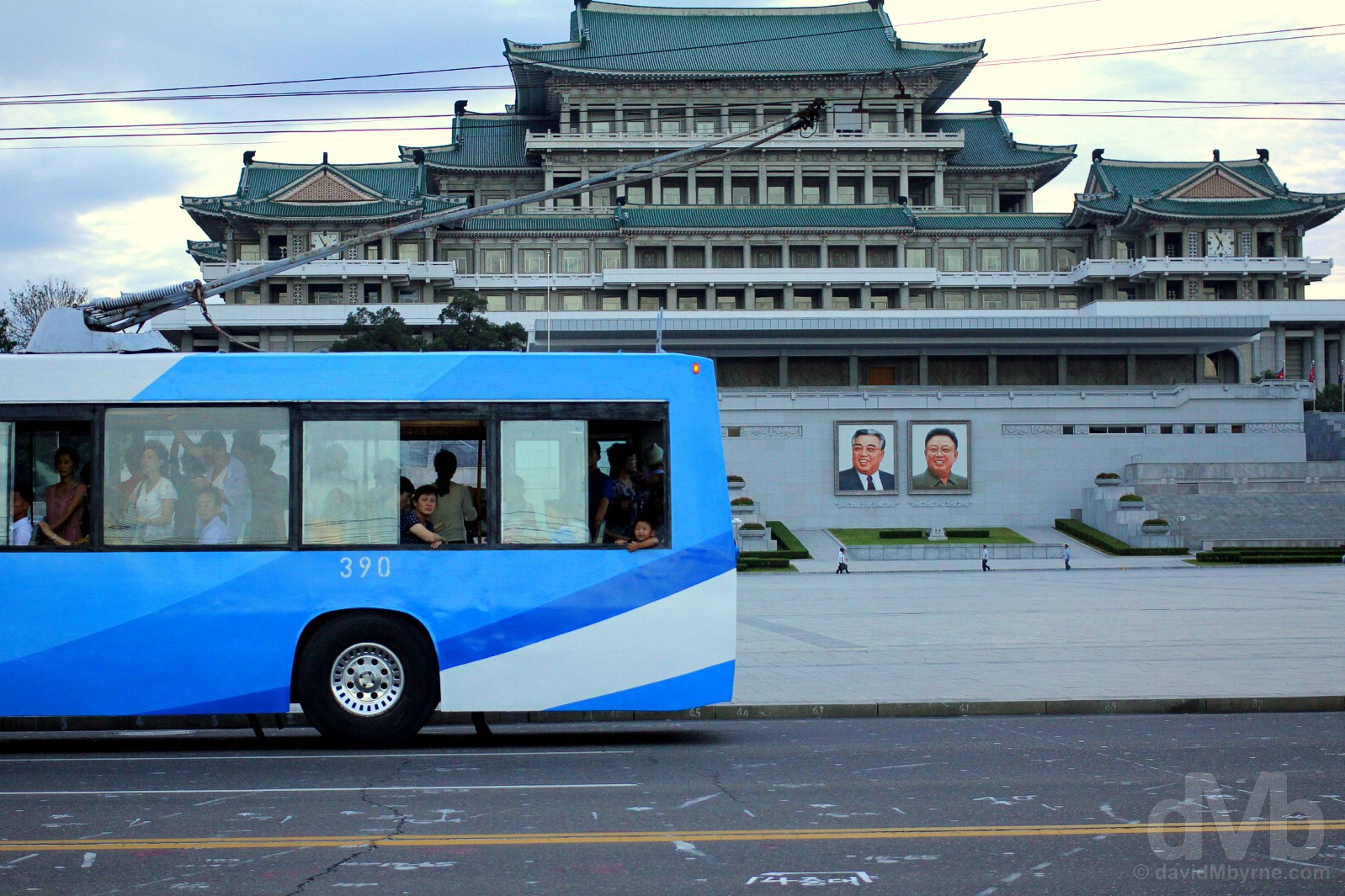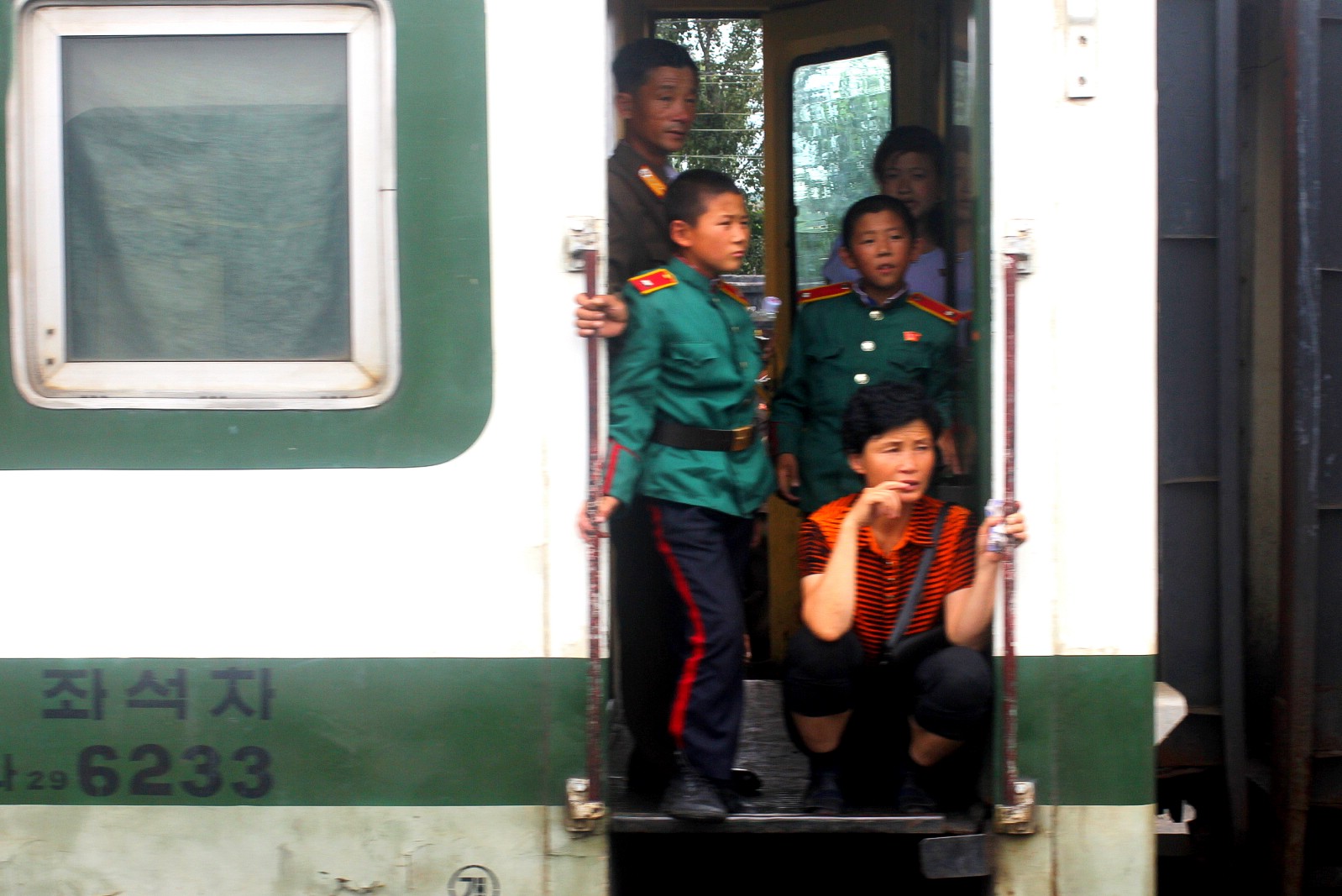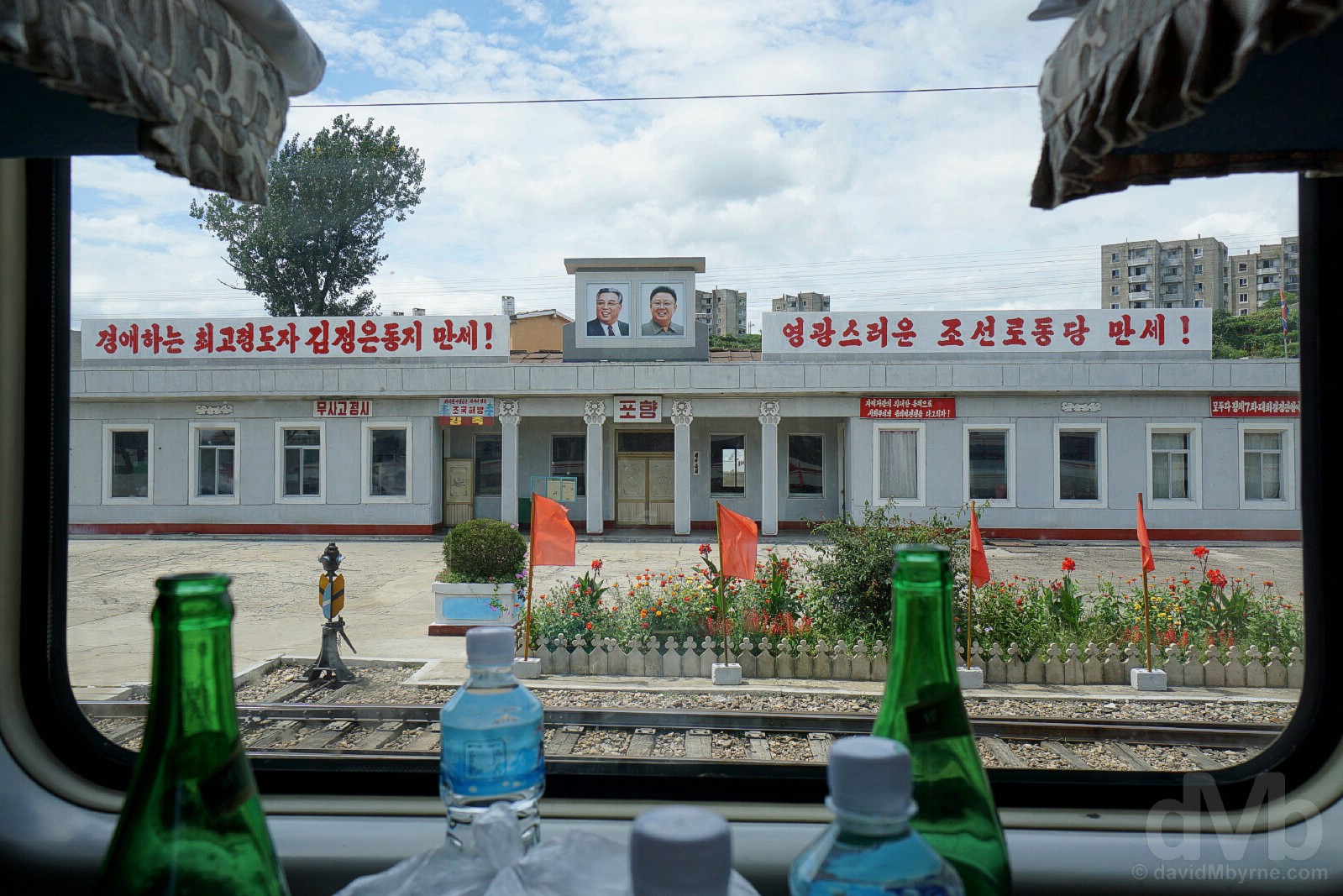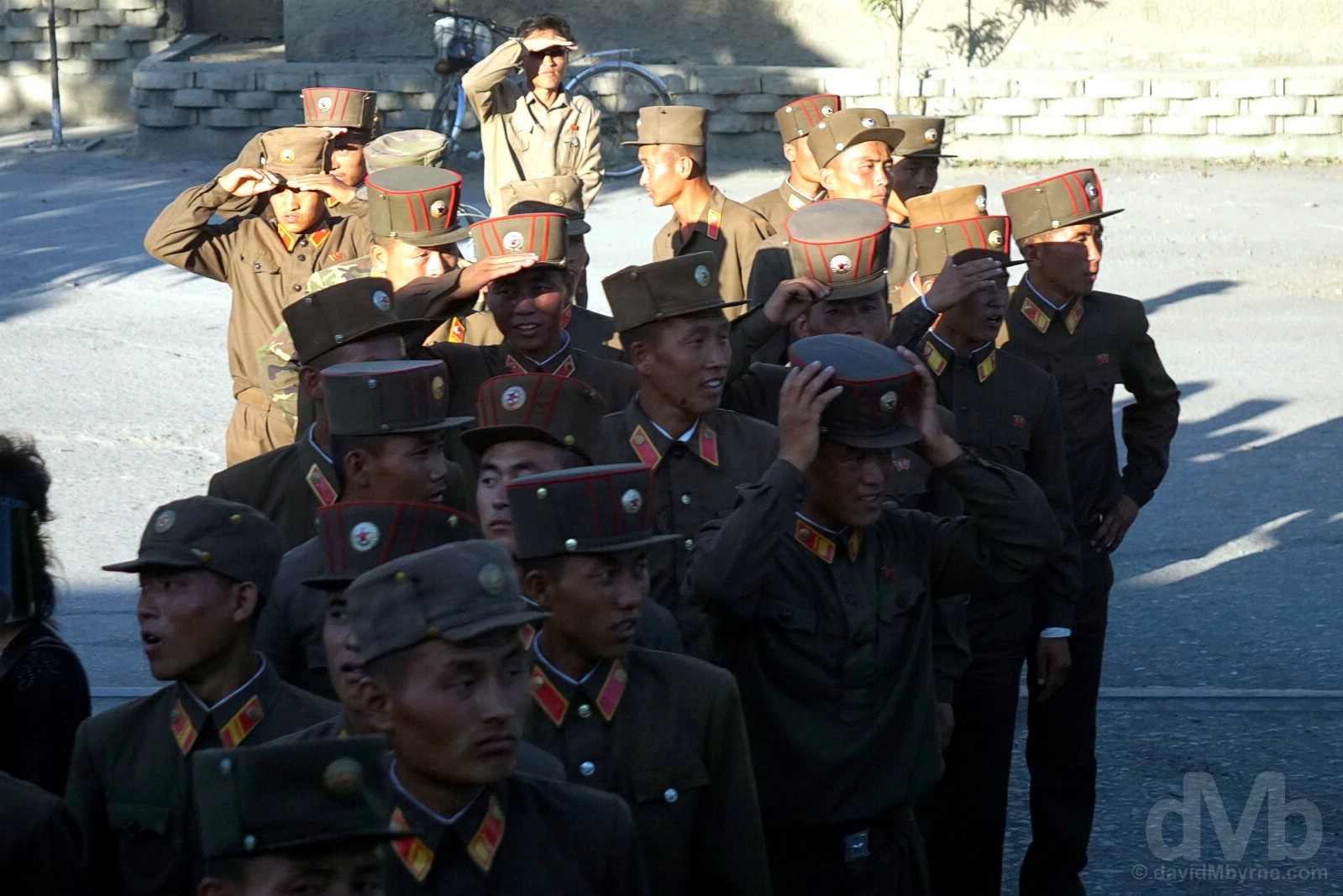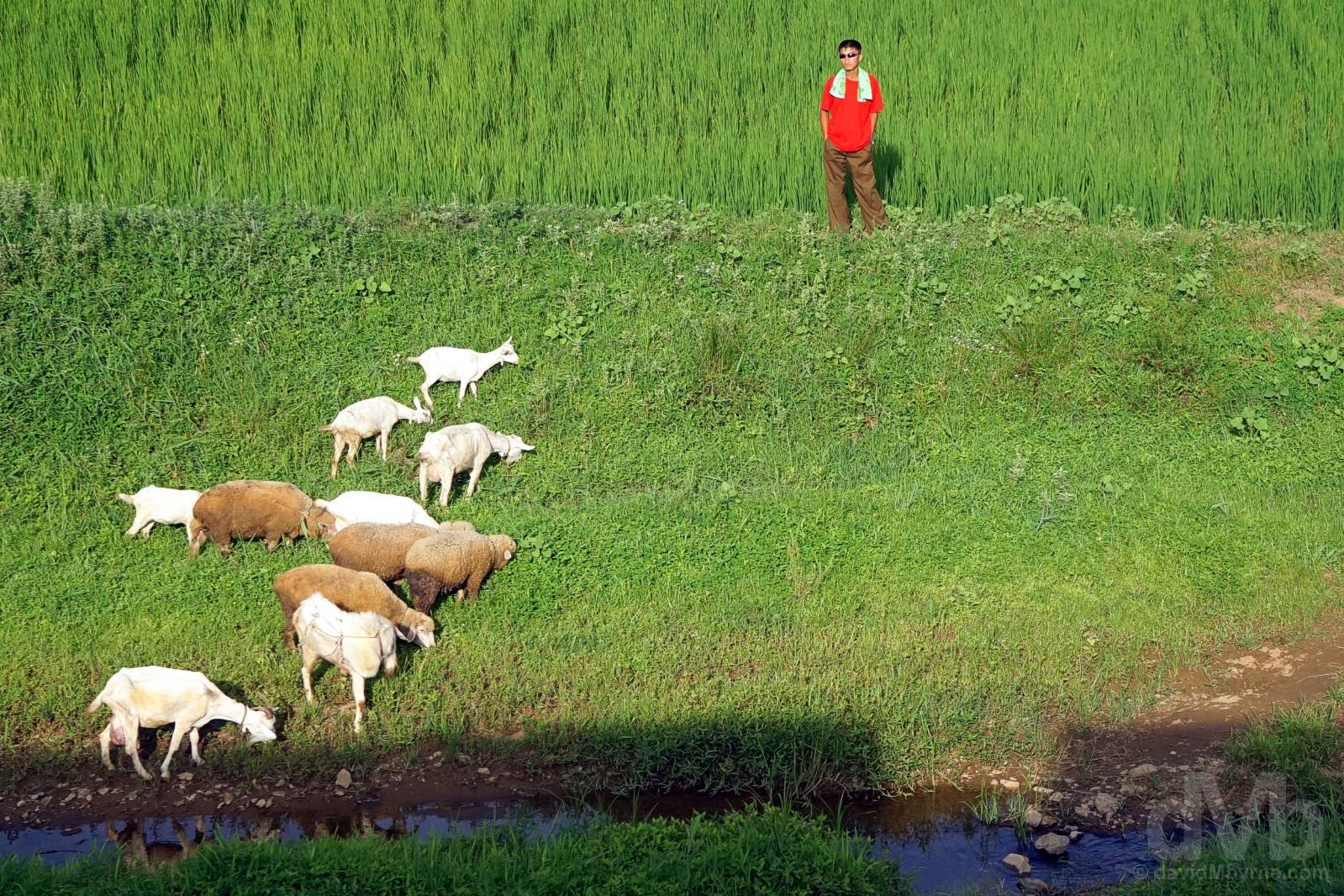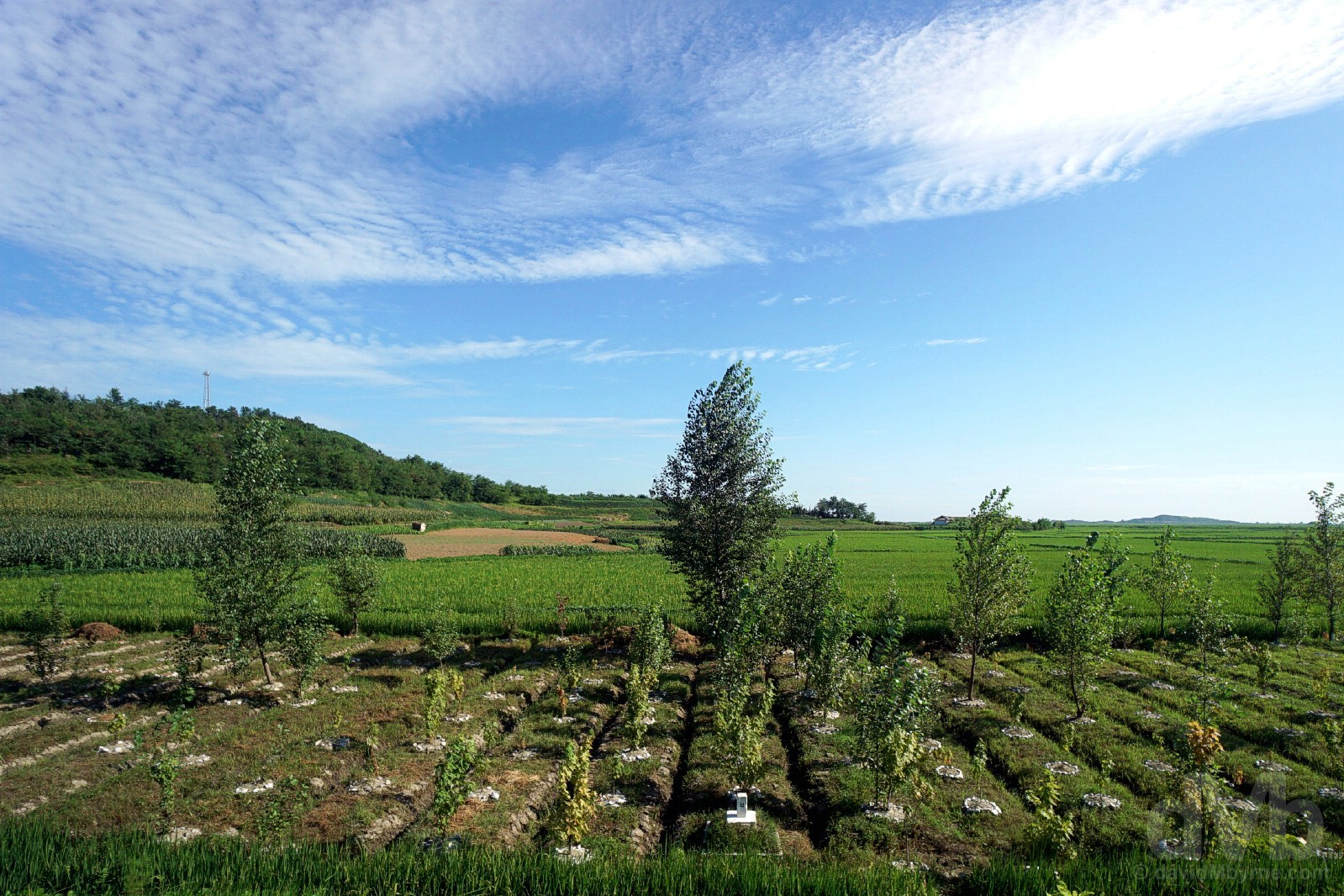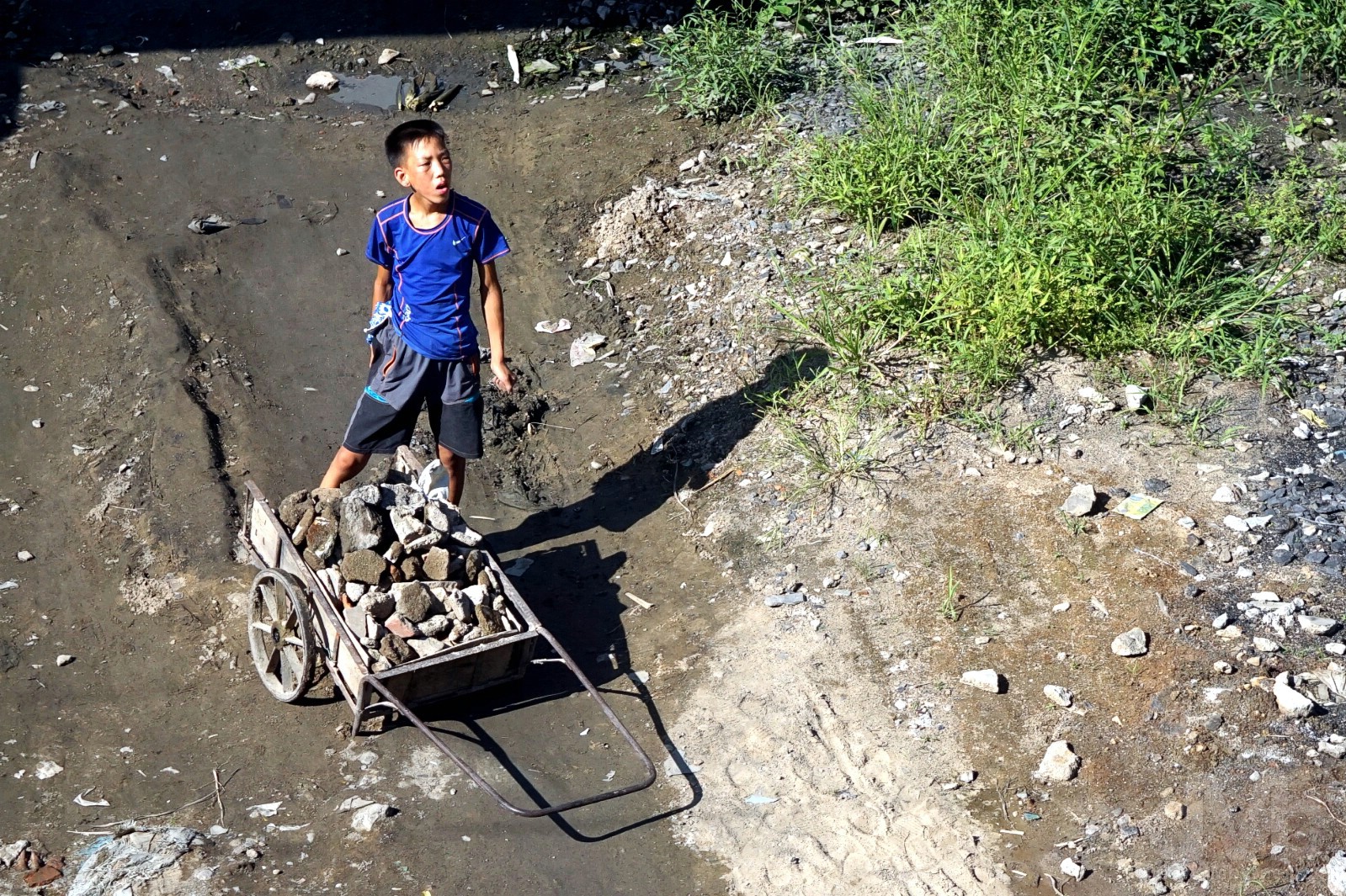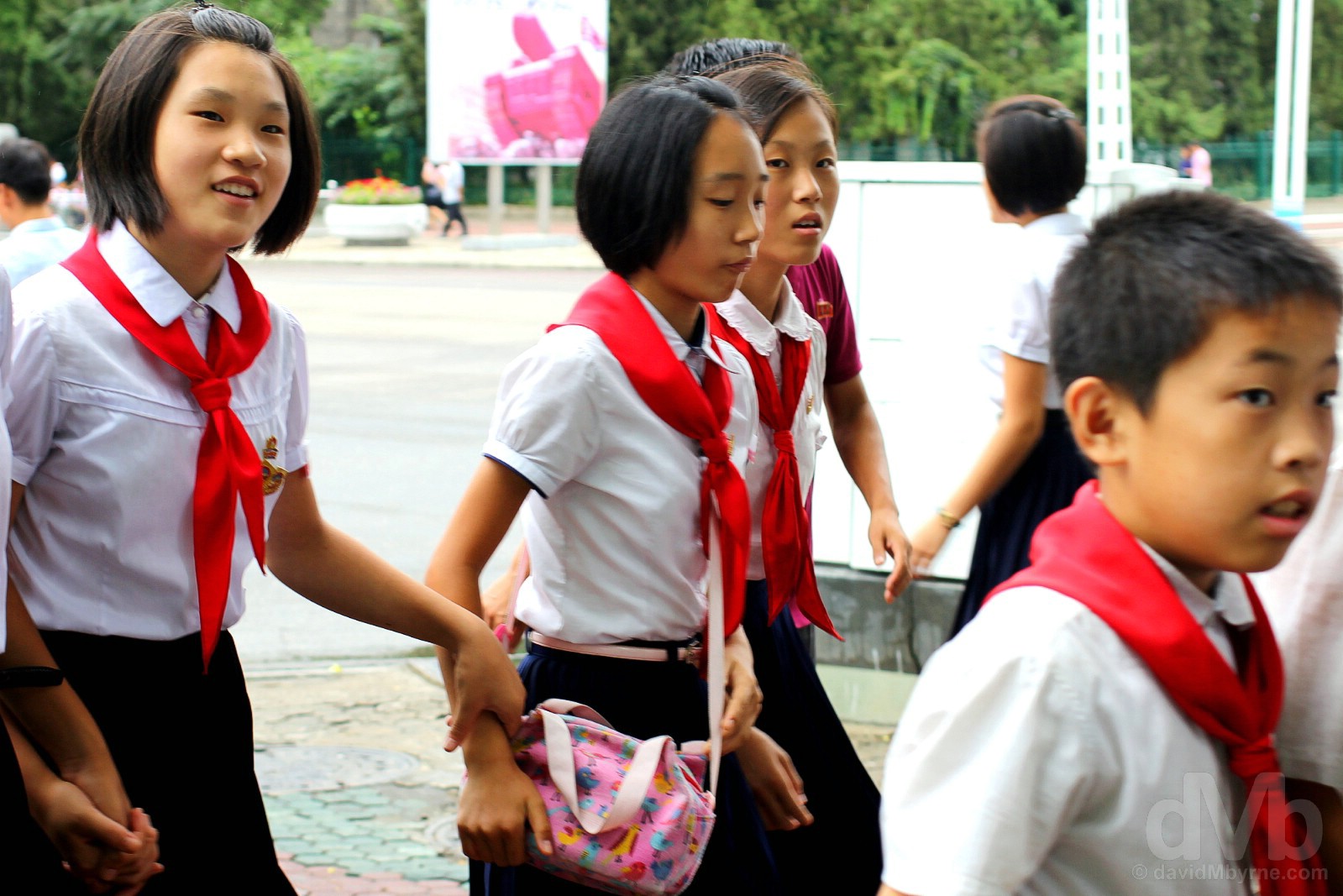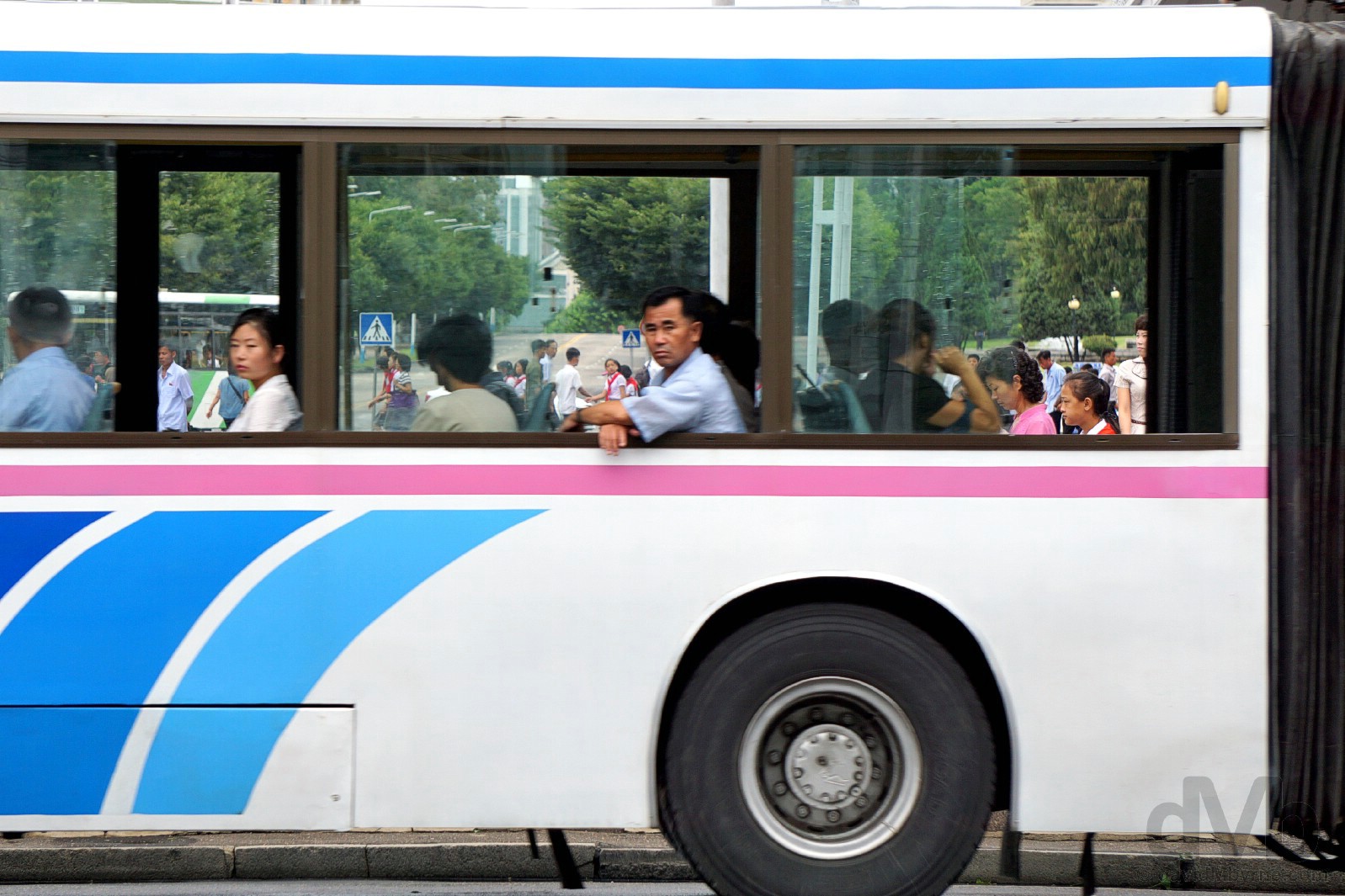North Korea
The World’s Most Secretive Nation, Its Last Stalinist Dictatorship & One Of The Planet’s More Niche Travel DestinationsIMAGE || Offerings to the Great & Dear Leaders at the Mansudae Hill Grand Monument, Pyongyang, North Korea.
“…this is probably the most revered location at which to pay one’s respects to the dead august leaders, not to mention where the bizarre personality cult of North Korea’s founding dynasty can be witnessed firsthand by nescient foreigners like me.”
North Korea
Well. What an experience that was. At three days and two nights, my trip to the surreal & secretive Stalinist dictatorship that is the Democratic People’s Republic of Korea (DPRK), a.k.a. North Korea, was brief.
Three days.
Three days of being monitored.
Three days of being chaperoned, guided, led to see only what I was supposed to see, the very best of what the North Korean capital is prepared to divulge to doubting foreign eyes.
Three days of eating what, where & when I was told.
Three days of biting your tongue, checking what you say and when you say it.
Three days of commenting how ‘normal’ life feels here for seemingly normal people – people just like you and me and people who know no different – all the while knowing that life here is anything but normal in the Western sense of the word.
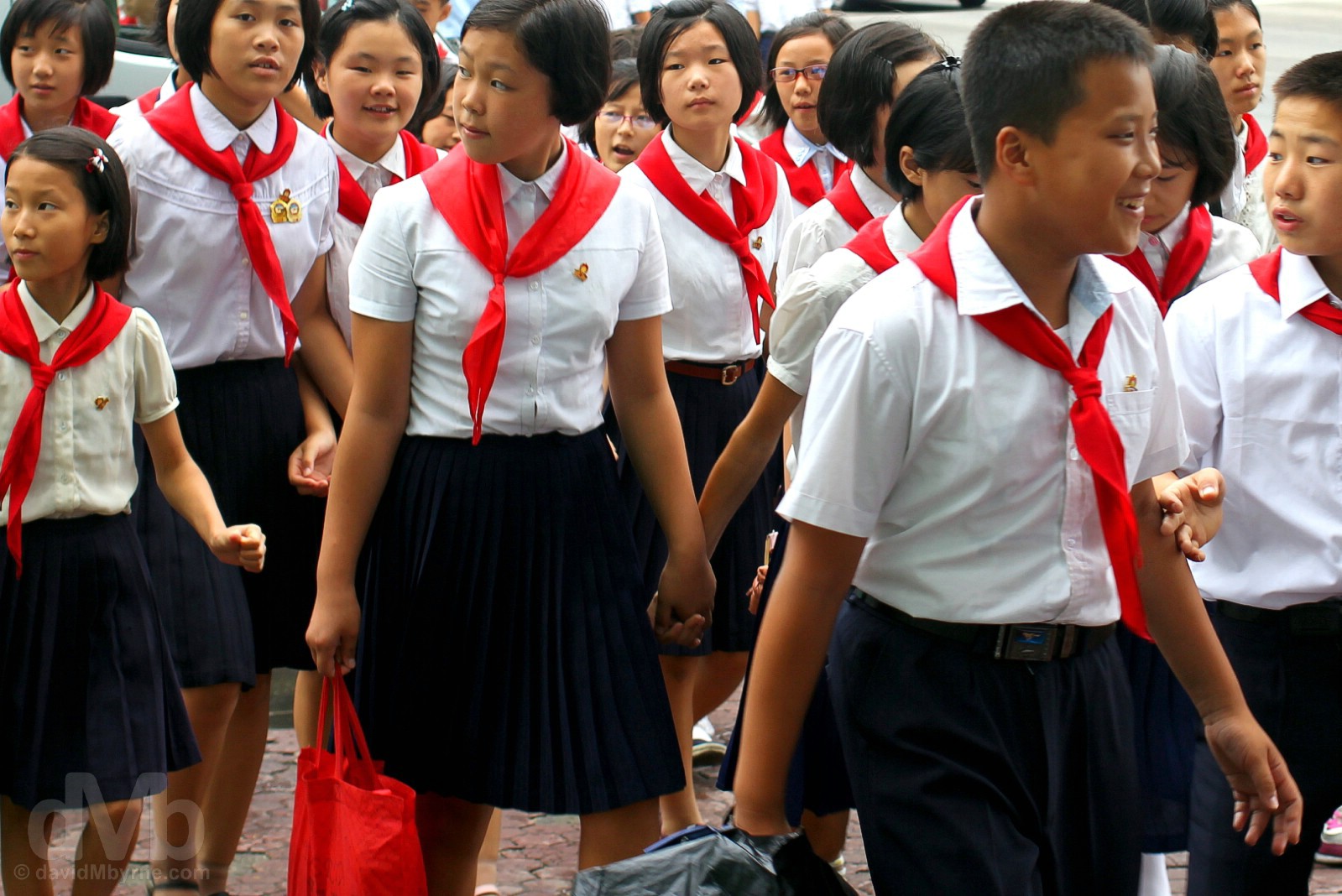
Normal. Schoolchildren on Sungri Street, Pyongyang, North Korea. August 15, 2017.
Three days of being surprised, being impressed, being awed & being curious about the pariah state, the ostracised, aloof & so-called ‘most secretive nation on earth’ where fact is routinely stranger than fiction.
Three days which seemed to pass in the blink of an eye.
Three days of a surreal buzz the likes of which I’ve never experienced before, or are likely to again.
– Boring. The Department of Foreign Affairs and Trade of Ireland, August 2017
The Democratic People's Republic of Korea (DPRK/North Korea) Overview
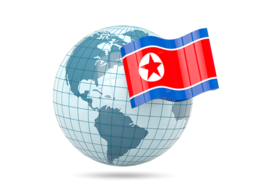 Democratic People’s Republic of Korea (DPRK)
Democratic People’s Republic of Korea (DPRK)
Region – East Asia (dMb tag: East Asia). Capital – Pyongyang. Population – 25 million. Official Language – Korean. Currency – North Korean Won (KPW). GDP (nominal) per capita – US$1,000. Political System – Unitary one-party republic/totalitarian communist dictatorship. UN Member? – Yes (admitted jointly with South Korea in September 1991). G20 Member? – No. Size – 120,000 km² (one-fifth larger than South Korea, one-eightieth the size of China, its northern neighbour & only ally, and slightly smaller than the US state of New Mexico). Topography – Mountainous. 80% of the country is covered in mountains, the majority of workable land, most of it situated on a wide western coastal plain, turned over to crops. Climate – Hot & sticky summers, bitterly cold winters. Formation/Independence & Brief History – Independence from Japan – who annexed the Korean Peninsula in 1910 ending centuries of dynastic rule – on August 15, 1945, thereafter the peninsula was officially divided by the U.S. & the Soviet Union at the 38th parallel. The Democratic People’s Republic of Korea (DPRK), following the Soviet model, was declared on September 9, 1948, 3-plus weeks after the August 15 formation of the Republic of Korea, a.k.a. South Korea. The failure of talks to unify the peninsula sparked the 1950-1953 Korean War, the communist-led North invading the South (the North claims it the other way around). The war ended in a military stalemate, the country in ruins, the formation of the DMZ (Demilitarized Zone) and the signing of an armistice (but no peace treaty). Ruled since its inception by the Kim dynasty, Kim Il-sung (ruled 1948-1994), a.k.a. The Great Leader, introduced the personal philosophy of Juche, or self-reliance. Distinct from Soviet or Chinese philosophies, Juche Socialism became a guiding light for North Korea’s development. The state, aided by the Soviet Union & in possession of most of the peninsula’s heavy industry, initially prospered and enjoyed a higher standard of living through the 60s & 70s than the politically & economically unstable and largely agricultural South (until the early 1970s, North and South Korea were pretty evenly matched in terms of wealth). Stagnation in the 1980s, as the country stuck rigidly to its state-run system, coupled with the collapse of the USSR in 1991 saw the county slide into isolation and poverty; the North’s agricultural system collapsed in the mid-1990s leading to widespread famine and death for countless North Koreans. A recent & contentious nuclear and ballistic missile programme, part of an aggressive military modernisation campaign the seeds of which were first sown in the 1980s, not to mention a hard-line stance against what it perceives as external interference (especially from the USA, public enemy number 1 since the end of the Korean War), has exacerbated North Korea’s rigidly maintained isolation from the rest of the world ensuring that today one of the world’s most secretive societies, and its very last Stalinist dictatorship, remains one of the planet’s more niche travel destinations. UNESCO World Heritage sites – 2. Tourism Catchphrase/Slogans – None (that I could find). Percentage chance of seeing any of North Korea unaccompanied – 0 Famous For – Being closed & isolated; having an unsettling desire to develop nuclear weapons & lob missiles around the region; for being a case study in effective societal brainwashing & one-half of an unparalleled socio-political contrast (with neighbouring South Korea); the absolute and unwavering slavish devotion of the subjected masses to the regime and its highly revered leaders. Highlights – Just being here; the surreal spectacle of clean, ordered and sparsely-populated Pyongyang, an Asian city like no other. North Korea Titbits – The country has its own time zone, Pyongyang Time, which is 30 minutes ahead of China & 30 minutes behind South Korea; it has a standing army of over 1.2 million, one of the world’s largest and the largest as a proportion of population; due to its closed nature, North Korea is probably the most ethnically homogeneous nation on earth (the few foreigners found in the country are mostly tourists); although divided by the DMZ, Korean culture is truly one of a kind with its own language, script (hangul) and food.
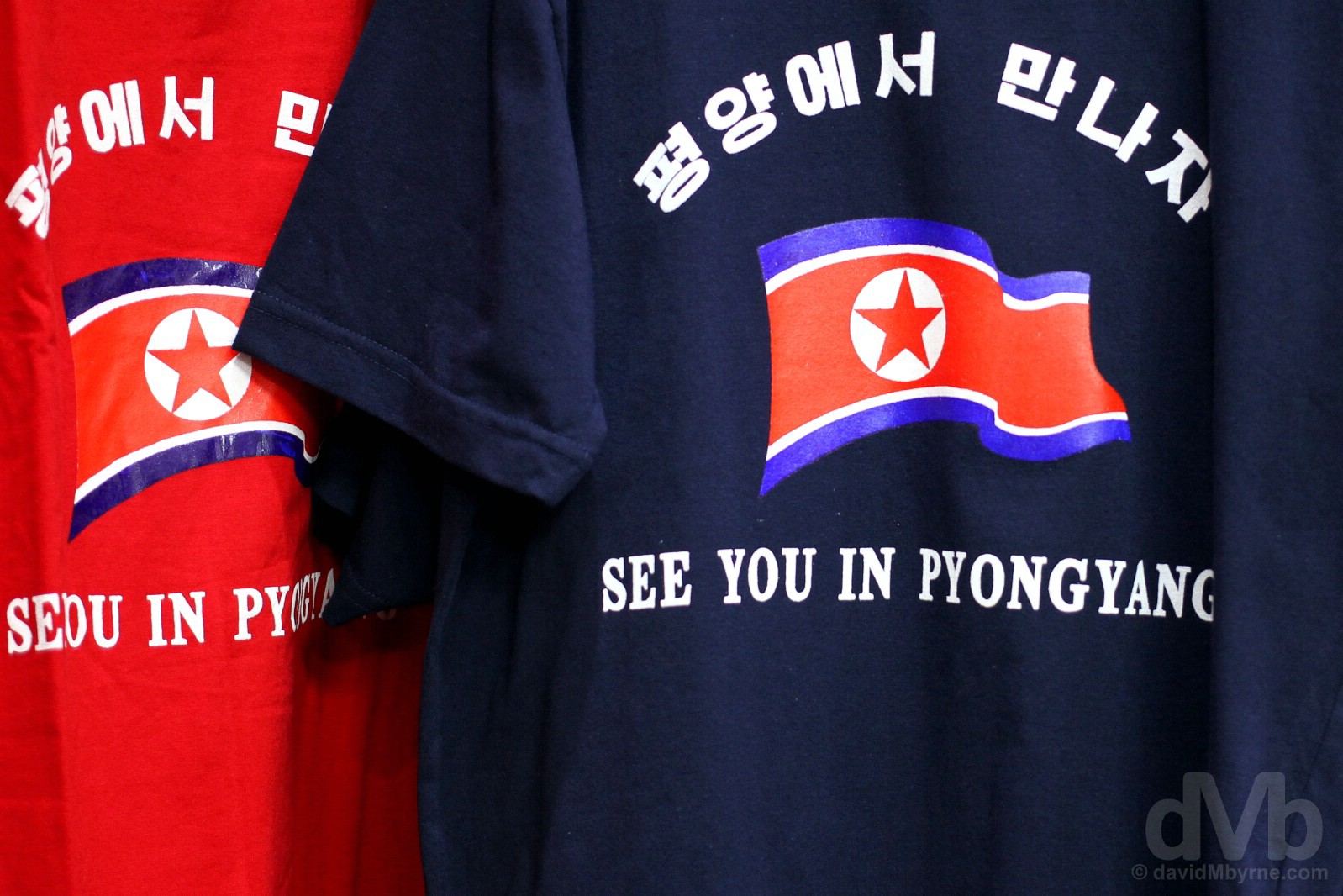
See you there. Pyongyang, North Korea. August 14 2017.
Visits – August 2017.
Selected North Korea Highlights
Day 1
Border Formalities, Rural North Korea & The Train to Pyongyang
Pyongyang arrival, Kim Il-sung Square, Good Impressions & The Chongnyon/Youth Hotel
Day 2
Mansudae Fountain Park & Mansudae Hill Grand Monument (The Kim Dynasty & Cult)
Foreign Language Bookstore & Street Scenes
Highs I – Arch of Triumph (Pyongyang cityscape & The Ryugyong Hotel)
Monument to Party Founding & Cultural Exhibition Centre
Highs II – Juche Tower (Pyongyang cityscape & Rungrado 1st of May Stadium)
Day 3
– Pico Iyer, travel writer
Day 1 - Border & The Train To Pyongyang
“I was… taken aback by the unexpected beauty of the North Korean countryside, joking more than once that maybe, just maybe, it was all staged for our benefit…”
IMAGE || A manned sentry post by the side of the tracks as seen from the train to Pyongyang. August 14 2017.
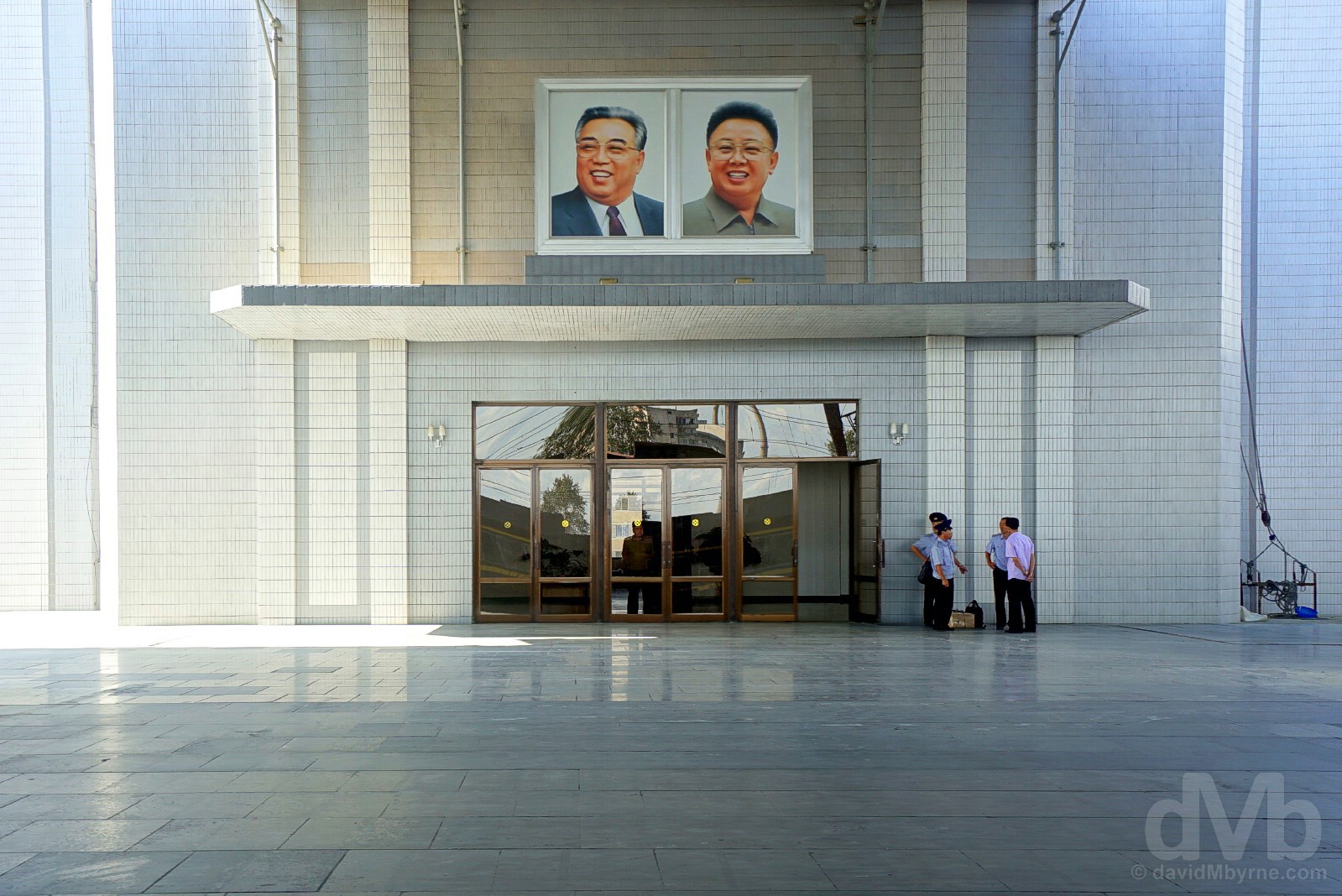
DAY 1 10:38 – FIRST GLIMPSE – Arriving on the platform of Sinuiju train station, northern North Korea. August 14, 2017.
First Glimpse
When the above, my first glimpse of the ever-present portraits of a smiling Kim Il-sung (left) & Kim Jong-il (right), rolled into view as we were coming to a stop on the platform of the train station in Sinuiju, the North Korean town across the Sino-Korean Friendship Bridge from Dandong, the realisation that I was in North Korea hit home. It was neat moment, one of those will-live-long-in-the-memory travel experiences. The station itself was boxy & spartan but polished, much like everything else I was to be shown over the proceeding days. Seemingly I shouldn’t have photographed the dead but very much still revered leaders. Respect and rules, rules and respect… yada yada yada. It might have been before or after this moment – or both, I can’t quite remember – when we were briefed on the dos & don’ts of brandishing a camera in North Korea (oh, & we also practiced how to bow properly… in the departures hall of Dandong Train Station some hours earlier… honest). In hindsight it seemed unnecessary as by and large photography restrictions were few, completely unenforceable, or sidestepable where they did exist, much to my pleasant surprise. I always do, but I especially loved the latest photography challenge the North Korea provided.
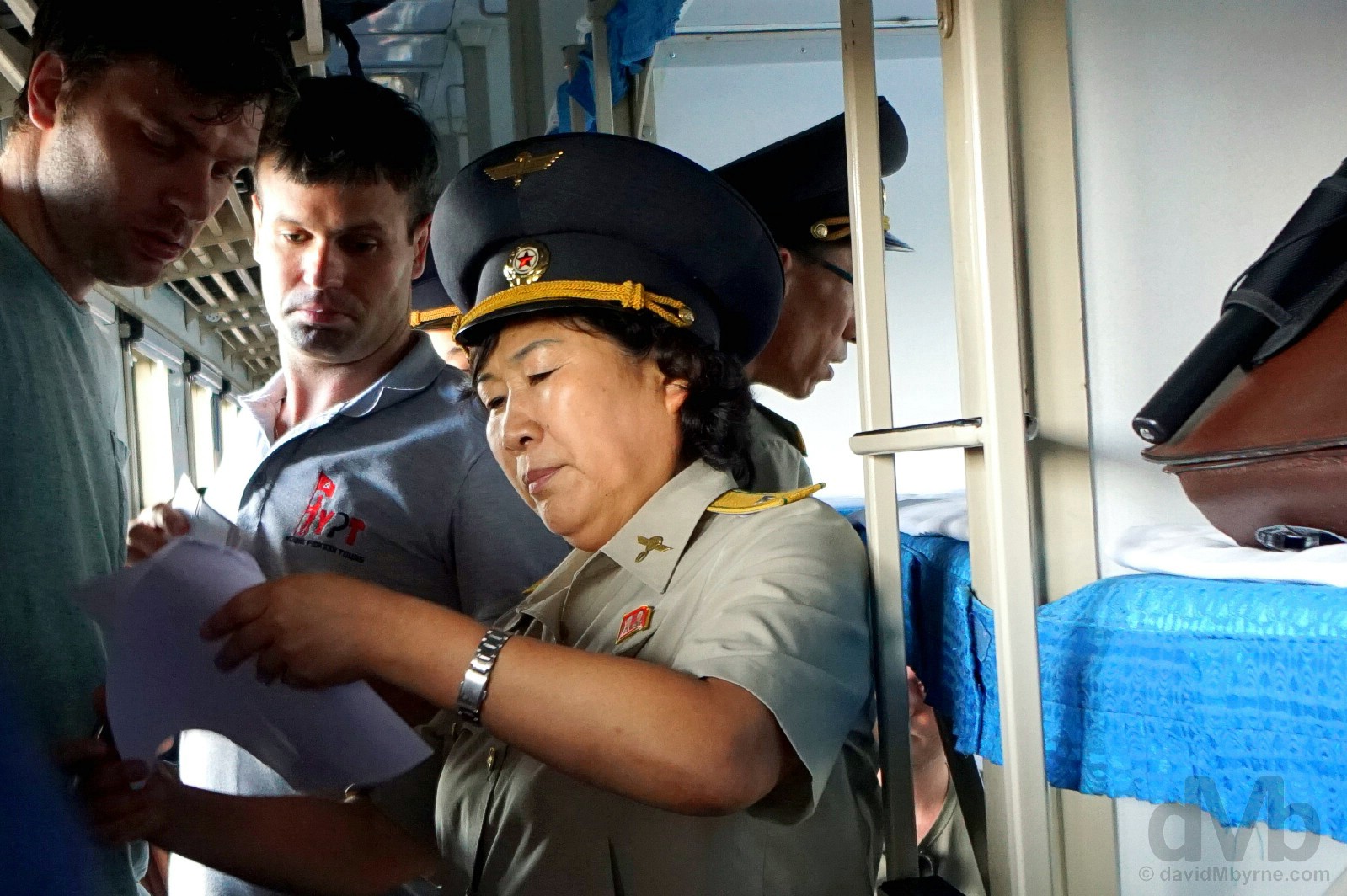
DAY 1 10:52 – BORDER FORMALITIES BEST BEHAVIOUR – Document checks on board the daily number 95 train from Dandong, China to Pyongyang in Sinuiju station, northern North Korea. August 14, 2017.
Border Formalities Best Behaviour
Everyone was on their best behaviour, at least initially, when the officials, a lot of dapper officials, boarded the train carriage we were confined to in order to check documents and bags – the mood slowly lightened and the atmosphere became more jovial, more laid-back once it became apparent that the North Korean officials were actually human beings capable of a smile just like the rest of us. And they were obviously used to dealing with diffident foreigners; they knew what they were doing, we didn’t. Some laughs were shared and pictures, although officially not allowed, were conspicuously captured, something that really didn’t seem to bother the officials who noticed (those who bothered to react at all did so in such a way as to halfheartedly wave the cameras away). Will our bags be searched? Most were, mine included, although it really felt more like the need to make an expected fuss rather that a bona fide search for prohibited items (Korea-related literature, pornography, communications equipment etc.). Will they confiscate my zoom lens? Of course not (but they did give it a quick once over… it doesn’t look that ‘professional’). Will they review the contents of camera memory cards? No, although this is more likely to happen upon departure, if it happens at all (it didn’t). Will they find something not to their liking? Not on me, no (paper maps of the peninsula were initially confiscated from Matt, our tour company representative/guide, but eventually returned once common sense prevailed). They noted those carrying mobile/cell phones, at least those who owned up to carrying one via some kind of unspoken honour system; they checked the passenger manifest against anticipated arrivals (they were expecting us); they did their searches; and they took off with our Tourist Cards (a.k.a. visas, which we’d only received/seen for the first time some two hours earlier during the initial group rendezvous in Dandong Train Station) and passports, dozens of them piled high. After that we didn’t really know what to do. We waited, espying real North Koreans, pretty & healthy-looking North Koreans, on the platform outside the carriage. I don’t know why but that sight surprised me and I remember commenting to myself how North Koreans looked just like South Koreans, until I reminded myself that that are, of course, the same people. There’s an unwanted 4-kilometre-wide, heavily fortified Demilitirized Zone separating them, not a continent.
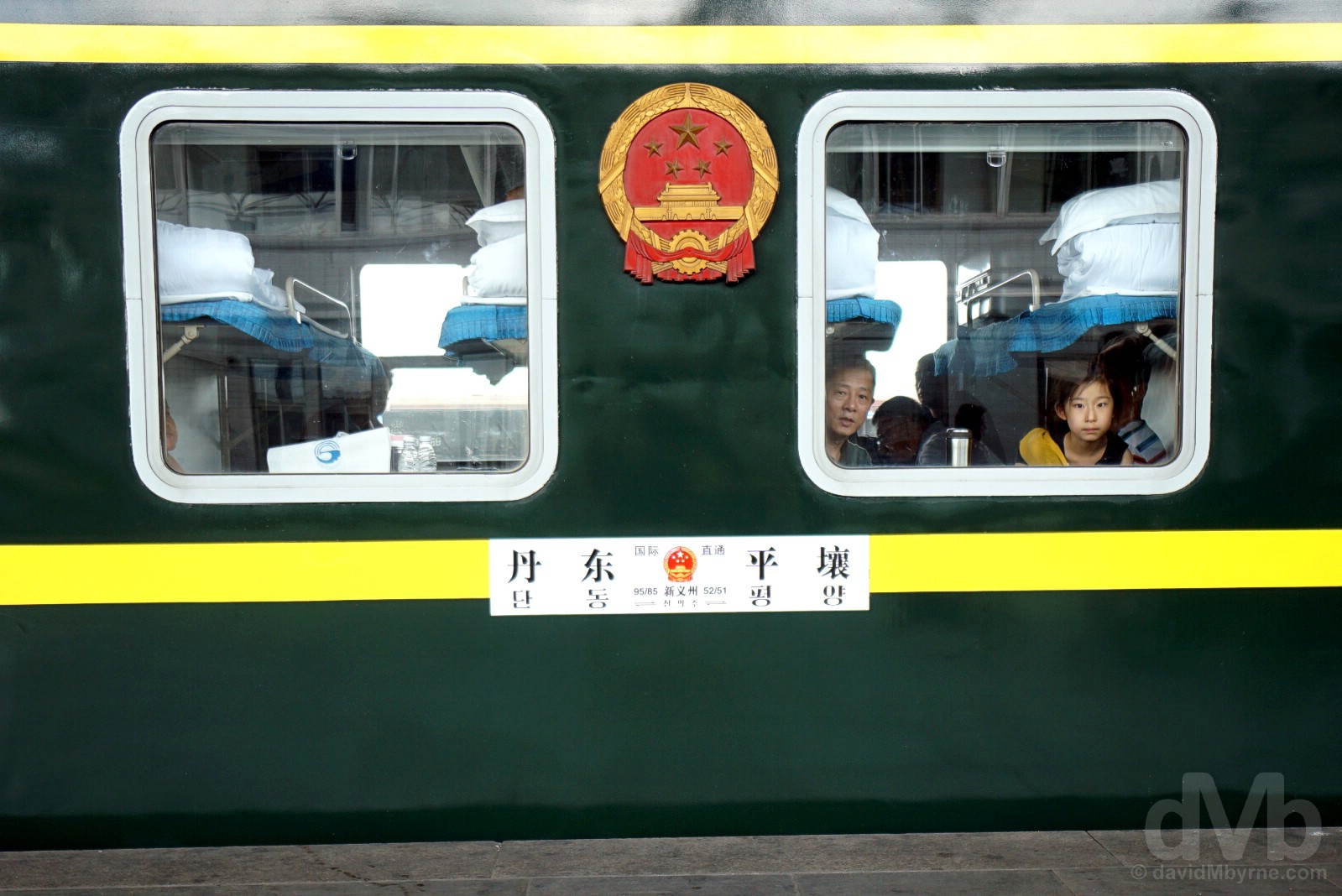
DAY 1 11:35 – THE WAIT – Aboard the daily number 95 train from Dandong, China to Pyongyang train as seen from the platform of Sinuiju train station, northern North Korea. August 14, 2017.
The Wait
With the train going nowhere, no one seemed to know if we could get off or not. No one dared, not until we were told we could. We were – told we could – so we did get off eventually. Again, and just like on the train, we were initially on our best behaviour off the train, sheepishly taking our first steps on North Korean terra firma – it felt like pushing boundaries by taking those first steps away from the familiar confines of the carriage, where we knew we were unlikely to ruffle any feathers. We eventually returned to the carriage to get our luggage to facilitate yet another bag check, this one on the roomier platform. Leaving our bags behind, we got back on train again, this time to collect our passports. We got off one more time to continue the wait before eventually transferring to a different carriage for the 5-hour journey to Pyongyang, a carriage added to the train while we waited and a carriage that was earmarked to transport only us foreigners (there were at least three tour groups on this day en route to Pyongyang). Pictures were not allowed on the platform of the station, but I captured a few regardless including this one of passengers happy to wait out the formalities by staying on the train; the majority of the train’s passengers were returning North Koreans and visiting Chinese, but it seems only foreigners are required to disembark. And embark. And disembark. And embark.
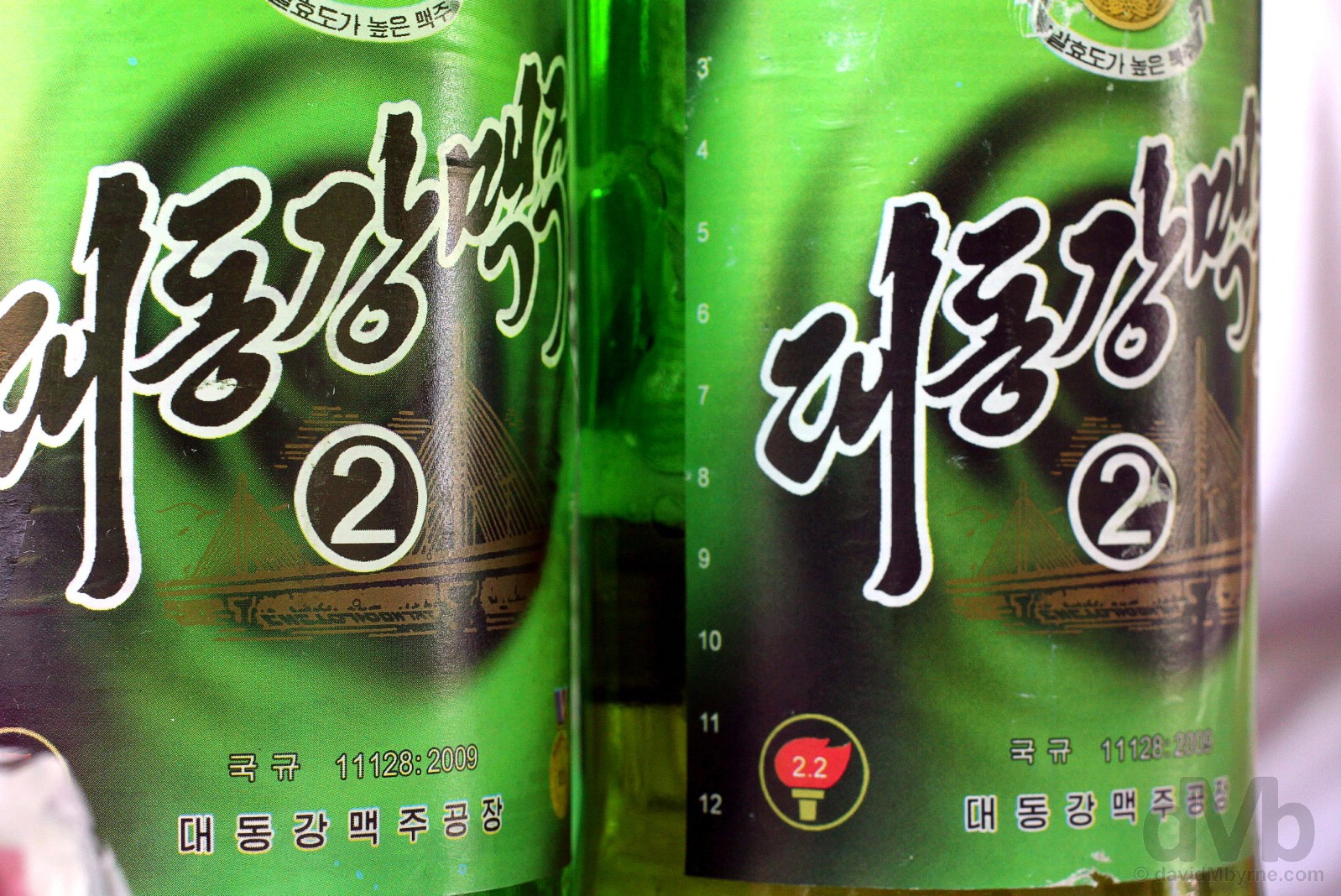
DAY 1 14:30 – TAEDONGGANG #2 / (NORTH KOREAN) BEER – Taedonggang #2 on the daily number 95 train from Sinuiju to Pyongyang, North Korea. August 14, 2017.
Beer. North Korean beer. By all accounts North Koreans like their beer, Taedonggang #2 being the preferred option among them because, I assume, it’s the one that’s most widely available. An eminently drinkable lager (when chilled), it’s cheap, even at the vastly inflated foreigner price of CNY10 (€1.30) for a 600 ml bottle, but a little inconsistent and has a tendency, at 5%, to cause both amnesia & pain in that order.
Border Beers
All in all, the border & customs procedure took about 3 hours, 3 hours of waiting and 3 hours of not really being sure what was going on, a situation everyone was more than happy to roll with (what choice did we have?). Everything felt relaxed and beers were had on the platform to pass the time, the chilled ones selling out from the trolley lady in double-quick time; fresh stocks were needed and arrived promptly, but none were chilled. And once the seal was broken on the platform the beers invariably kept flowing when on the train, too. I didn’t know it at the time but North Korea was to turn into quite the party.
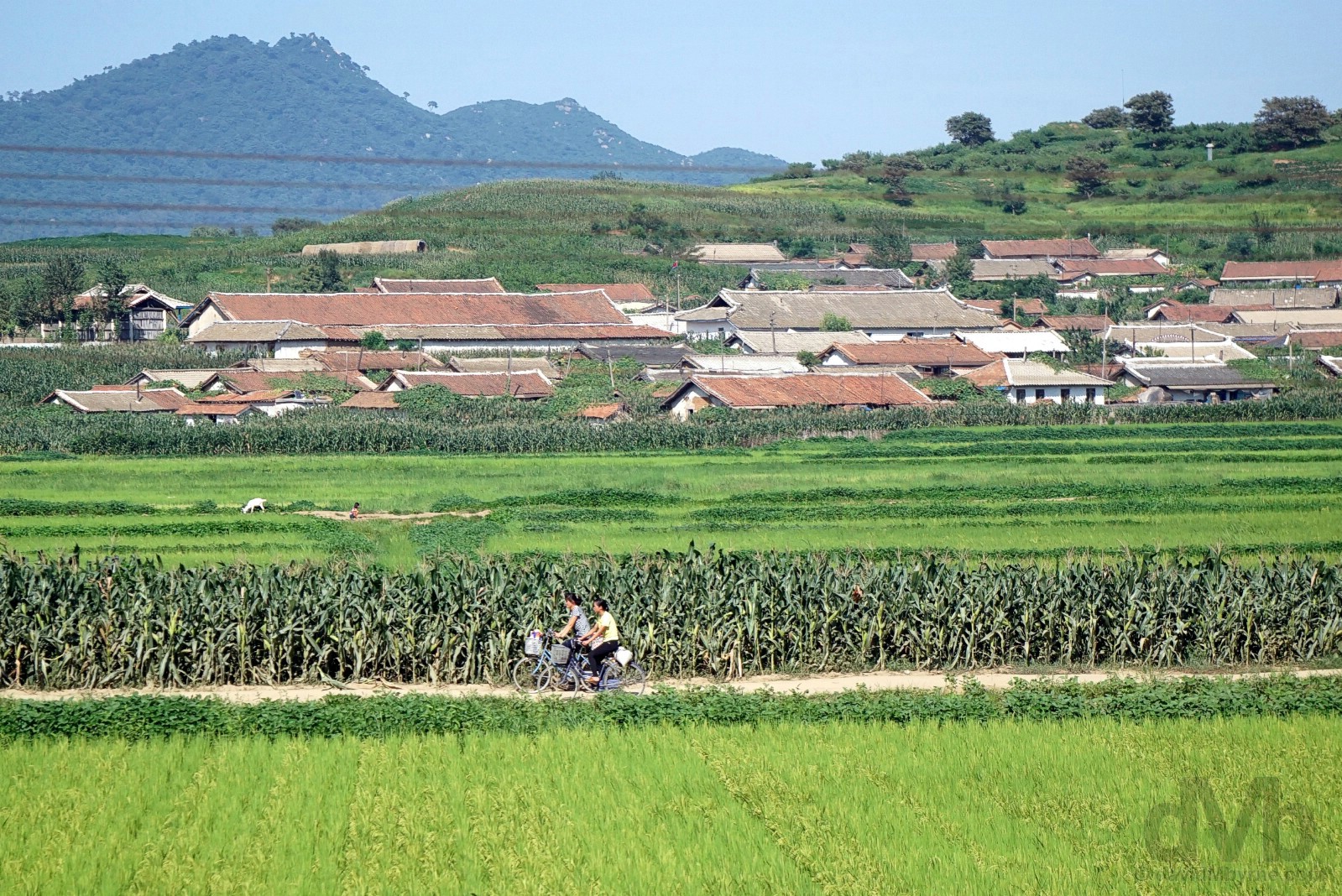
DAY 1 15:15 – RURAL/REAL NORTH KOREA & COOPERATIVE FARMING – The northern North Korea countryside as seen from the daily number 95 train from Dandong, China to Pyongyang, North Korea. August 14, 2017.
I was, and as were others, taken aback by the unexpected beauty of the North Korean countryside, joking more than once that maybe, just maybe, it was all staged for our benefit (the blue skies I hadn’t seen in China over the previous few days did nothing to hurt North Korea’s cause on this day). It was very rural, very green and very, very picturesque – the western coastal plain landscape from the border with China all the way to Pyongyang, a distance of some 230 kilometres and a vital region for farming and crop production in the largely mountainous country, appears as one continuous landscape of tidy crops and immaculate farmland. North Korea’s model of self-sufficiency relies heavily on cooperative farming to feed the population. This over-reliance coupled with torrential flooding, droughts and restricted Soviet food-aid contributed to the 1994-1998 humanitarian crisis that was the North Korean famine, a catastrophe which resulted in death for countless North Koreans (Wikipedia estimates anywhere between 240,000 to 3.5 million) – the state-coined term “Arduous March” became a metaphor for the disaster following a state propaganda campaign to deflect responsibility for the failure to prevent widespread hunger. This picture sums up the striking landscape for me – simple low-rise dwellings, dirt roads, greenery, peasants working the land, oxen, herded livestock, a total absence of rubbish (no consumerism as we know it means nothing to discard) and people on bicycles (there were few buses and even fewer cars to be seen).
Real North Korea?
Sinuiju is connected to Pyongyang by the 225-kilometre-long Pyongui Line, the main corridor for overland traffic between North Korea and China and the country’s most important rail line. I spent a large portion of the 5 hours it took to cover that distance standing between carriages and peering out the (closed) windows, camera always in hand and viewing what I knew I’d never get any closer to, that being real North Korea, the North Korea foreigners would never get to see in person. While obviously rural, it all looked very normal. Simple, but normal. From my brief & restricted view of the North Koreans and their way of life, I didn’t pity them. Not one bit. They know of no other and yes, it appears to be a hard life, one with few comforts and a life void of material luxuries. But I’d imagine the North Koreans also live a simple life with few, if any, of the modern-day worries that beset people like me, people fortunate enough to be able to come here from various corners of the globe to gawk at the North Koreans in an attempt to develop an appreciation for their secretive way of life.
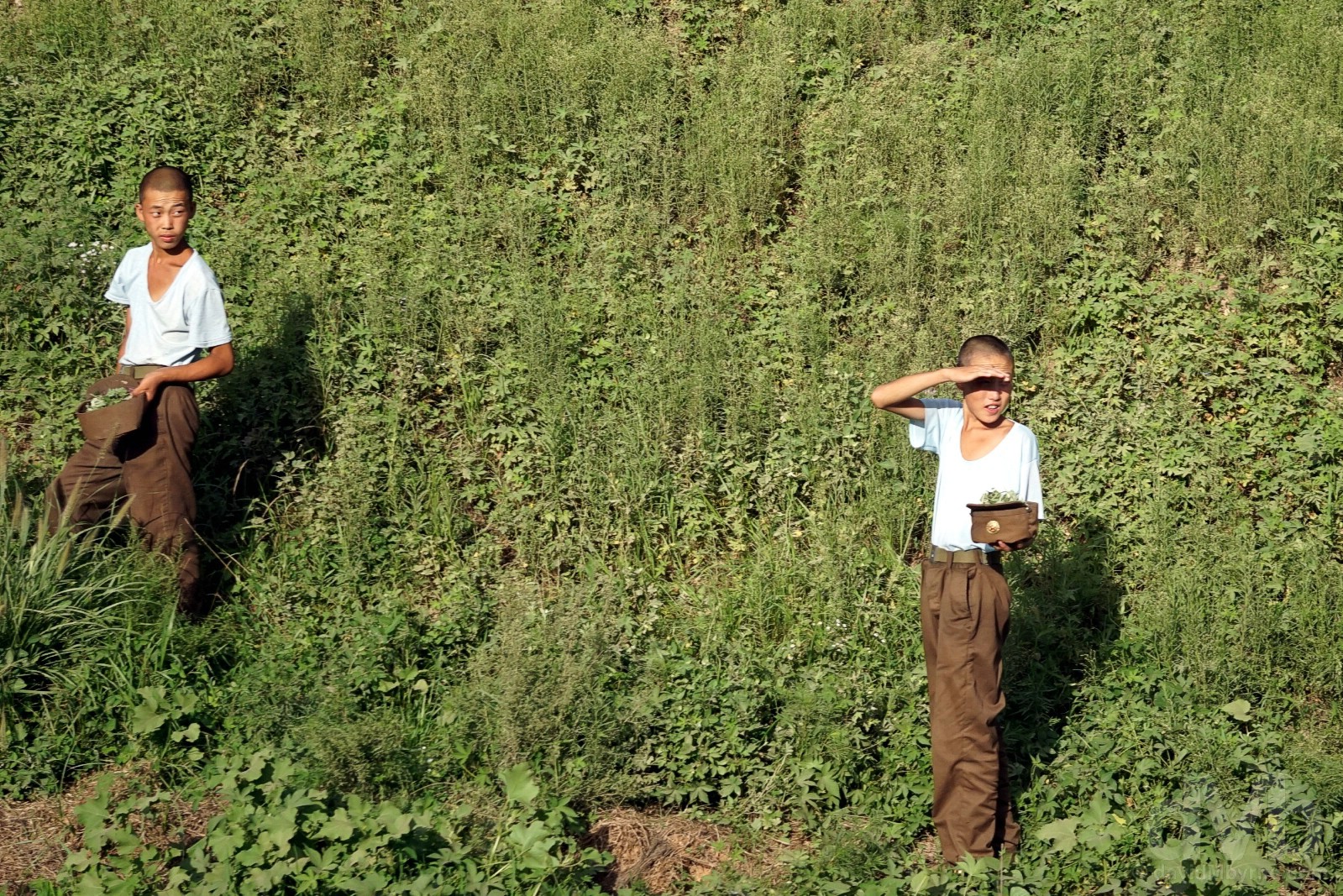
DAY 1 16:55 – GAUNT – As seen from the daily number 95 train from Dandong, China to Pyongyang, North Korea. August 14, 2017.
Two of many similarly dressed male adolescents (it’s really hard to guess their ages) doing something as a collective by the side of the tracks (gathering some greenery into their hats by the looks of it), one of which is shielding his eyes from the late afternoon sun as the train trundled past. I remember commenting how gaunt they looked.
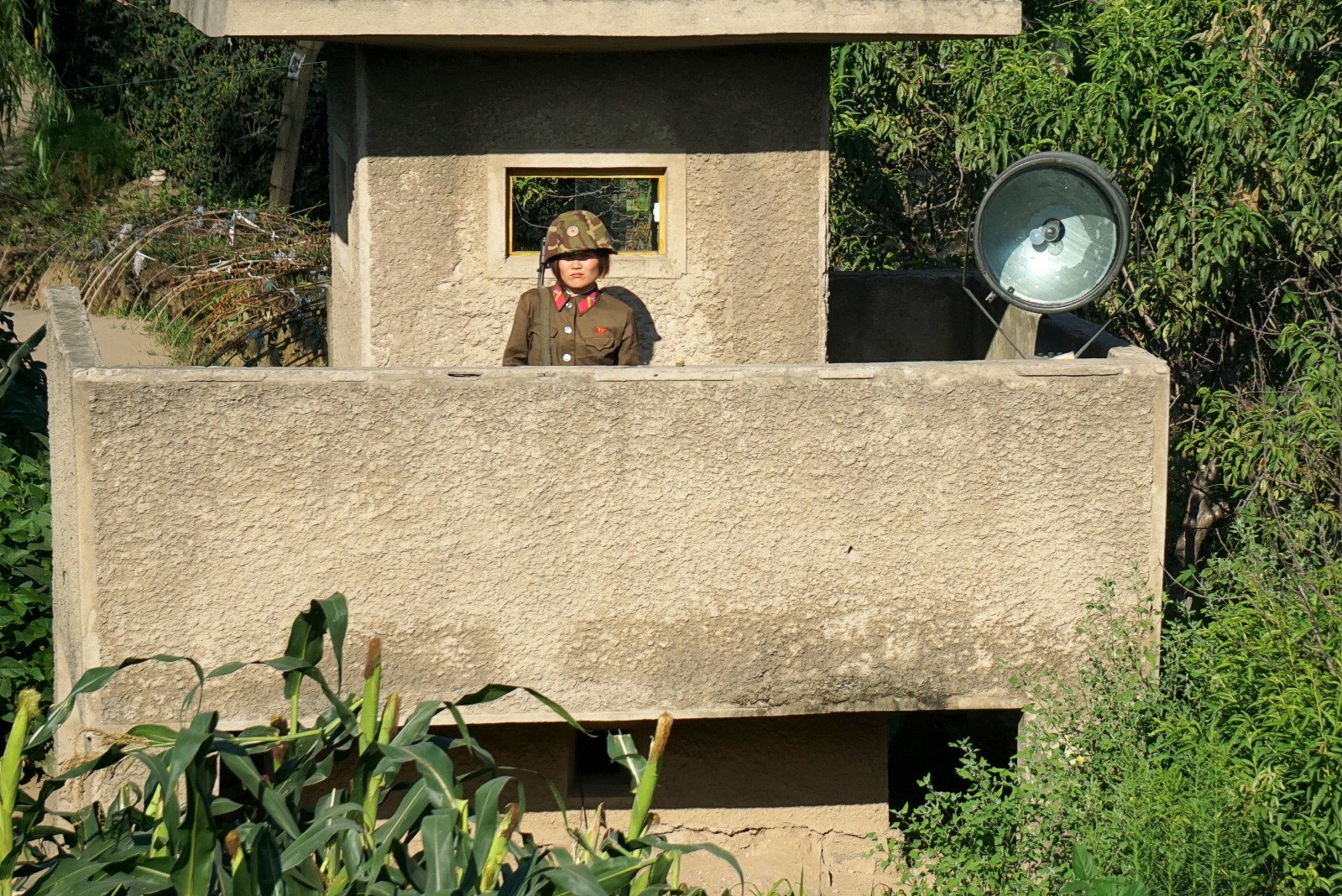
DAY 1 16:30 – SENTRY POST – As seen from the daily number 95 train from Dandong, China to Pyongyang, North Korea. August 14, 2017.
The beautiful countryside was ever-present, but every so often we’d pass a rudimentary manned sentry post by the side of the tracks. The posts seemed spaced a similar distance apart (5 kilometres or so) and were always positioned a few hundred metres either side of a rail bridge. The proximity of the posts to the tracks and the inability to see them until just before they flashed by meant capturing this scene from behind the dirty windows of a moving train was a challenge, one I eventually rose to here, about an hour out of Pyongyang, having been frustrated at numerous sentry posts up to this point. I’m not sure if the soldier stands there all the time or only when the train passes (judging by the expression on her face I’m guessing the former). One of my favorite captures from the trip, this is my pictorial highlight of Day 1 in North Korea.
Some more captures as seen from the train en route to Pyongyang.
Songun - Military First
North Korea adopted Kim Jong-il’s Songun (military first) policy, meaning expenditure (a whopping 25% of the impoverished nation’s GDP), allocation of resources and all matters of national affairs are wholly prioritised towards the interests of Korean People’s Army. A policy of f’d up priorities, it means tanks before teachers, nukes before nurses. North Koreans are rather proud of having one of the largest active military forces on earth (the 4th largest after neighbouring China, the US & India, but easily the world’s largest as a percentage of population). It has an estimated active duty military force of up to 1.2 million personnel (about one in five of all men aged 17-54 are in the regular armed forces where standards of training, discipline and equipment are reported to be low) with a total of 9.5 million active, reserve and paramilitary personnel (that’s a lot of cannon fodder). Needless to say, chest-beating militarism pervades everyday life, both men and women indoctrinated early into accepting a strong military influence as a normal part of their everyday existence. For men, military conscription is a testing 11 years, the longest of any country on earth.
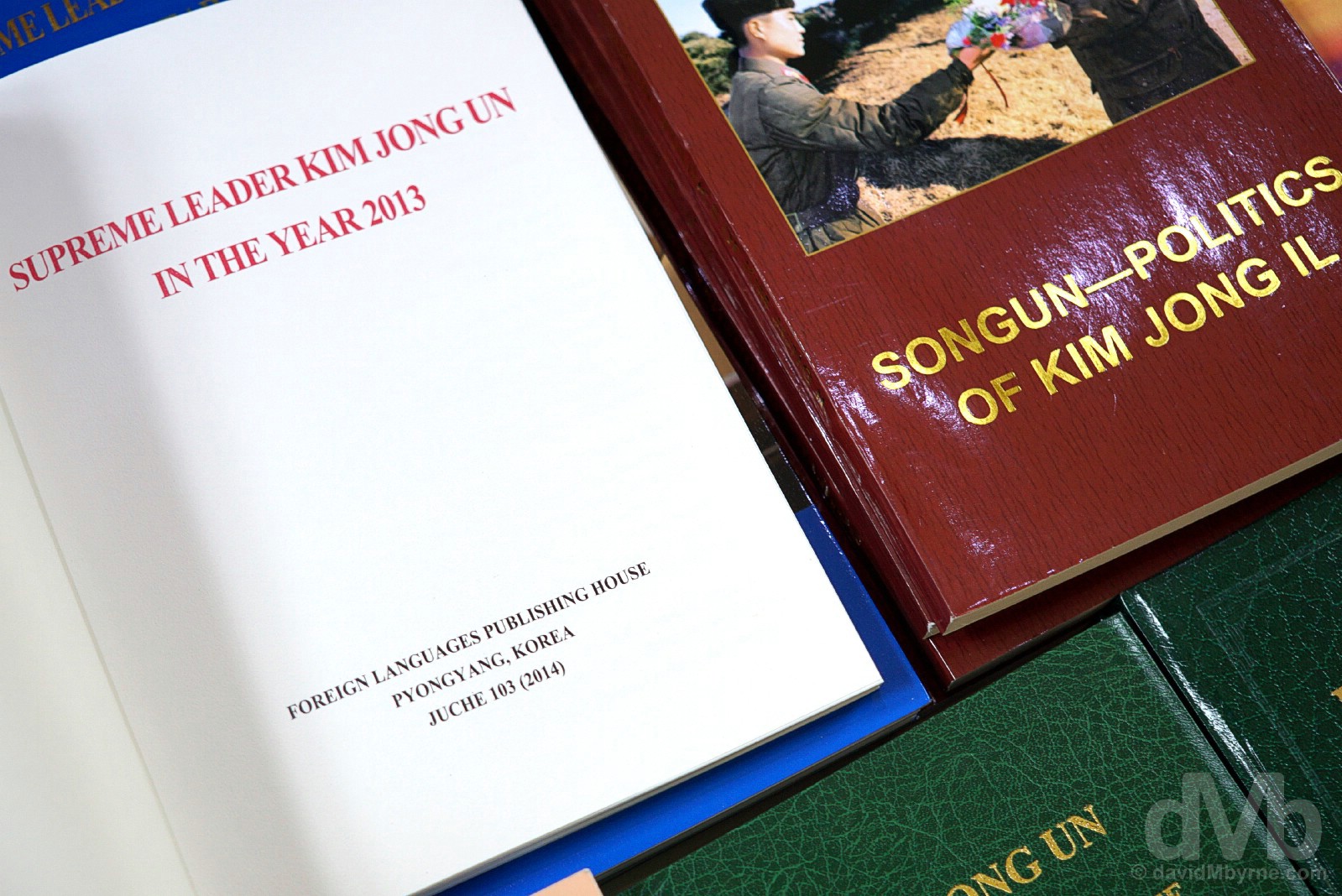
The Songun bible, the Politics of Kim Jong-il, Cultural Exhibition Centre, Pyongyang, North Korea. August 15, 2017.
Day 1 - Pyongyang
“…a curious & visually unique Soviet-era project in urban regeneration… it’s North Korea’s showpiece, only the very best of which is seen by visiting eyes…. an Asian city like none I’ve ever experienced before and, where Pyongyang is concerned, it’s definitely a case of you need to see it to believe it.”
IMAGE || Dusk in Kim Il-sung Square in central Pyongyang. August 14 2017.
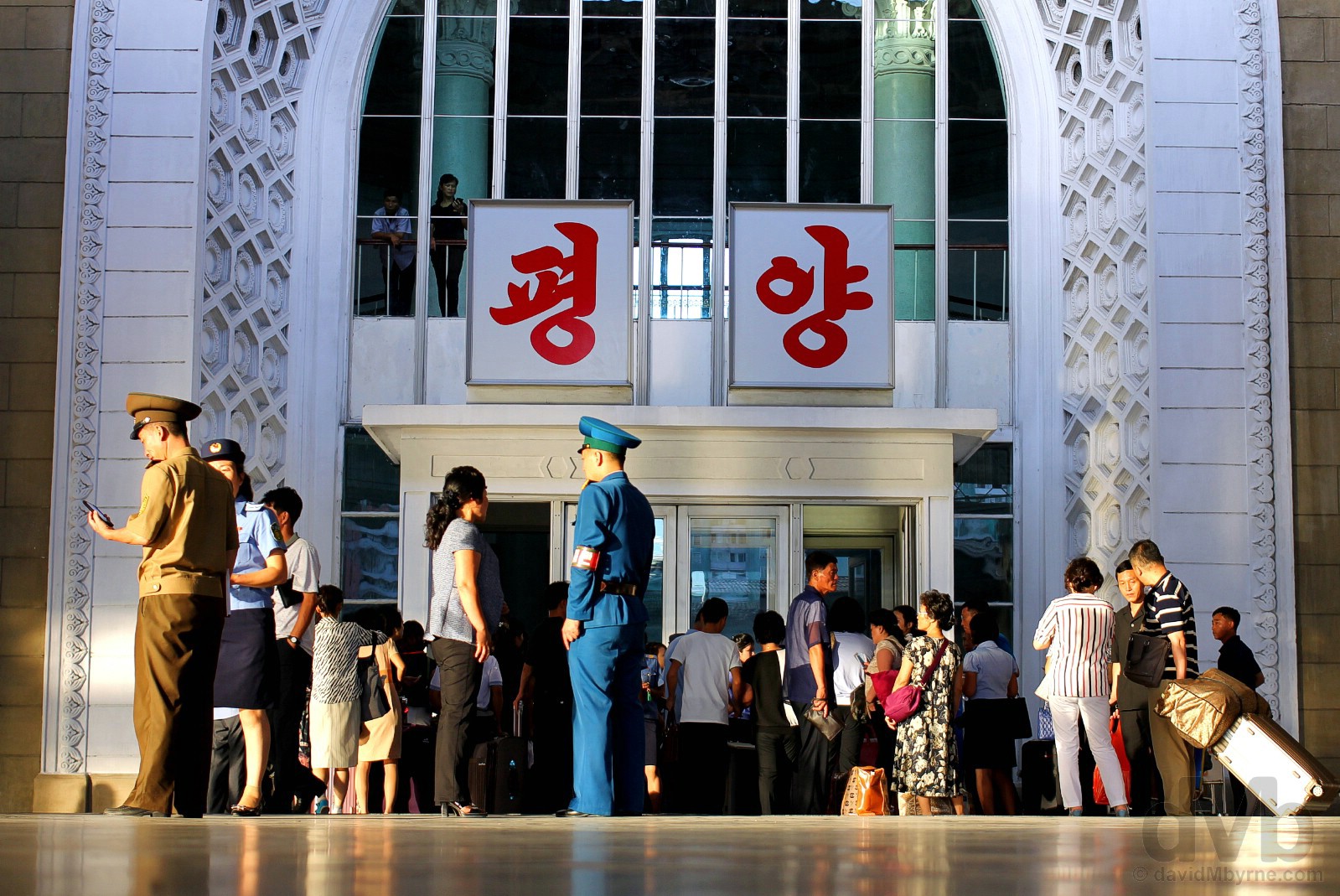
DAY 1 17:45 – PYONGYANG STATION – On the platform of Pyongyang Station, Pyongyang, North Korea. August 14, 2017.
Eight hours after leaving Dandong in China and we finally rolled into Pyongyang. Stepping off the train in Pyongyang Station, the southern terminus of the country’s Pyongui Line and North Korea’s railway hub, was just the latest surreal moment of this day (and for some reason I was reminded of another surreal train disembarkation in another far-flung, off-the-beaten-path location some years earlier, that being in Lhasa, Tibet). Platform 1 of the 5 platform station, first built in the 1920s and rebuilt in 1958 in typically Soviet style, was alive with people dispersing and going on their merry way. Again everything felt very normal, the platform itself – curiously absent of leader, dead or otherwise, portraits (they, of course, adorn the external facade of the station) – was another expansive and polished space the type of which I was fast getting used to. It shined and looked great in the late afternoon sunlight; the lighting was magical and a great welcome to Pyongyang.
Ha & Yang – Our North Korean Guides
We were met off the train by our primary guide, Ha (her name is a tad more convoluted but for simplicity we were requested to address her as Ha). Of course we were; as a sine qua non of any visit to the secretive Hermit Kingdom, we weren’t going anywhere without her and her male colleague, Yang, whose name escaped me upon initial greeting. Yang, the more approachable of the two in my eyes, rarely divulged Pyongyang titbits, Ha doing the majority of the talking, her English impeccable but delivered in a somewhat annoying accent (gosh, the things that grate me). Two guides. Two sets of government eyes. Always.
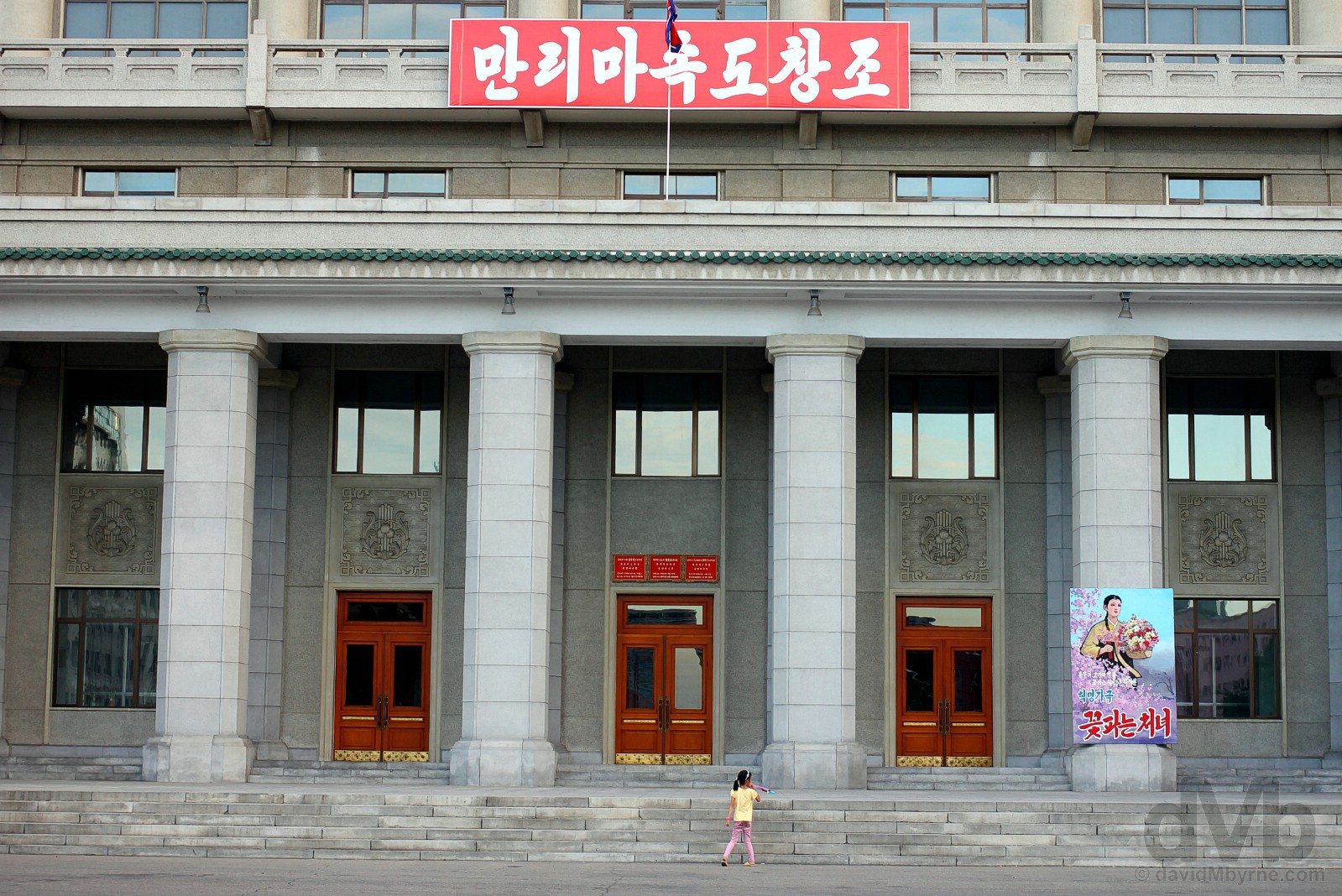
DAY 1 18:00 – GRAND THEATRE – Fronting the Grand Theatre in Pyongyang, North Korea. August 14, 2017.
Our first stop in Pyongyang was the vast space fronting the 1960 Grand Theatre, the first of many impressively boxy city edifices we were to become acquainted with over the course of our visit. There wasn’t a whole lot happening here, a nearby parked van blaring revolutionary music and chants/slogans distracting somewhat from the spectacle that is the huge facade of the theatre, but conversely adding to the surreal buzz of taking one’s first steps on the everyday streets of Pyongyang, a travel milestone by anyone’s standards but one that seemed to get totally lost in the brash surrealism of the moment. No one really knew what to make of it (a van whose roof was adorned with many a vociferous megaphone), the first of what was to be many Pyongyang curiosities.
Pyongyang Detours
It’s a short drive from Pyongyang Station to the Grand Theatre, although for us it was longer than it should have been. A distance of a little over a kilometre at its most direct (via Yonggwang Street), the bus decided to go the scenic route via the banks of the city’s Taedong River instead. Maybe this was to allow Ha more time on the introductory mic, but it – taking the roundabout way between points A & B – was to happen more than not during our time in Pyongyang, something I’d imagine only those cognisant of their surrounds would pick up on. Questioning Matt, our tour company representative/guide, about this on Day 2, I was told I wasn’t imagining it and that it was probably because some roads, and/or the views they provide, are not suitable for foreign eyes, but I suspect it was also done in a bid to give the impression of compact Pyongyang being larger than it actually is – in North Korea bigger is always better, the biggest always the best, as you soon come to appreciate on a visit here.
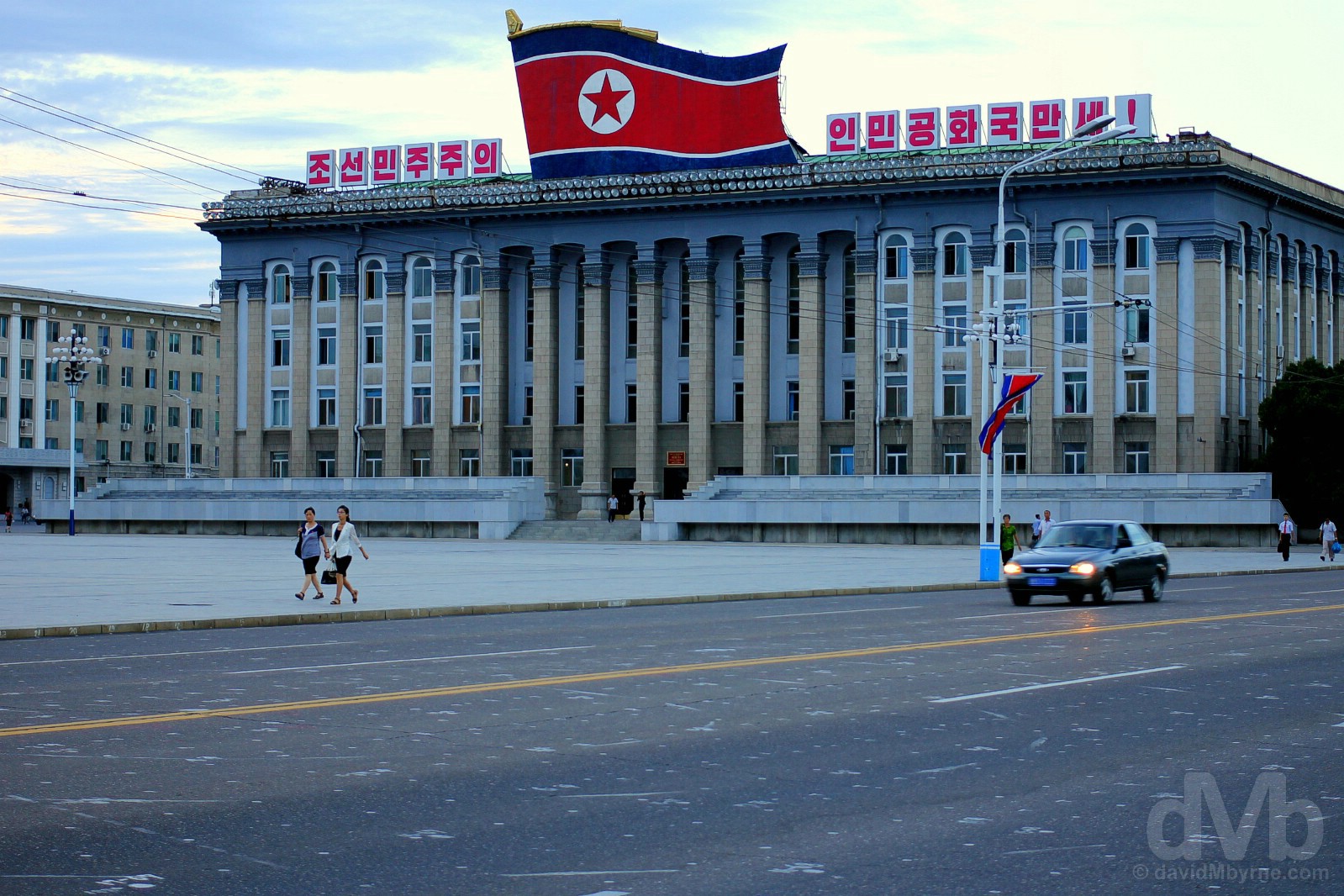
DAY 1 18:20 || Kim Il-sung Square, Pyongyang, North Korea. August 14, 2017.
Liberation Day Eve
The 1-kilometer saunter down an almost deserted Sungri Street from the Grand Theatre to Kim Il-sung Square didn’t take long. I didn’t know that to expect, but I wasn’t expecting to be walking the streets of Pyongyang this evening and wasn’t quite sure what to make of it when in the moment; it was like, and even allowing for all the pre-trip anticipation, that Pyongyang snuck up on me. But again it all felt very normal, the dearth of people on the streets at this time of the day an obvious observation. I spoke a few words with Ha, questioning the city’s plans for tomorrow’s festivities (August 15 is Korean Independence Day, or Liberation Day as it’s known in North Korea). She didn’t divulge much or genuinely didn’t know details I assumed would be common knowledge, especially to a government tour guide. I got the impression Independence Day isn’t as big a deal here as it is south of the border (and as it turned out it wasn’t any kind of deal at all).
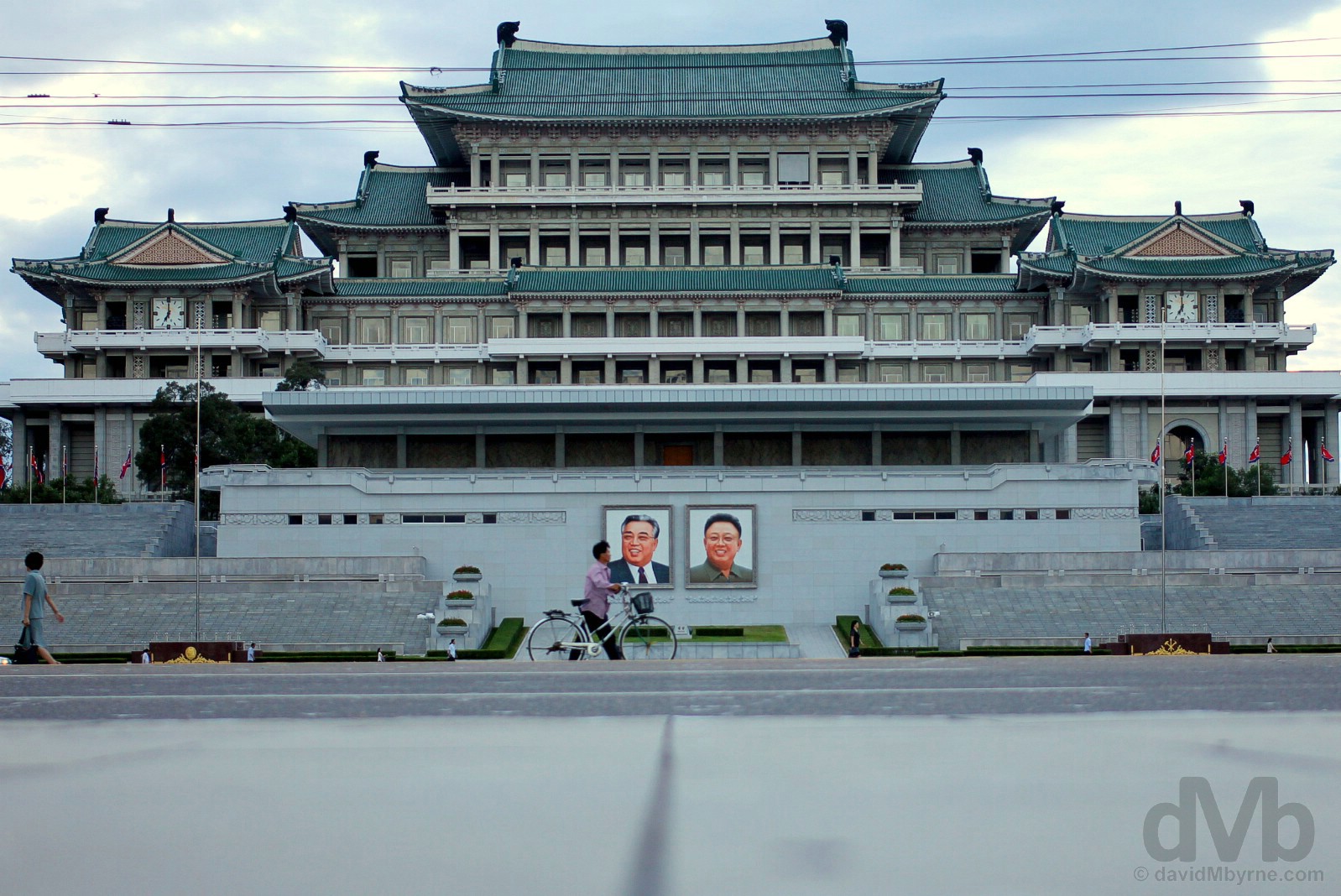
DAY 1 18:30 – KIM IL-SUNG SQUARE & THE GRAND PEOPLE’S STUDY HOUSE – The Grand People’s Study House as seen from across the expanse of Kim Il-sung Square in Pyongyang, North Korea. August 14, 2017.
The sun well since gone, it was dusk and very blue by the time we reached Pyongyang’s central Kim Il-sung Square, North Korea’s very own Red Square named after the state’s revered founding father, Kim Il-sung. Highly choreographed (colour-coded dots & markings on the ground dictate where participants must stand for maximum visual effect), high-stepping & propaganda-heavy parades demonstrating the DPRK’s military capabilities broadcast from this location give the impression of a space that’s much bigger than it actually is. Still an impressive expanse and one of the largest public squares in the world, the 75,000m² square, built in 1954 as part of the post-Korean War rebuild of the city, can accommodate 100,000 people. Surrounded by a number of government buildings, including the Supreme People’s Assembly, North Korea’s parliament, the square is dominated by the impressive hulk of the Grand People’s Study House. The 600-room building was built in traditional Korean style in 1982 to commemorate Kim Il-sung’s 70th birthday (a lot of Pyongyang landmarks were built to commemorate this event, as I was to discover). Serving as the city’s central library & with computer rooms providing access to the North Korean intranet, it’s very own ‘private internet’, it is said that the building holds 30 million books (any one of which can be delivered by an impressive system of conveyor belts) including many works by still dead and still highly revered leaders – it is a national centre for studies on Juche, or ’self-reliance’, the North Korean Confucianist-tinged communist ideology developed by Kim Il-sung as distinct from neighbouring Chinese & Soviet ideologies. Needless to say, massive portraits of both Kim Il-sung, the Great Leader, and Kim Jong-il, the Dear Leader, are displayed on the facade of the building overlooking the square, portraits that tower over the tiny mere mortals that pass in front of the building.
Coffee, The Chinese, Dinner & Good Impressions
The bus was waiting for us just off the square and just opposite the Ryongwang Coffee Shop, a joint venture project set up by Austrian investors in partnership with North Koreans & seemingly the best place in Pyongyang for a coffee (it was closed when we were in the vicinity). Dinner followed, hotpot in a foreigners-only restaurant that was already busy with a large Chinese contingent (as I know all too well, the f**kin’ Chinese are everywhere, even where you least expect them and especially here in North Korea, making up about 90% of the estimated 100,000 foreigners a year that visit the country). The food and service was as expected – good and attentive (they were prompt dealing with my request for extra onions) notwithstanding the restaurant’s penchant for so-called watery kimchi, a new one on me. The first beer was free, subsequent tipples priced at CNY10 (€1.30). I forget how much the soju was. It was a good time and I remember thinking that if the North Koreans are trying to make a good impression – and of course they are, that’s the whole point – then they are going the right way about it.
We were late – 21:30 – getting to our hotel; North Korean tours, especially one as packed and brief as this one, start early and end late in the day. The Chongnyon Hotel, a.k.a. The Youth Hotel, is located in the city’s Mangyongdae District, one of Pyongyang’s 19 districts. It’s a bit out of the way, purposely I assume, the roads noticeably bumpier on the city’s fringes than in its showpiece centre. Boasting hundreds of rooms spread over 30 floors, we were assigned, again purposely I assume, ear-popping rooms on the 28th & 29th floors, those furthest from the door. I was amazed to discover the room provided foreign news channels; watching an English language RT (Russia Today) report on the present tensions between Washington & Pyongyang over the latter’s on-going nuclear and ballistic missile ambitions while actually in North Korea was a moment I’ll not be forgetting in a hurry and just the latest in a string of unforgettable moments on this particular day.

CHONGNYON/YOUTH HOTEL – Captured on the last morning of the tour, the polished, shiny and reflective lobby of the Chongnyon Hotel, a.k.a. The Youth Hotel, in Pyongyang, North Korea. August 16, 2017.
Opened in May 1989 and boasting a swimming pool (US$5 a swim), a sauna, a massage room, a karaoke room and a bar, the Chongnyon is a first-class rated hotel meaning it offers some of the best rooms on offer to foreigners in North Korea. The rooms were much like the hotel itself – spartan, dated and worn but functional. Not all the light switches worked, even fewer of the sockets, the beds were firm and the hot water only available between certain hours. We spent little time here, arriving late at night and leaving early in the morning while partying & sleeping, in that order, the majority of the hours in between.
We were told to heed the ‘No Access’ or ‘Staff Only’ signs dotted around the hotel, told not to pilfer anything (Otto who?) and were requested not to leave the hotel, ‘where would we go?’ the obvious retort to that restriction placed upon us. So we had beers in the ground floor bar instead (on night one, karaoke and beers on night two). We drank, discussed the day, played pool and smiled reading the propaganda being spurted by the English language Pyongyang Times. I finished off the night with beers at the bar with Jerry, a fellow Irishman, & Yang (my shout). I liked him. We liked him. He’s just like me. He likes beer, likes a laugh and wants nothing more than to live a happy existence (he’s all for unification as I was to discover during this and subsequent chats). We’re no different at all and under normal circumstances we could be good friends. But North Korea doesn’t do normal circumstances, that much blatantly obvious even after only a few utterly fascinating hours here.
Day 2
“We weren’t exactly in the clouds and we’d get higher on this day, quite a bit higher, but it was here atop Pyongyang’s most famous replica where I first fully appreciated how much of a one-off this city really is; I’ve never seen an urban sprawl like it.”
IMAGE || A portion of Pyongyang as seen from the top of the city’s Arch of Triumph. August 15 2017.
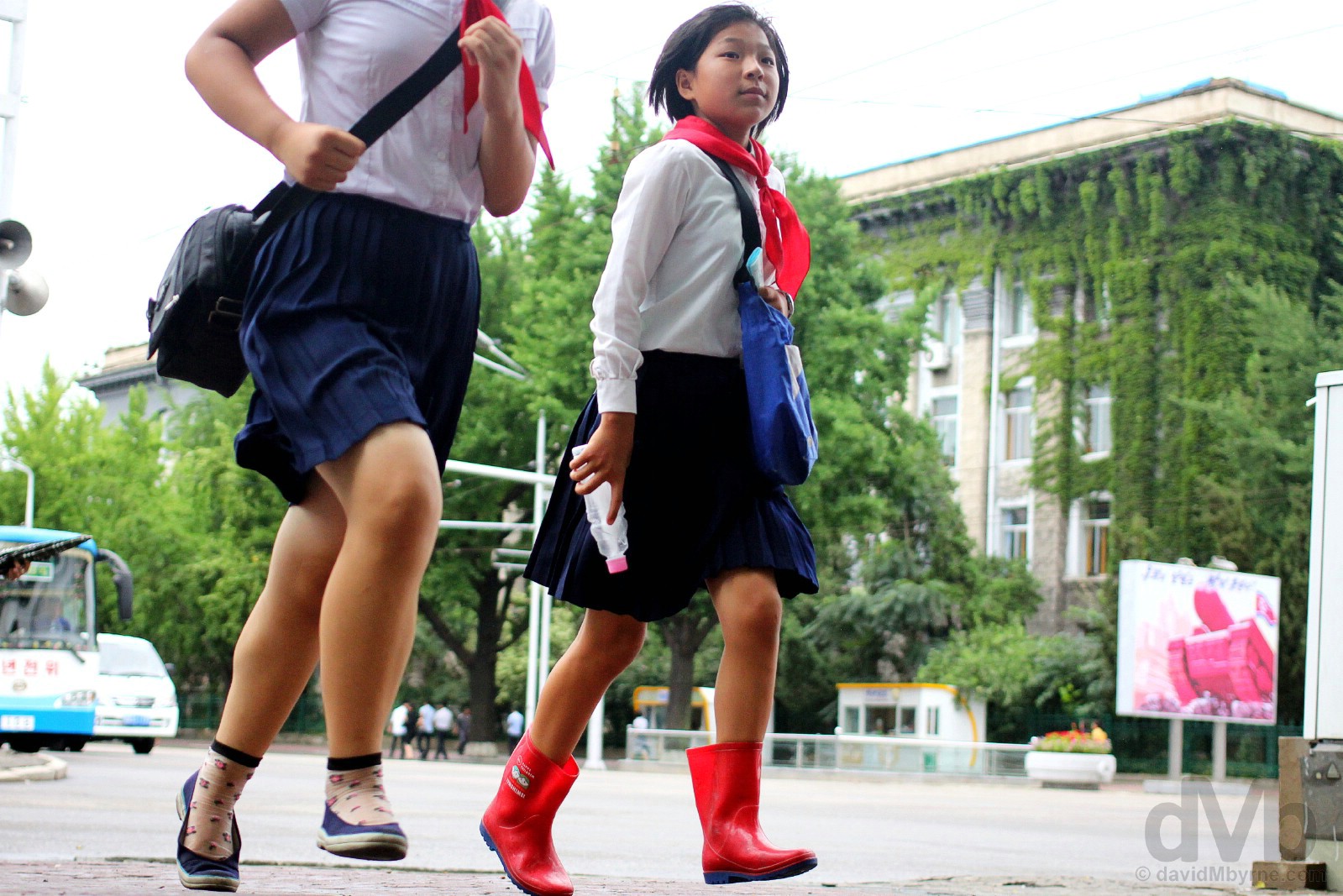
Schoolchildren on Sungri Street, Pyongyang, North Korea. August 15, 2017.
Lots of Pyongyang must-sees were visited on a day when the packed itinerary was as changeable as they come. A day of surreal moments and mammoth monuments, some of the tallest of their kind, the deepest of their kind, and the biggest of their kind to be found anywhere on earth. I dodged the rain while offering up flowers and bowing, sufficiently I hope, to the Great & Dear Leaders at the Mansudae Hill Grand Monument; I walked the Pyongyang streets again; I went shopping, the for-foreigners Foreign Language Book Store cool but the 3-level for-locals department store, where we got to shop among real North Koreans using real North Korean money, infinitely cooler; I rode on and was sufficiently awed by the Pyongyang Metro, as deep as they come; I got sweeping views of the city, first from atop its Parisian-esque Arch of Triumph before going even higher thanks to the pointy & lofty Juche Tower, the physical manifestation of North Korea’s very own not-for-export brand of Confucianist-tinged Communism; I naughtily took photos of photos – photos of leaders, celebrities & controversial missiles – in a Cultural Exhibition Centre (cum museum cum gallery) were taking photos was prohibited; I drank more beer, this time North Korean craft beer in a North Korean ‘bar’; I visited a nighttime amusement park to witness a lot of North Koreans having fun and being nothing but normal; I had dumpling soup (for lunch) and Korean BBQ – lamb, no less – for dinner after which I was treated to an impromptu cultural performance by the restaurant waitstaff; and the day, and night, was rounded off a singing to the each other in the hotel’s noraebang (karoke room). Lots done, lots captured.
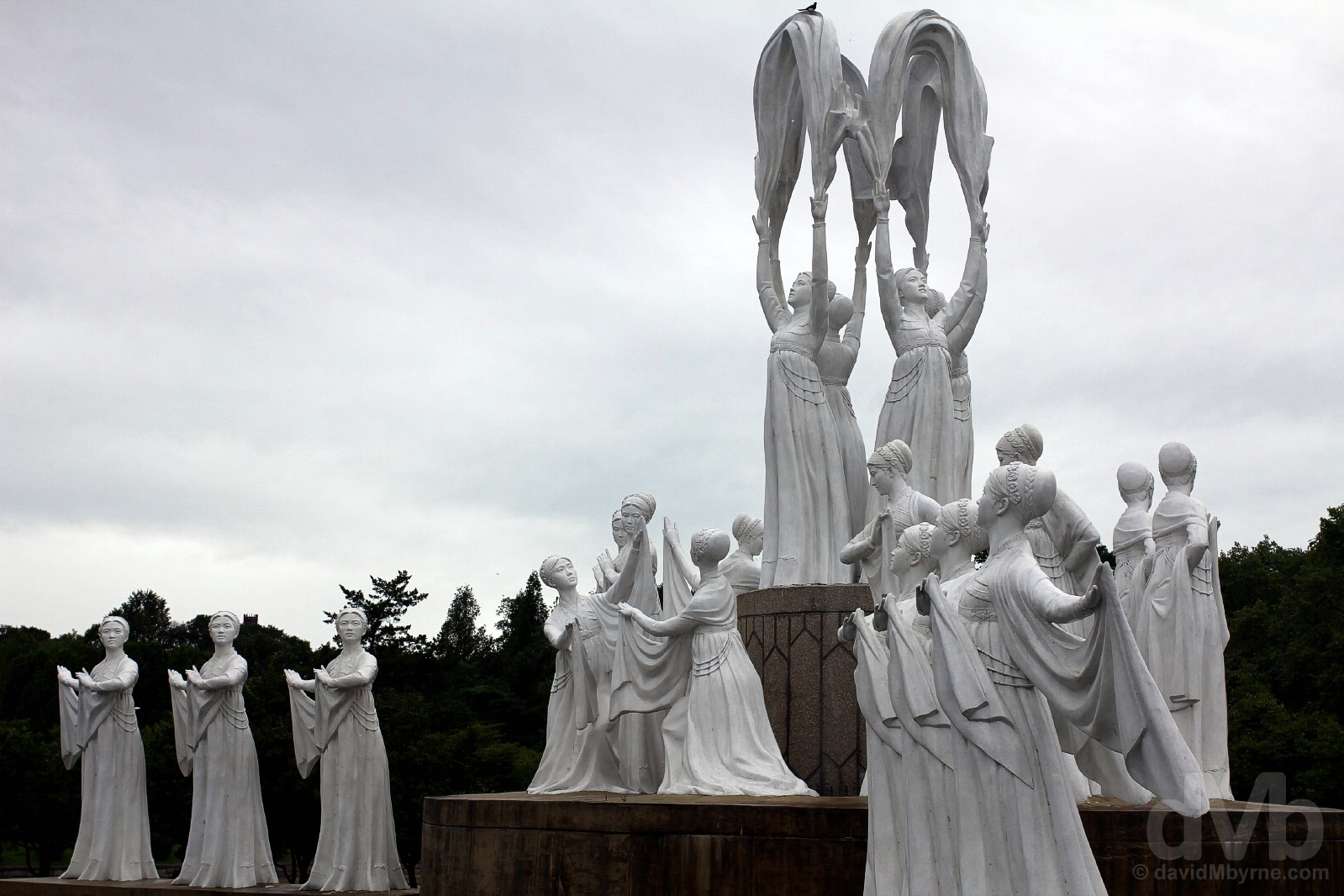
DAY 2 08:15 – MANSUDAE FOUNTAIN PARK – Statues in Mansudae Fountain Park, Pyongyang, North Korea. August 15, 2017.
The first stop on this day was Mansudae Fountain Park on the northern fringes of Kim Il-sung Square. The sort of place you’d come for a wedding shoot, the park was opened in 1976 and houses many a beautifully designed fountain dedicated to the glory of, you’ve guessed it, Kim Il-sung. None of the fountains were in operation when we came calling, more water falling from the sky than was being thrust into it (it was a damp start to the day).
Mansudae Fountain Park is a short distance from the surrealistic overdose that is Mansudae Hill Grand Monument, our (unforgettable) next stop. We got the fountain park statues out of the way before returning to the bus via a stop at a small roadside florist where we were encouraged to buy flowers to be offered up to the Great & Dear Leaders who we’d memorably get acquainted with in a few minutes’ time. Oh the anticipation.
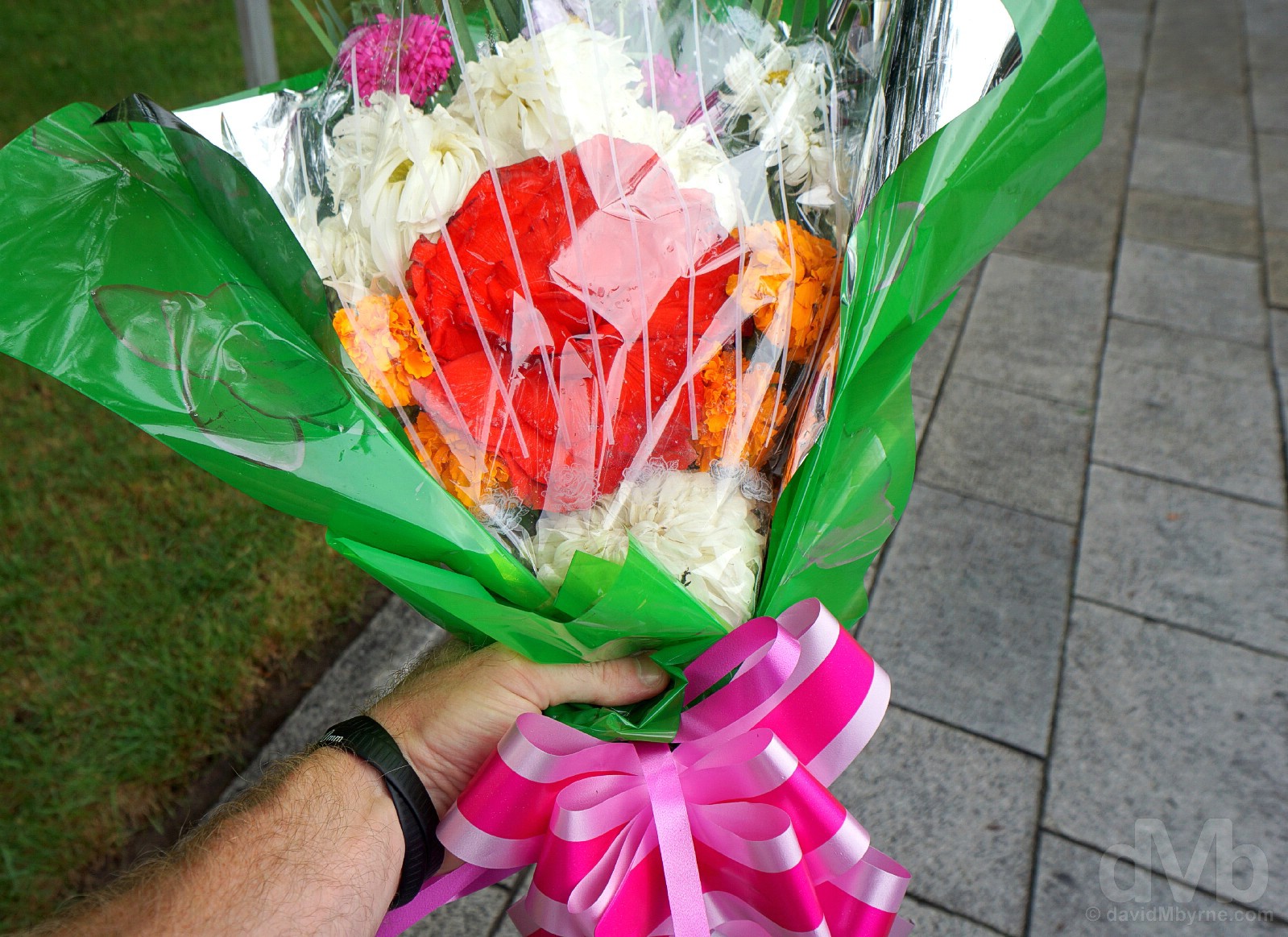
DAY 2 08:33 – FLOWER OFFERING – Flowers for presentation to The Great & Dear Leaders of the Mansudae Hill Grand Monument, Pyongyang, North Korea. August 15, 2017.
I got the last of the €5 bunch of flowers, those purchasing after me having to make do with a cheapo €3 bunch (tut tut). An appreciated show of respect beyond the measure of your bow once in the presence of 22-metre-high bronze greatness, I was actually thanked – by Ha, as if they were meant for her pleasure – for making this purchase. You are most welcome.
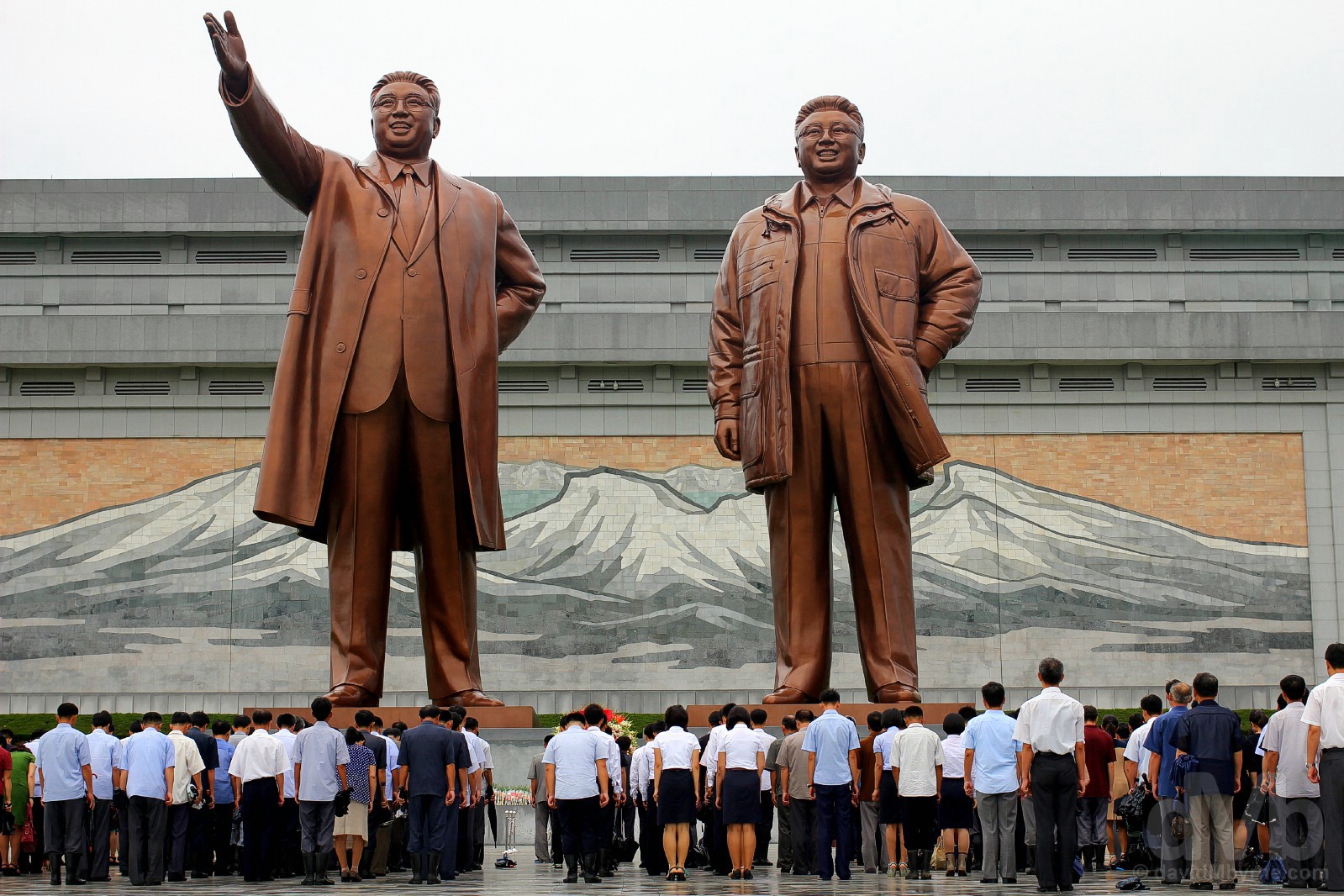
DAY 2 08:41 – MANSUDAE HILL GRAND MONUMENT – Paying respects to Kim Il-sung, The Great Leader (left) & Kim Jong-il, The Dear Leader (right), at the Mansudae Hill Grand Monument, Pyongyang, North Korea. August 15, 2017.
Save for Pyongyang’s Kumsusang Memorial Palace – where this pair lie in state all Madame Tussauds like and a location that was not on our packed itinerary, however changeable – this is probably the most revered location at which to pay one’s respects to the dead august leaders, not to mention where the bizarre personality cult of North Korea’s founding dynasty can be witnessed firsthand by nescient foreigners like me (see ‘The Kim Cult’ below). Mansudae Hill Grand Monument used to be only half as surreal as it is today; there used to be only one 22-metre-tall bronze statue here, that of Kim Il-sung, the nation’s founding father, he immortalised here on the occasion of his 60th birthday in April 1972, 22 years before his death (upon initial unveiling it is said that the statue was covered in gold leaf, an over-the-top display of opulence the Chinese, who reportedly funded the monument’s construction, were none too happy about thus prompting the erection of a more modest bronze statue in its place). His son, Kim Jong-il, joined him on the rostrum during the 2012 Centennial Celebration of Kim Il-sung’s birthday and shortly after his own demise in December 2011. The centrepiece of a larger complex, all eyes – and devotion – are obviously directed towards the statues, the base of which provides ample space for flower offerings and which front the wall of the Korean Revolution Museum building; the wall displays a massive mosaic mural of a scene from Mount Paektu, the Korean peninsula’s highest peak and considered to be the sacred mountain of revolution and where North Korean state media claim the Dear Leader was born (the Russians take issue with this titbit, claiming he was actually born in a Russia while Kim Il-sung was in exile in the country during the Japanese occupation of the Korean peninsula).
RESPECT
Surreal as it may seem/is, locals expect visitors to this place to take it all very seriously and show respect to the monument. One must dress respectfully (tank tops, flip-flops, jeans and shorts are a big no-no, my shorts waiting for me back on the bus for when we got this experience out of the way). We were reminded how to bow, as deep as you can go (but there’s no need to overdo it) and in unison (“1-2-3… bow”), but only after the flowers had been deposited by those offering them up (doing so gets you that bit closer to greatness, if only for a few seconds). We were also told to avoid framing the Great & Dear Leaders in any way that would crop their colossal form – it’s full frame or no frame at all, if you don’t mind (a wide-angle lens wouldn’t go amiss here). A semblance of respectful silence was observed by all, amplifying the sound of the ever-present and somber elevator-esque music. Needless to say, it was all a bit phantasmagorical, a bit ‘is this real?”, but kind of expected at the same time. The highlight of the day? Probably. The highlight of the trip to North Korea? Possibly. It’s certainly a 10-minute moment that will live long in the memory.
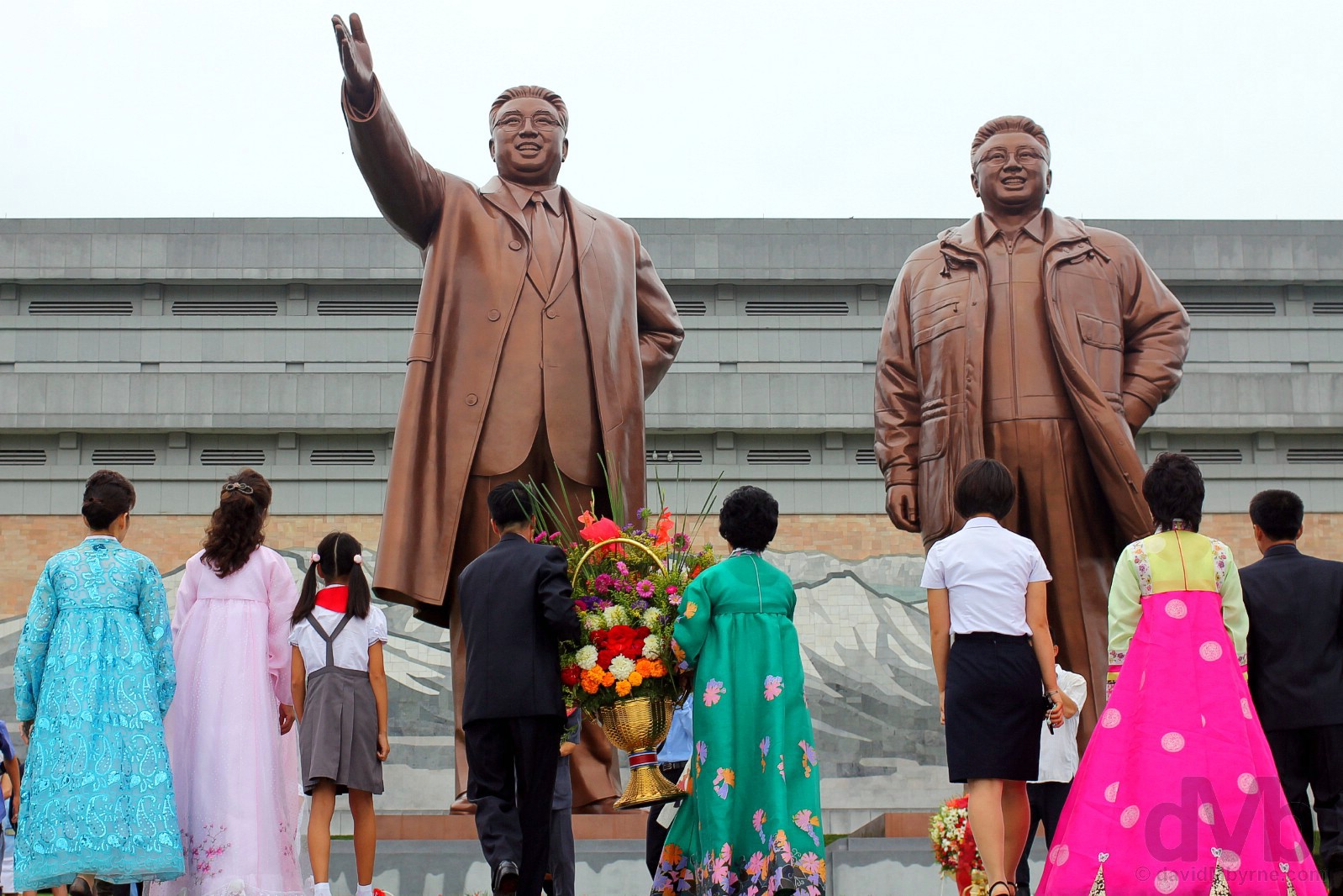
DAY 2 08:56 – MANSUDAE HILL GRAND MONUMENT – Flower offerings at the Mansudae Hill Grand Monument, Pyongyang, North Korea. August 15, 2017.There’s no need to overdo it with the bowing, but it’s fair game where the flower offerings are concerned.
The Kim Dynasty & The Personality Cult
North Korea officially describes itself as a self-reliant socialist or workers’ state. In reality, it’s a regressive totalitarian dictatorship, the world’s last, ruled by the Workers’ Party and presided over by the Kim family since the country’s inception in 1948 amid the chaos following the end of the Second World War.
Kim Il-sung, a.k.a. The Great Leader (1912-1994, in power from 1945 until 1994)
Kim Il-sung came to power after the overthrow of Japanese rule in 1945. Wielding almost unlimited power over his subjects for almost half a century, he surpassed all others of his time in longevity as a national leader, outliving Stalin by four decades and Mao Zedong by almost two decades, and he remained in power throughout the terms of office of six South Korean presidents, nine US presidents and no less than twenty-one Japanese prime ministers. Referring to himself as Suryong, or Great Leader, as early as 1949, it was he who authorised the invasion of South Korea in 1950 igniting the Korean War (not that any North Korean would believe/admit this). Shaping political affairs for almost half a century, he introduced the personal philosophy of Juche, or self-reliance, which became a guiding light for North Korea’s development, its very own brand Confucianist-tinged Communism and an ideology distinct from neighbouring Chinese & Soviet ideologies. Kim Il-sung died of a heart attack in July 1994, an event that rocked the country. A 10-day mourning period followed after which the post of President was assigned to him, and for no less than eternity.
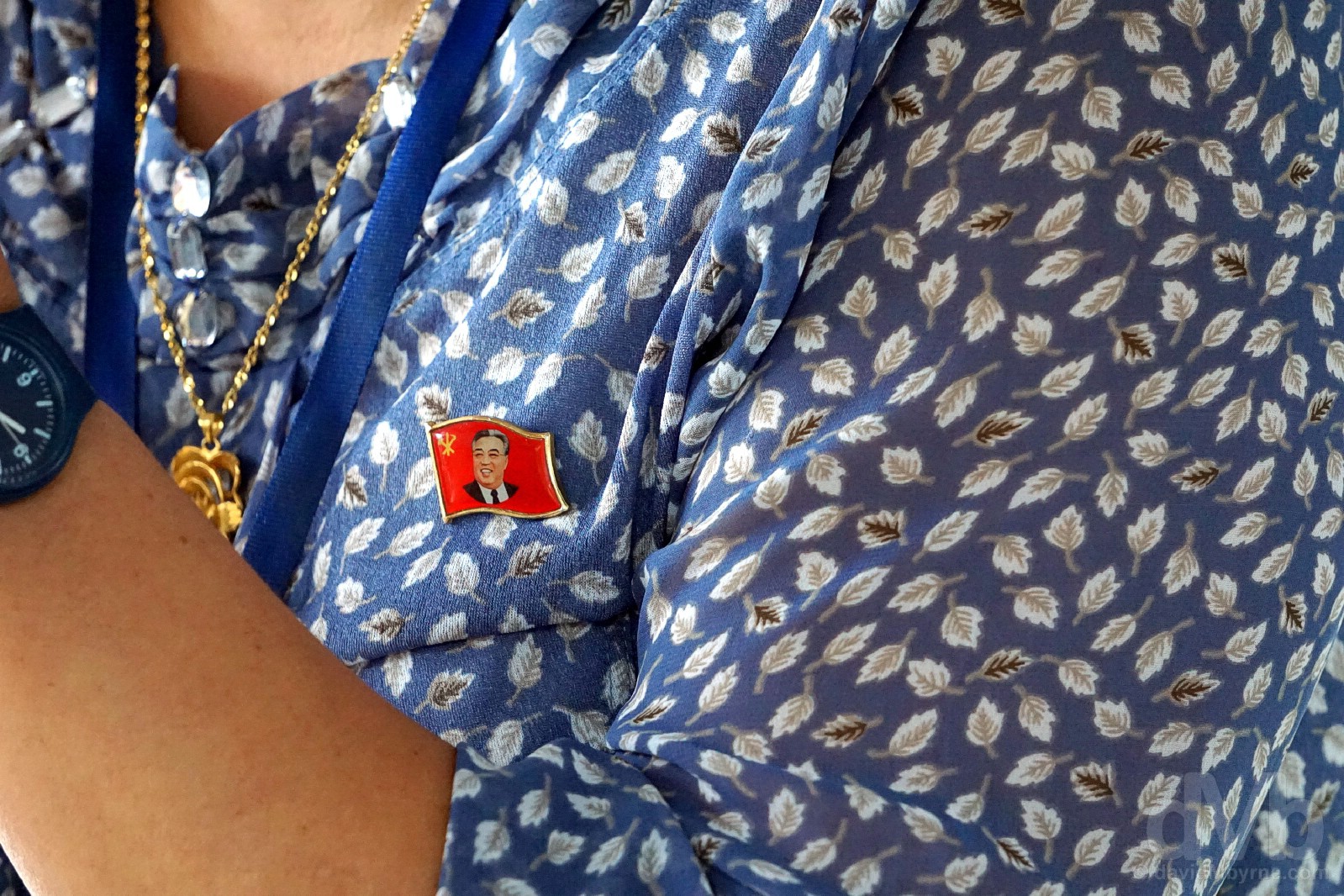
KIM IL-SUNG, PRESIDENT FOR LIFE ‘CLOSE TO THE HEART’ – A Kim Il-sung badge ‘close to the heart’ of our tour guide Ha while navigating the streets of Pyongyang, North Korea. August 15, 2017.
The first thing I noted about the officials who boarded our train carriage in Sinuiju, and one of the very first subjects I broached with Ha, our female guide (having been told not to ask anything during our time in North Korea about the leaders or the regime), was the metal lapel badge every North Korean adult wears ‘close to the heart’, a badge depicting the face of either president-for-life Kim Il-sung (earlier editions, as seen here) or both father & son, Kim Il-sung & Kim Jong-il (more recent edition). An extremely sought-after keepsake but not readily available for purchase by Westeners, not for love nor money (categorised more as national necessity for adult North Koreans, these are no souvenirs), they are distributed to the masses by ‘the party’ and are largely responsible, along with an abundance of leader portraits, state-fed propaganda, chest-beating revolutionary paraphernalia and us-against-them rhetoric, for keeping the regime and its leaders front & centre in every facet of everyday life for every North Korean.
– The Two Koreas, A Contemporary History, Third Edition (p16)
Kim Jong-il, a.k.a. The Dear Leader (1941/42-2011, in power from 1994 until 2011)
Pint-sized (he was a rather squat 5ft 2in (157cm) tall) & with a well published fear of flying and a penchant for bouffant hair, jumpsuits and platform shoes designed to make him look taller, Kim Jong-il’s leadership is thought to have been even more authoritarian than his father’s. He presided over a period in the country’s history in which it suffered from famine, partially due to economic mismanagement, had a woeful human rights record and ratcheted up a thorny nuclear armament programme the country is said to have acquired from the Soviet Union in the 1980s. A near-obsessive film buff with a reported collection of 20,000-plus video tapes (Rambo was said to be one of his all-time favourite movies), he was also fond of the finer things in life, reportedly consuming over half a million euros worth of cognac a year, while his private train journeys were as luxurious as befitted a leader of North Korea, despite the millions left behind starving due to famine; one Russian emissary who travelled across Russia by train with Kim described how live lobsters were airlifted daily to his train. Hailed as a demigod, his biography claims, among other superhuman feats, that he shot a 38-under par round of golf that included 11 holes in one, wrote no fewer than 1,500 books in three years while at university and apparently composed six operas. Notoriously reserved, he is said to have broadcast to his people only once, in April 1992 during a parade in Pyongyang to mark the army’s sixtieth anniversary, when he uttered into a microphone at the grandstand: “Glory to the people’s heroic military!” Not surprisingly, a personality evaluation report on him compiled by psychiatrists suggested that the “big six” group of personality disorders – sadistic, paranoid, antisocial, schizoid, schizotypal and narcissistic – which were shared by dictators Adolf Hitler, Joseph Stalin and Saddam Hussein were also dominant in the late North Korean leader. His narcissism reached an all-time high in April 2009, 2-plus years before his death in December 2011 of a suspected heart attack, when North Korea’s constitution was amended to officially refer to him (and his later successors) as the “Supreme Leader of the DPRK” (but because his father was named ‘Eternal President’ upon his death, Kim Jong-il never officially became president of North Korea).
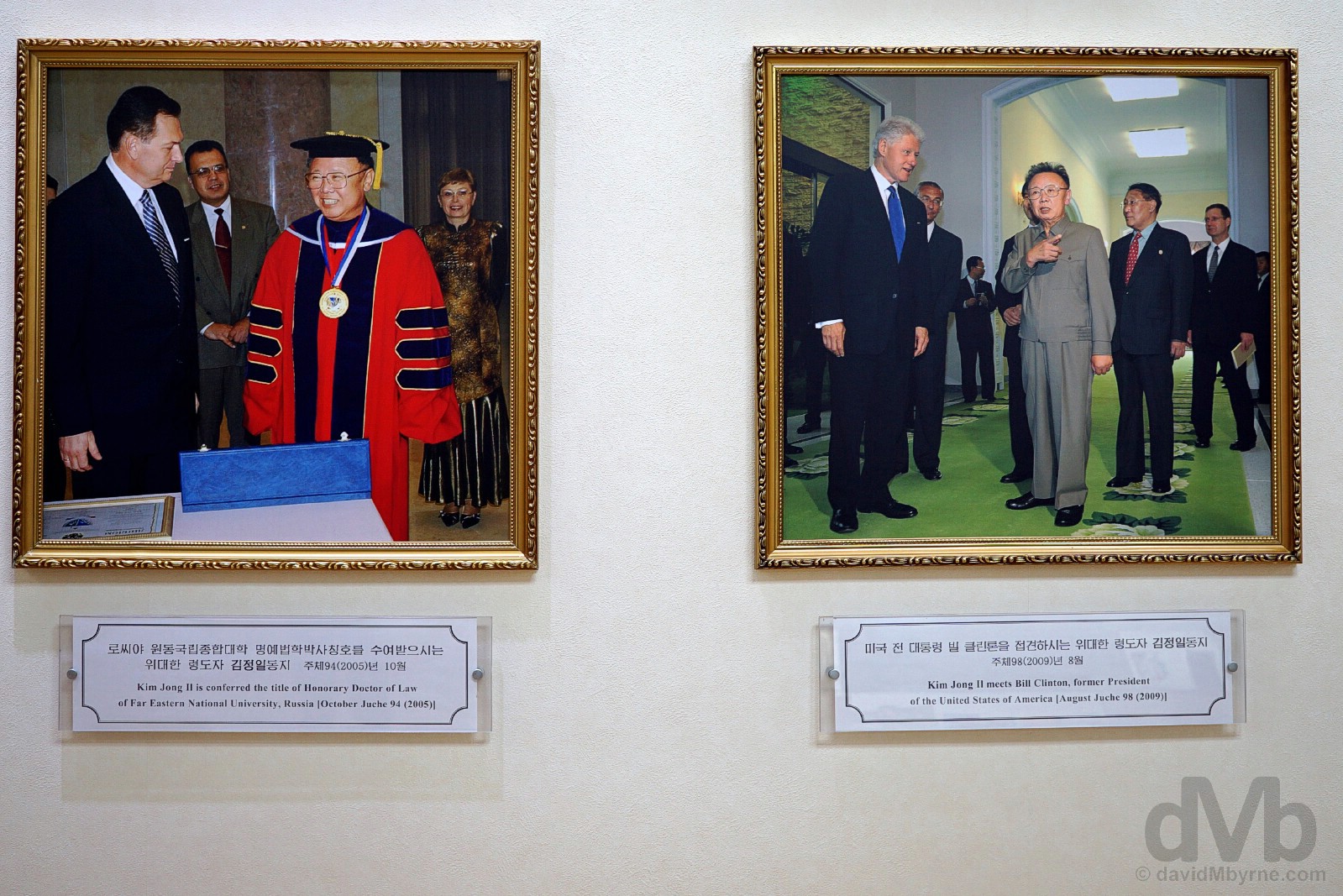
KIM JONG-IL – Photos depicting the Dear Leader in the Cultural Exhibition Centre, Pyongyang, North Korea. August 15, 2017.
Bill Clinton, whose 8-year term as president of the US (1993-2001) was one of concession and productive engagement with the North (the largely positive outcomes of which were undone by the hard-line approach to the North as adopted by the George W. Bush presidency of 2001-2009), visited Pyongyang for a day – August 5 – in 2009 to satisfy a stipulation by North Korea for releasing two American journalists who were detained by the North for straying illegally across the border from China and who were subsequently sentenced to 12 years’ hard labour. No sitting US president has ever visited North Korea, a longstanding wish of Pyongyang that would be seen to lend credibility to both the North Korean regime & its policies among the wider international community.
The Juche Calendar
Notice how the dates on the above picture captions are listed ‘Juche 94′ & ‘Juche 98′, North Korea shunning the traditional Gregorian calendar in favour of its very own ‘Juche’ calendar, one pivoted from the date of President Kim Il-sung’s birth in 1912, Juche 1.
Kim Jong-un (1983/84- , in power from 2011 to the present)
Scion supreme, hailed as the ‘Great Successor” and elected unopposed to the Supreme People’s Assembly in March 2014, little is known for certain about the young, plump & baby-faced Kim Jong-un, the first North Korean leader born after the country’s founding. Nothing, that is, aside from his fondness of basketball and his desire to piss off his neighbours by further destabilising the region all the while giving two fingers to the big, bad US of A. He had barely been seen in public before assuming power and many of the activities of both Kim and his government remain shrouded in secrecy – even details such as what year he was born and whether he did indeed attend a Western school under a pseudonym (it’s almost certain he did, in Switzerland) are difficult to confirm with certainty – but he seems to be someone not to cross, especially if you’re family; official North Korean news outlets reported that in December 2013 he ordered the execution of his uncle Jang Song-thaek for alleged “treachery” while in February of this year he is said to have ordered the assassination of his brother, Kim Jong-nam, in a Malaysian airport.
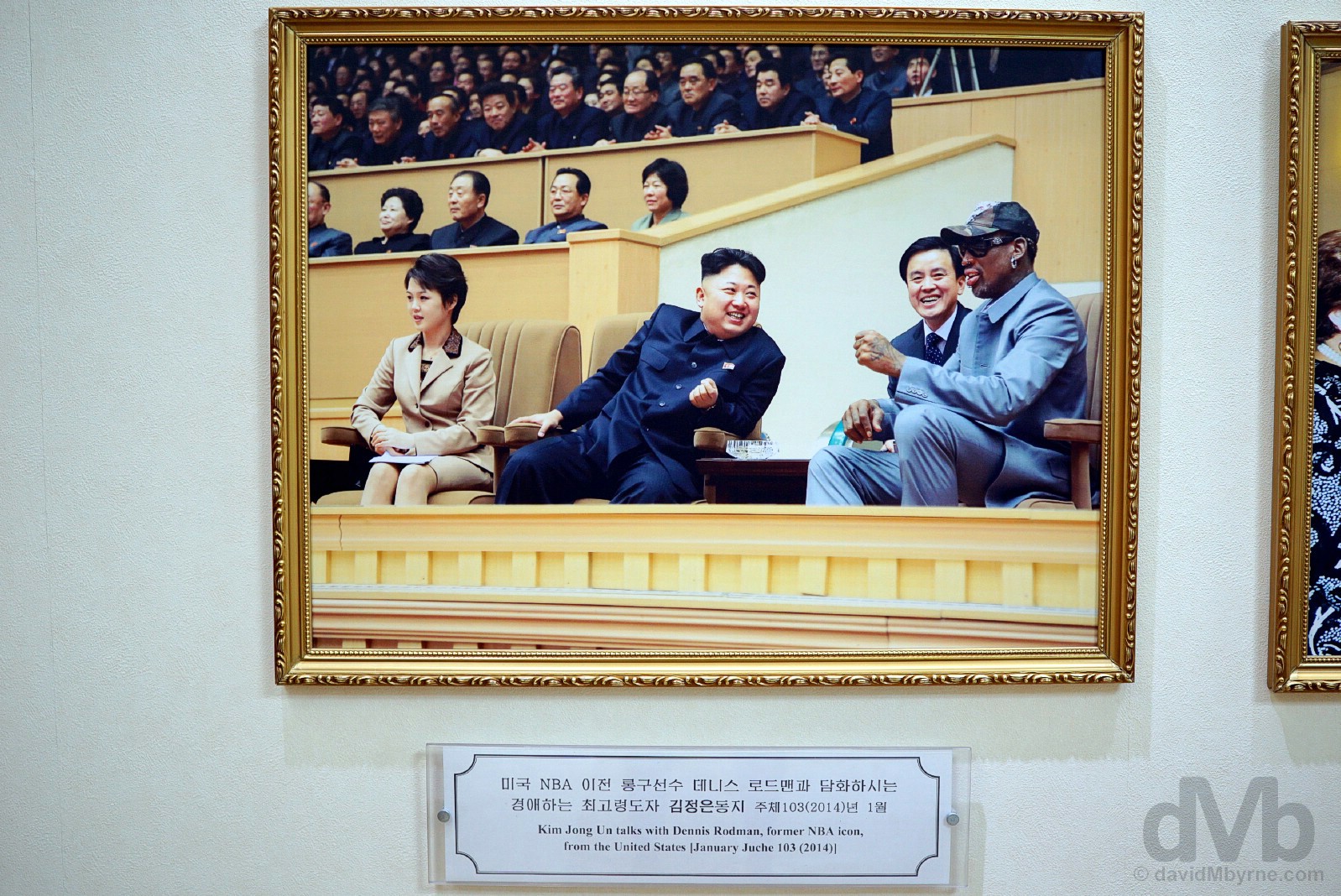
KIM JONG-UN – Cultural Exhibition Centre, Pyongyang, North Korea. August 15, 2017.
Often depicted looking eerily similar to Kim Il-sung, North Korean watchers say it’s no coincidence that Marshal Kim Jong-un is consistently presented in a way that emulates the likeness and mannerisms of his endeared and long-since-dead grandfather.
– The Supreme Leader Kim Jong-un referencing his grandfather, ‘the President’, & his father, ‘the General’, as reproduced from a display in the Cultural Exhibition Centre, Pyongyang.
The Kim Cult
While other countries have had cults of personality to various degrees (Joseph Stalin’s in the Soviet Union & Mao Zedong’s in China two obvious examples), the pervasiveness and extreme nature of North Korea’s elaborate personality cult is unmatched. The personality cult began soon after Kim Il-sung took power of the new country. And while it had its beginnings as early as 1949 with the appearance of the first statues of Kim Il-sung, the veneration of him came into full effect following a mass purge in 1953, was aided by the 1967 appointment of Kim Jong-il to the state propaganda and information department (where he began to focus his energy on developing the veneration of his father) and was greatly expanded after his death in 1994. To this day the personality cult surrounding The Great Leader is by far the most widespread among the people and while there does seem genuine affection for dead leaders, it’s fair to say that it has largely been manipulated, fabricated by the government for political purposes. Marked by an intensity of the people’s feelings for and devotion to their leaders, many defectors claim there are often stiff penalties for those who criticise or do not show “proper” respect for the regime, fear seemingly playing a big and unspoken part in maintaining the cult and thereby in sustaining the regime itself.

GREAT & DEAR MURAL – As seen from the window of my 29th-floor hotel room, a massive Kim Il-sung & Kim Jong-il mural in the Mangyongdae District of Pyongyang, illuminated to great effect at night when most of the surrounding region is enveloped by darkness. Pyongyang, North Korea. August 16, 2017.
Foreign Language Bookstore & Street
The Foreign Language Bookstore, Sungri Street, Pyongyang. August 15 2017.
Propaganda & People
We didn’t have much time to process what we just experienced at Grand Monument on Mansu Hill as we were pretty swiftly back on the streets of Pyongyang engaging in a spot of shopping and a spot of enjoyable people watching. But first I had to deal with the printed propaganda in Pyongyang’s Foreign Language Bookstore.
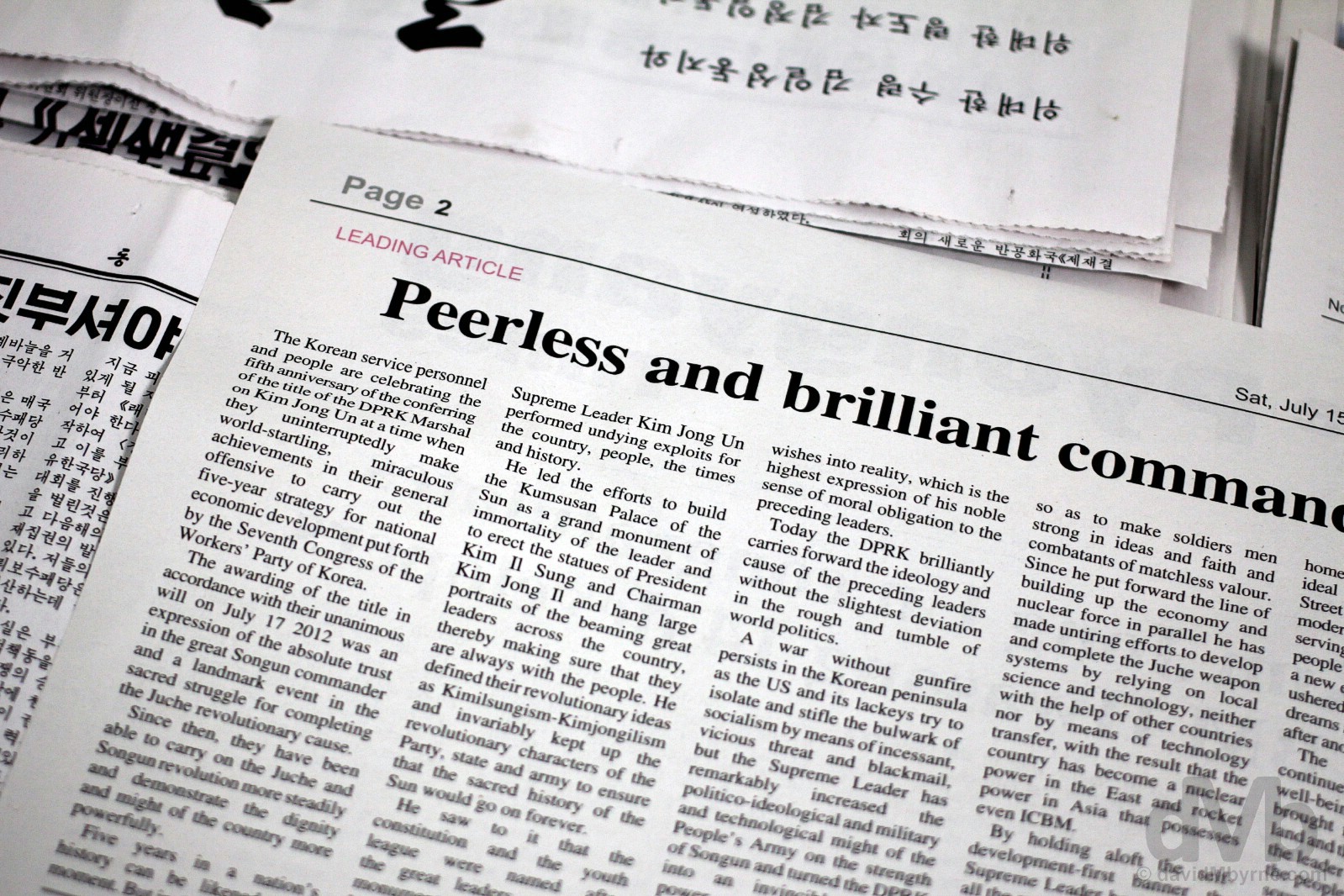
DAY 2 10:00 – FOREIGN LANGUAGE BOOKSTORE – Propaganda. Foreign Language Bookstore, Sungri Street, Pyongyang, North Korea. August 15, 2017.
The Foreign Language Bookstore is small and it felt more like a library than a bookstore, but what it definitely is is a well established stop on all North Korea tour group itineraries. There are ample opportunities in here to spend much-need hard currency, most literature relating to the regime, its leaders and the Juche philosophy. Revolutionary posters, some priced at €30 a pop, were something of a hit with certain members of our tour group, as were recent copies of the English language Pyongyang Times. I spent some time reading the issue dated July 15 2017, the headline of the article ‘Peerless and brilliant commander’ (referring, of course, to Kim Jong-un) catching my eye (below).
– The Pyongyang Times, July 15 2017
Activity on the streets outside the Foreign Language Bookstore was a little less contrived than the text on display inside it.
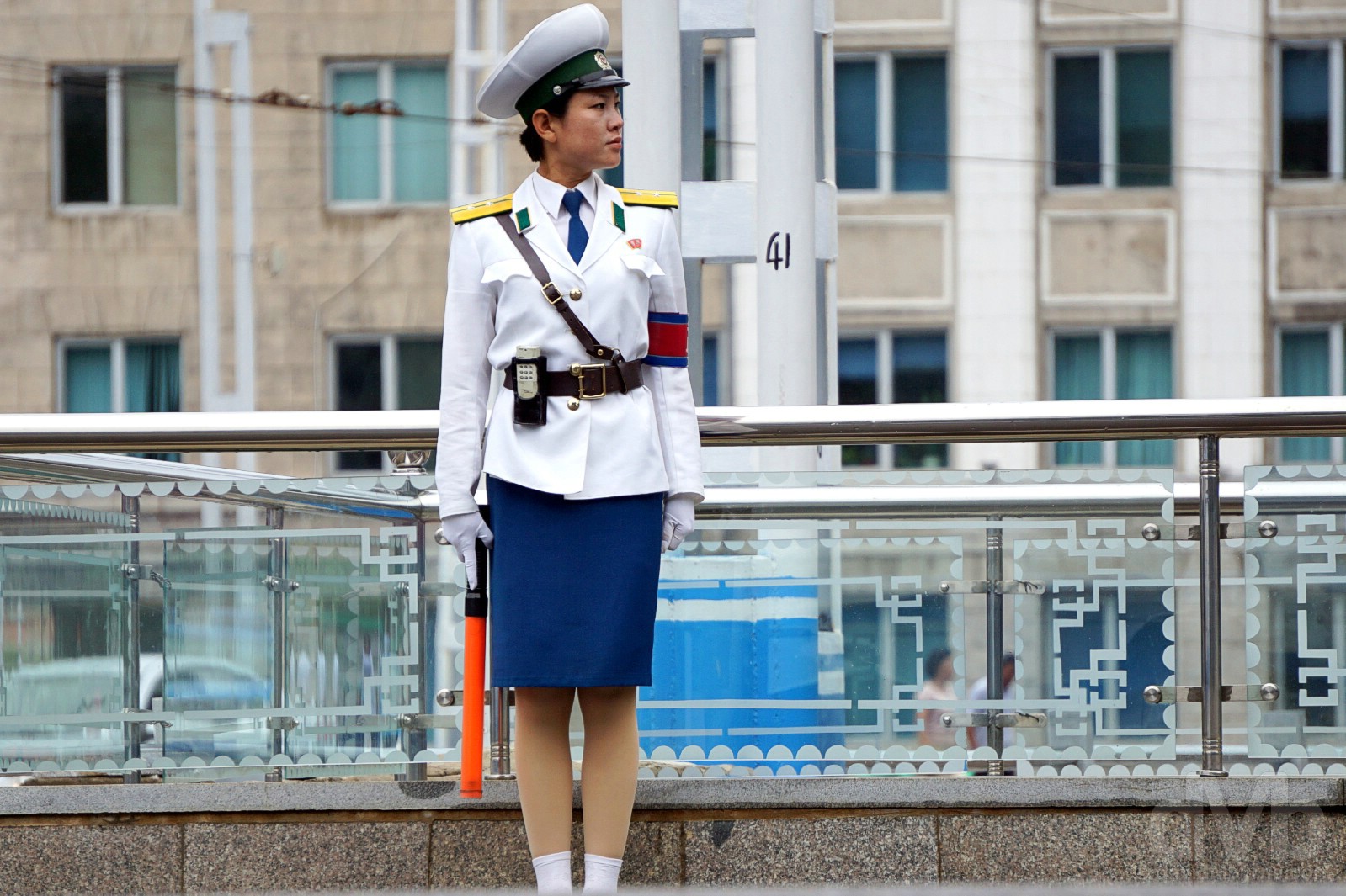
DAY 2 10:08 – NORTH KOREAN ATTIRE – Traffic control on Sungri Street, Pyongyang, North Korea. August 15, 2017.
Aside from the obvious spectacle of uniforms on schoolchildren & public servants and fatigues on military personnel, oversized and loose-fitting shirts & pants (on men) & neat blouses and skirts (on women) seem to be the de facto garb among your everyday adult North Korean as witnessed on the streets of Pyongyang. It’s functional attire with a dearth of bright, standout colours &/or patterns, and in a society with virtually zero market freedom, zero freedom of expression, an absence of branding/advertising on clothing is both very noticeable and kinda refreshing; you won’t find the latest Nike, A&F hoodies or Hollister t-shirts on these streets. Also, and in a society where most essentials are provided by the state, a materialistic keeping-up-with-the-Joneses culture is absent, there being no benchmark for social class or the accumulation of material goods among the general populous.
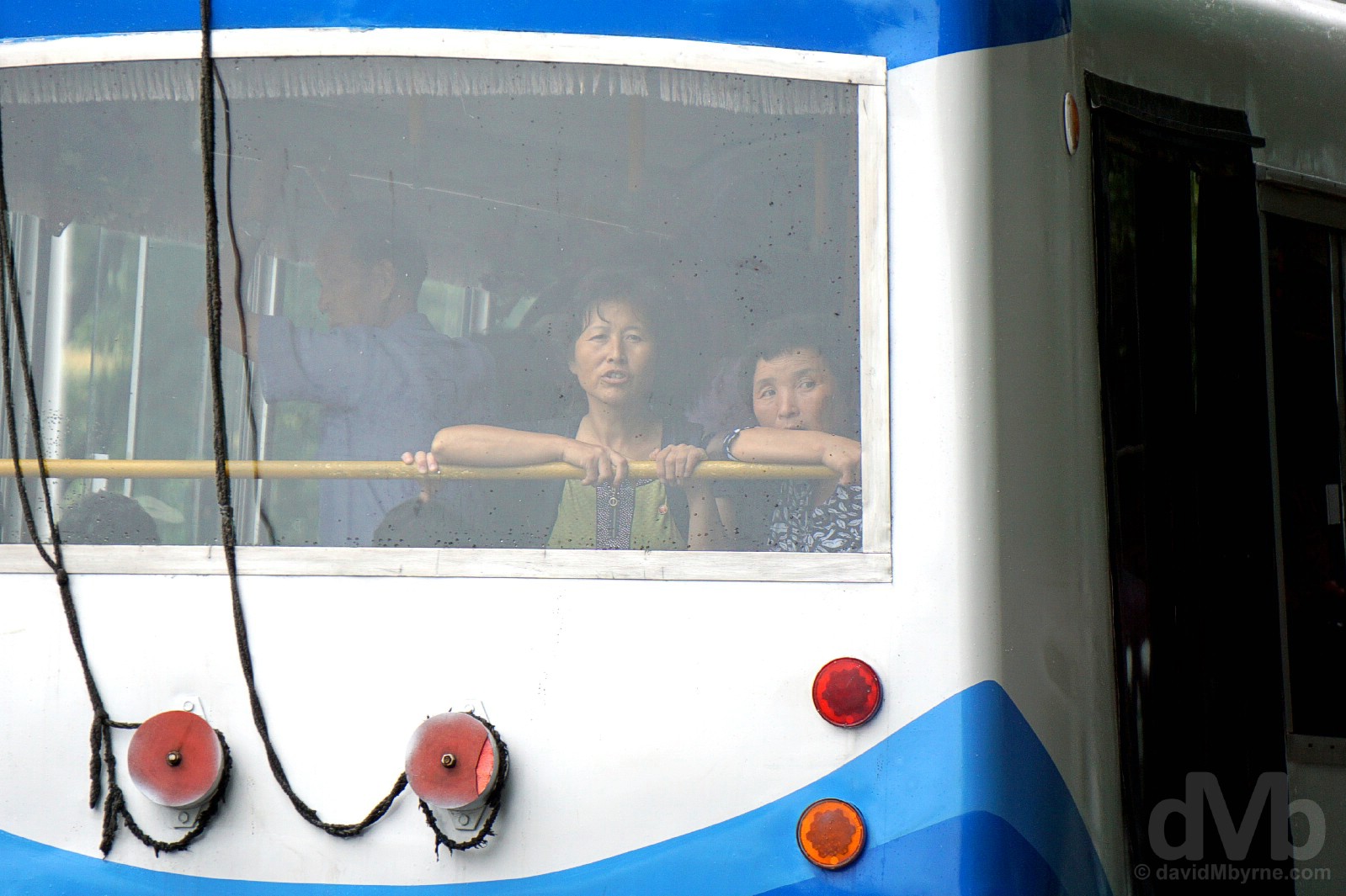
DAY 2 10:10 – Sungri Street, Pyongyang, North Korea. August 15, 2017.
Some more captures from this day on the streets of Pyongyang.
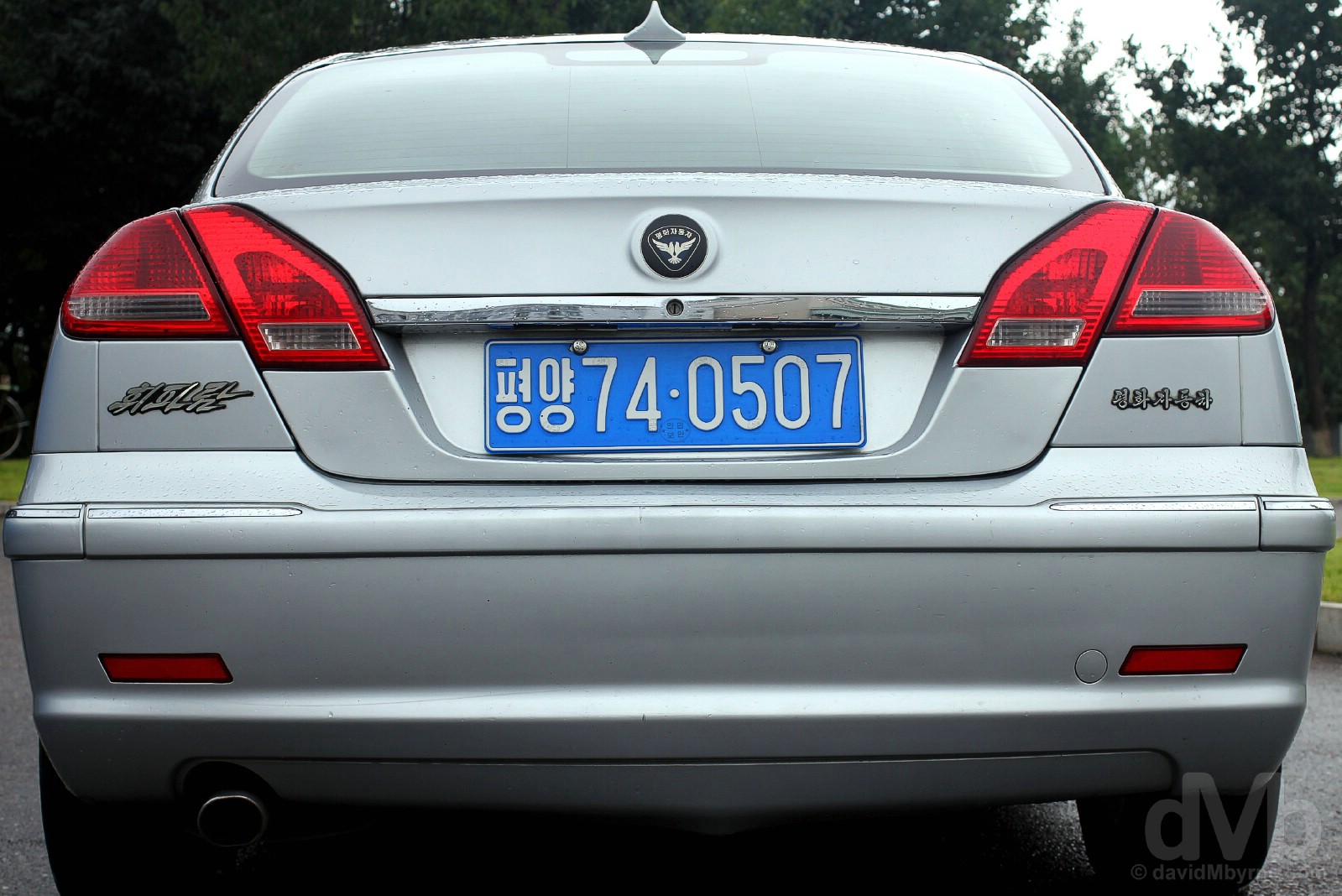
DAY 2 10:15 – PYEONGHWA MOTORS – A Pyeonghwa Motors car on the streets of Pyongyang, North Korea. August 15, 2017.
The contrasts are striking. While South Korea has Hyundia/Kia Motors, North Korea has Pyeonghwa Motors. In what is a telling contrast between the Korean peninsula’s two neighbouring economies, one is the world’s third-largest automotive maker producing almost 8 million vehicles in 2016 and with a brand you probably recgonise, the other produces less than 500 vehicles a year and you’ve doubtless never heard of them before. Founded in 2000, Pyeonghwa Motors is a joint venture between South Korea’s Pyeonghwa Motors and North Korea’s Ryonbong General Corp. Holding exclusive rights to car production and sale in North Korea isn’t the coup it might initially sound, not when the whole automotive industry of North Korea is responsible for the production of some 400 cars a year, the majority of them destined for the Korean People’s Army. Needless to say, there isn’t a viable market for cars in a country whose populace live in a subsistence economy and who can’t afford one; car ownership by private citizens is a very, very rare privilege (yet despite this billboards and TV commercials still advertise to the masses in a bid to show residents that their country is capable of producing products such as motor vehicles while peddling the impression of a successful economy). The vast majority of vehicles plying North Korean roads are state owned as denoted by a blue licence plate – military vehicles sport black plates with various other colours designating foreign businessmen, diplomats and even gold medal-winning Olympic athletes, they receiving a car from the Workers’ Party for bringing honour to regime.
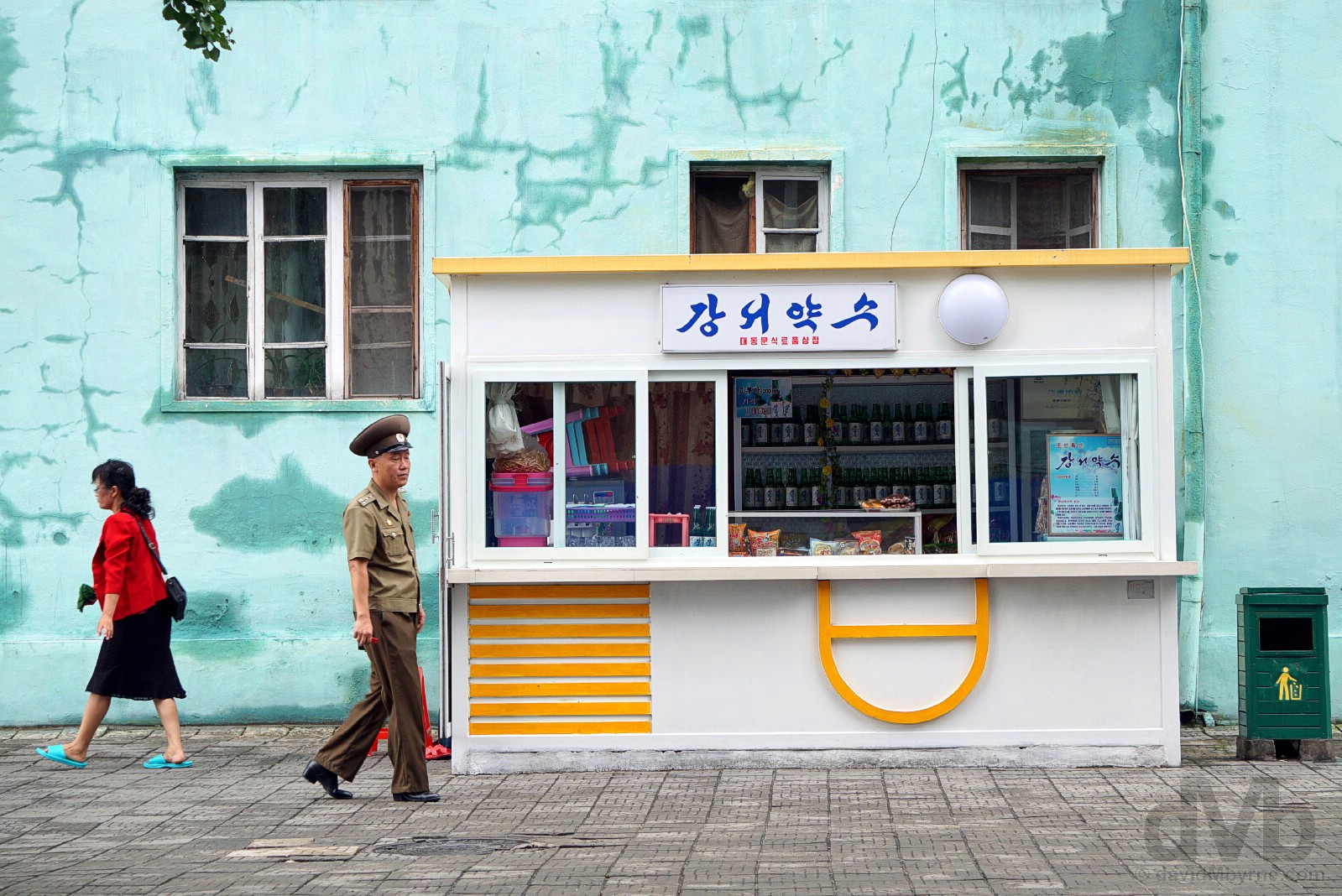
DAY 2 10:13 – SPOTLESS – Somun Street, Pyongyang, North Korea. August 15, 2017.
While most buildings look like they would benefit from some upkeep, an observation not unique to Pyongyang I might add, the streets of the city were always spotless; it would be a challenge to find any discarded litter, cigarette butts or chewing gum, the sort of eyesores that blight the majority of world capitals. And as for graffiti. Forget it. Not a city for urban ‘artists’, graffiti and any kind of public defacement is strictly illegal, carrying as it does harsh penalties (and I’d imagine ‘harsh penalties’ in North Korea are harsh penalties). The rumour goes that in 2011 college graffiti denouncing Kim Jong-il brought the city to a standstill, the regime refusing to sell train tickets until the culprit was brought to justice. A little North Korea sensationalism that had more to do with defiling the Dear Leader’s name as opposed to a wall maybe, but you get the point. Best leave your spray cans at home if embarking on a trip to North Korea. I captured this picture on one of only two periods during my time in North Korea when I was both away from my fellow tour group members and not in eyeshot of either of our two guides. I lagged behind the rest while walking the small distance from the Foreign Language Bookstore back to the bus, our guides not seeming to worry all that much about a stray, albeit one going in the right direction. It was a small escape granted but an escape nonetheless, and in North Korea those are rare occurrences.

DAY 2 10:38 || Going down. Entering Puhung Station of the Pyongyang Metro, Pyongyang, North Korea. August 15, 2017.
The banner (not seen here) above the escalator reads: “Long Live General Kim Jong-un, the Sun of Songun (military-first) Korea!”
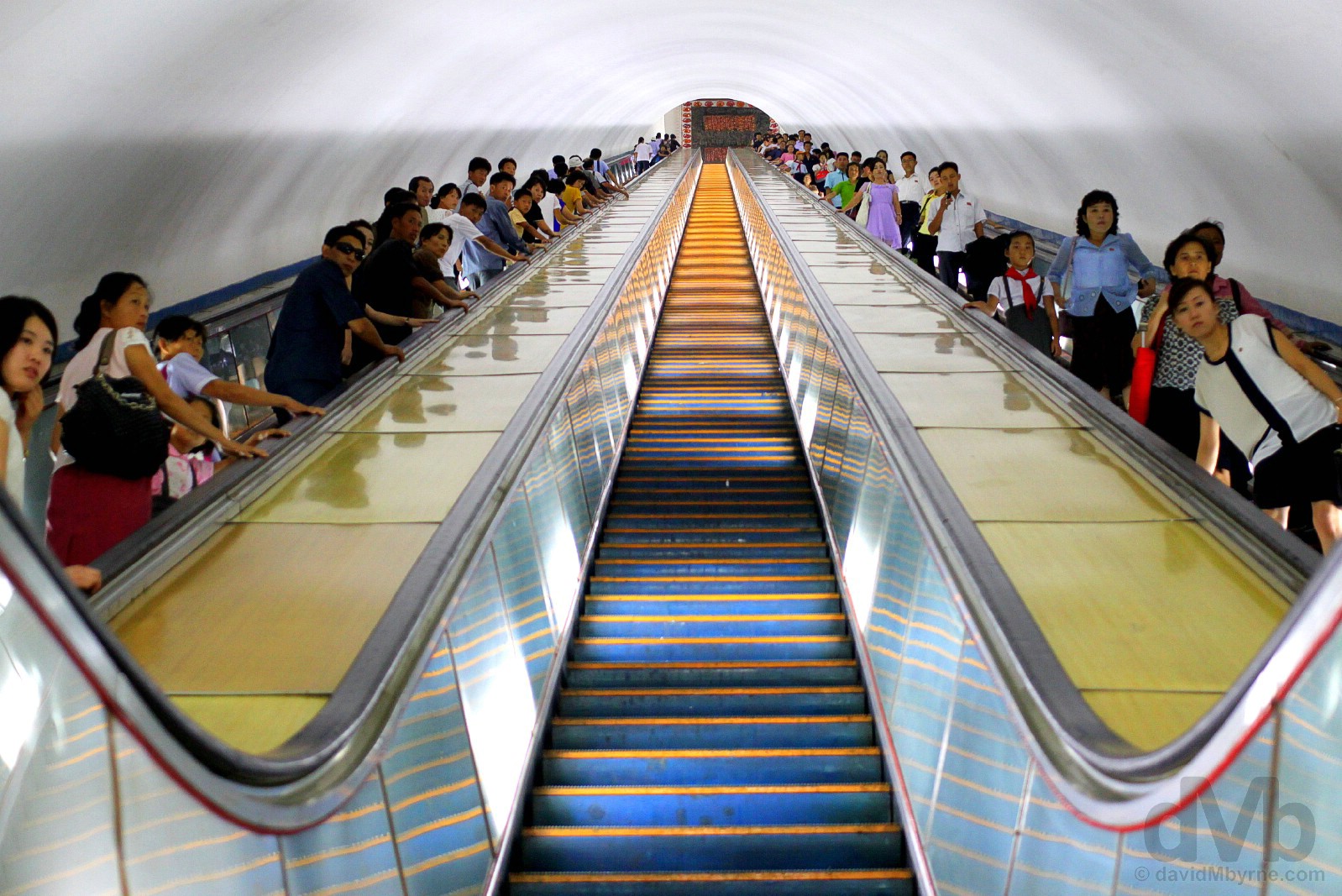
DAY 2 10:44 – PYONGYANG METRO – Looking down as we look up. Puhung Station of the metro system in Pyongyang, the world’s deepest. Pyongyang, North Korea. August 15, 2017.
Constructed between 1965 and the early 1970s, the two line, 16-station, 22.5-kilometre-long ultra-nationalistic Pyongyang Metro system isn’t exactly extensive, but it sure is deep; at 110 metres underground, it’s the deepest metro system in the world. It’s a simple system, each station, the majority of which are named after themes and characteristics from North Korea’s socialist revolution, having only one entry/exit providing access to a single platform. Blast doors combine with the design and depth to ensure the system can double as an effective bomb shelter in times of war. Being so deep means the views from the platform up the escalator to ground level are rather sweet, aided by the trippy lighting on the (purposely?) unused central escalator. Jerry, one of our party, caused quite a kerfuffle by getting his flip-flop stuck while at the end of the 4-minute escalator ride from ground level (it’d be a stiff walk to ground level if the electricity bill wasn’t paid), this causing the locals to take quite a keen interest in our arrival (as seen here). Elsewhere in the system – and while exploring the platforms and riding the carriages – our presence rarely raised a single North Korean eyebrow.
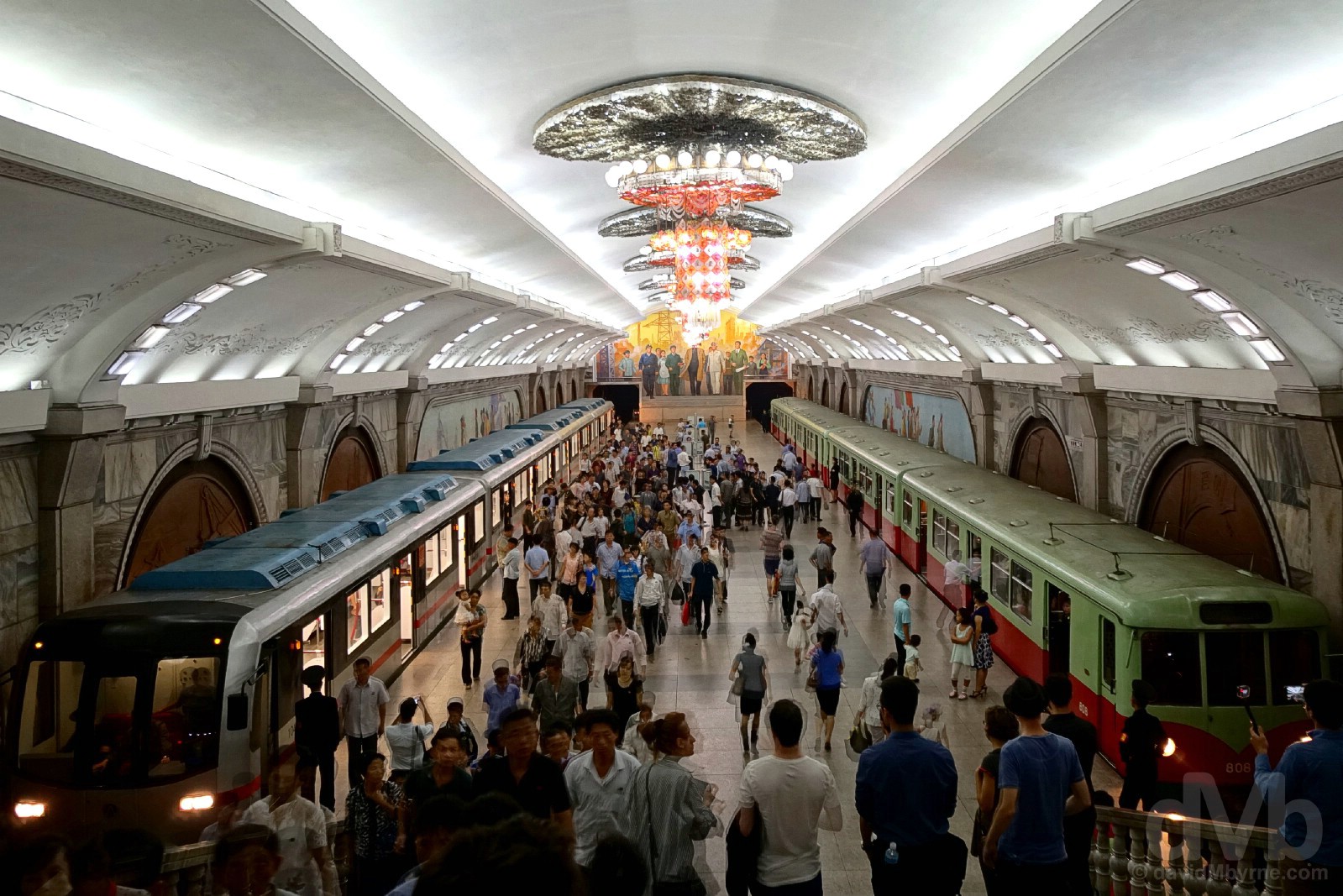
DAY 2 10:45 – PUHUNG STATION – Newer style Made-in-China rolling stock (left) and older Soviet-era rolling stock (right) on the platform of Puhung Station of the Pyongyang Metro, Pyongyang, North Korea. August 15, 2017.
While the majority of Pyongyang’s surgically-clean metro stations were built in the 1970s, the two neighbouring showpiece stations of Yonggwang and Puhung, the latter seen here, were built in the 1980s. The newest and most finely decorated stations in the system and designed to bring a semblance of affluence and luxury to the lives of even the lower working class while serving as inspiration in pursuing national goals, both stations feature grandiose chandeliers and impressive Socialist realist art in the form of massive revolutionary mosaics – centrepiece mosaics adorn every station and each fit a unique theme, the mosaic seen here at the end of the Puhung Station platform entitled The Great Leader Kim Il-Sung Among Workers. This platform was impressively illuminated, bustling with the arrival of trains (every 5-8 minutes or so) and quiet in anticipation for the next arrival. Yep, and as presented, it was just like any other metro system anywhere else in the world. This just happens to be North Korea.
Restrictions, Progress & Conspiracy
While it’s definitely the deepest, the restricted Pyongyang Metro must surely also be the most mysterious of its kind, although it is opening up and seemingly every station is now accessible to escorted foreigners; progress of this kind, all in the name of advancing the country’s fledgling tourism offering, is nothing to be barracked at in the bureaucratic behemoth that is North Korea. Until restrictions were relaxed in 2010 tourists were only allowed to travel the 1 spot between Puhung & Yonggwang stations, this sparking something of a conspiracy theory that the two stations comprised the entire system, that the system was purely for show, and that the passengers encountered were actors. For tourists today, the seemingly staged jaunt on the metro system is a little more transparent, a little more panoptic; we rode 5 stops in total via three different stations/platforms and aboard two different trains (one old & almost empty, one new & jam packed). And while I’ve ridden metro systems in many cities around the world, the sampling I got of the Pyongyang Metro was fascinating. Utterly, utterly fascinating.
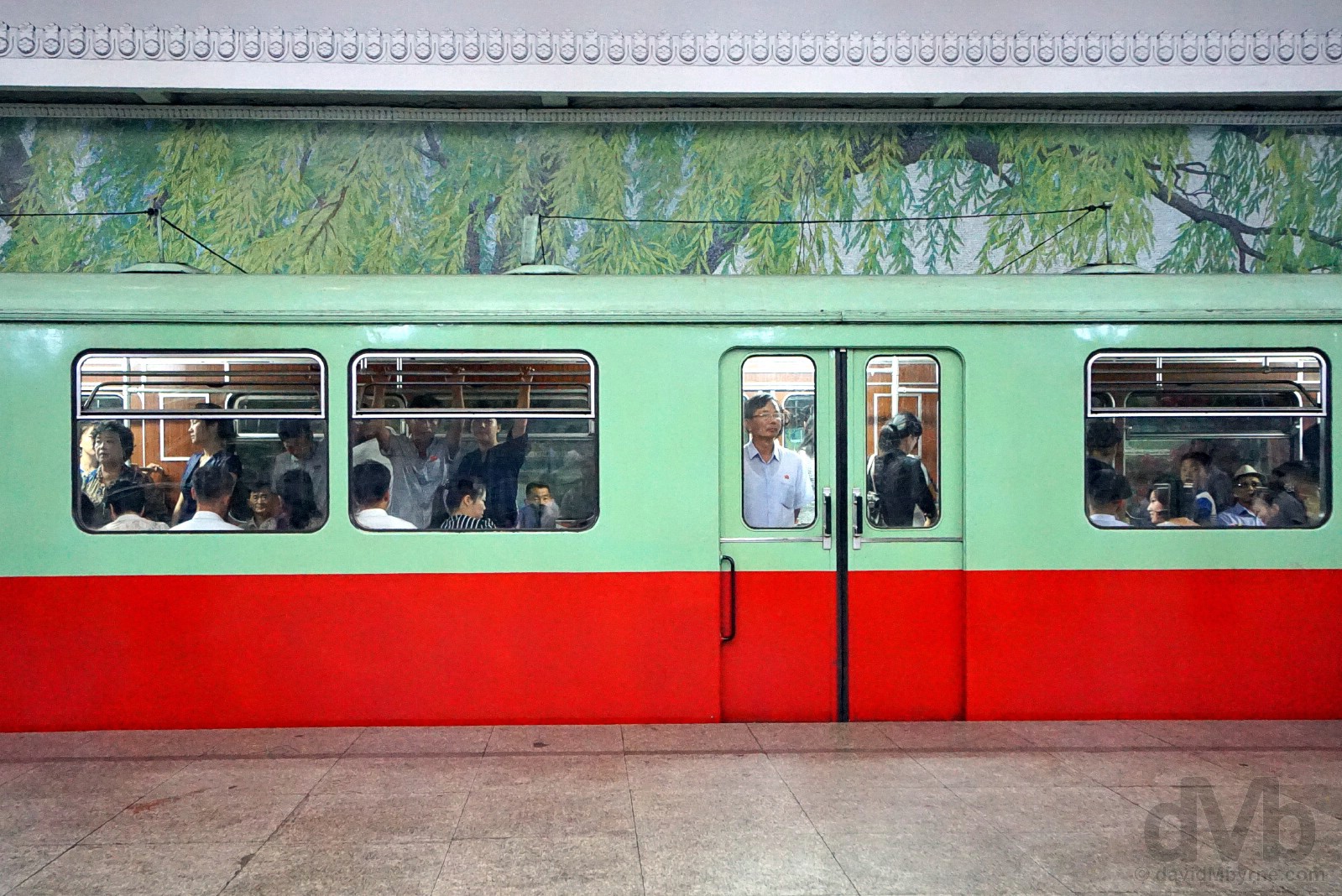
DAY 2 10:51 – YONGGWANG STATION – On the platform of Yonggwang Station of the Pyongyang Metro System, this station boasting massive eighty-metre-long murals along the platform walls. Pyongyang, North Korea. August 15, 2017.
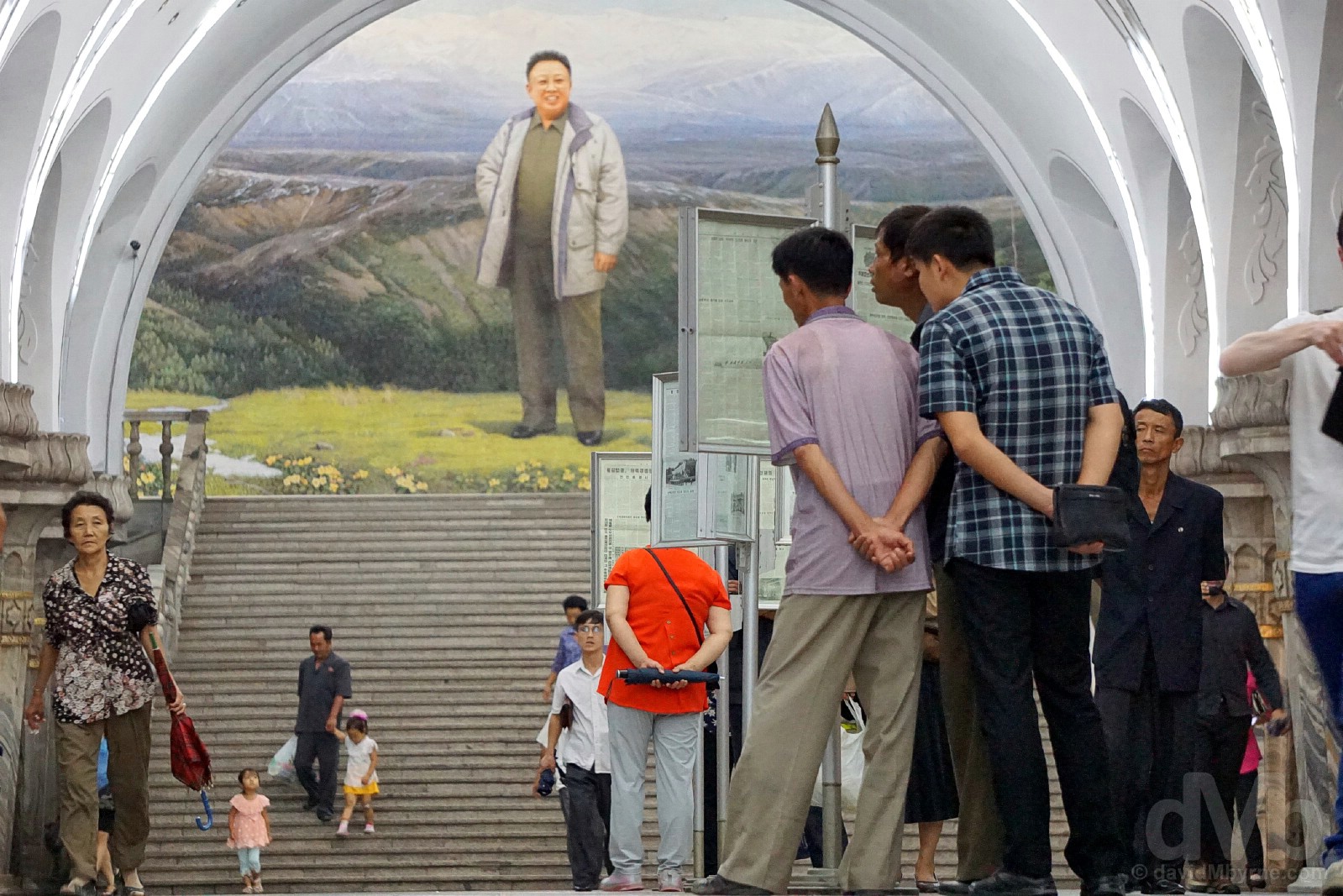
DAY 2 10:56 – PLATFORM NEWS/PROPAGANDA (RODONG SINMUN) – Reading the Rodong Sinmun on the platform of Yonggwang Station of the metro system in Pyongyang, North Korea. August 15, 2017.
North Korea is a society with no internet access and with very few mobile/cell/smartphones – it is estimated only one out of every ten people in North Korea, the majority being in Pyongyang, own a mobile phone, an obvious observation being people on the streets actually watching where they are going as opposed to having their faces buried in a smartphone (ditto for when riding the metro). With few options, news is served up to the masses via state media outlets and is, of course, tightly controlled, heavily censored and high on propaganda. North Korea’s stated-owned Rodong Sinmun is a 6-page daily publication, the official newspaper of the Central Committee of the Workers’ Party of Korea. Quoted frequently by both the Korean Central News Agency, the state news agency of North Korea, and international media, it is regarded as a source of official North Korean viewpoints on many issues, not to mention a valuable source of news for those riding the Pyongyang Metro. And while the Pyongyang Metro system does seem to be a shrine to his father Kim Il-sung, Kim Jong-il, The Dear Leader, does of course feature. Word on street says that the massive Dear Leader mural on display in Yonggwang Station, and as recently as 2013, depicted Mount Paekdu, the highest peak on the Korean peninsula and North Korea’s most sacred revolutionary site, somewhere North Korean state media has always claimed Kim Jong-il was born. Soviet records, however, indicate he was actually born in Russia.
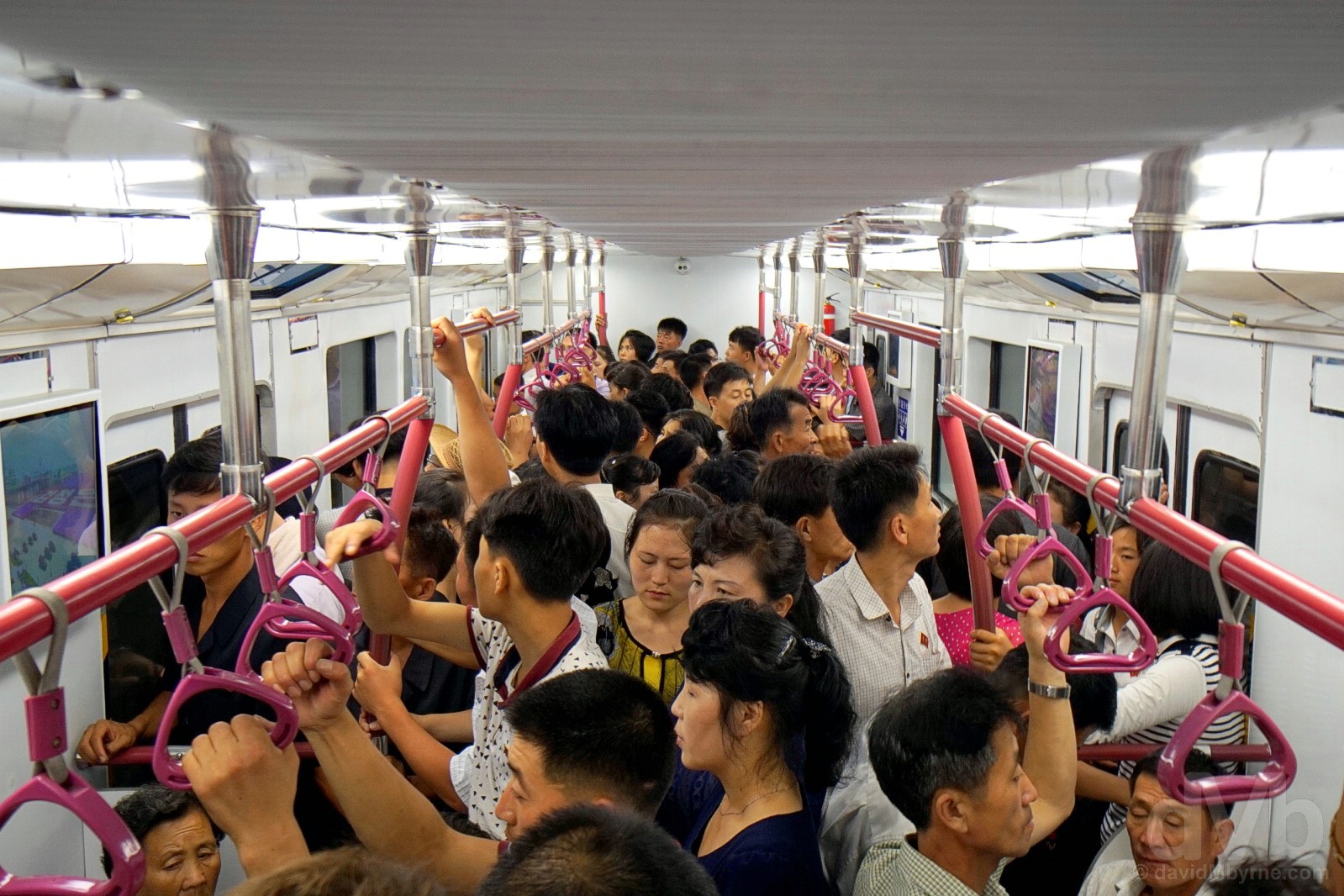
DAY 2 11:05 – RIDING THE UNDERGROUND PYONGYANG RAILS – Riding the Pyongyang Metro system the 4 stops between Yonggwang and Kaeson stations, Pyongyang, North Korea. August 15, 2017.
The previous metro carriage we rode between neighbouring stations Puhung & Yonggwang was of the older Soviet-era rolling stock variety, museum piece castoffs from Germany destined for the smelter until North Korea stepped in to purchase them back in the late 1990s (and that are now claimed as Korean-built, wink wink). That carriage was wooden, dark (too dark for too brief a time to capture good pictures), noisy, airy, had flickering lights and the manually-operated doors sprung open and closed with the force of a guillotine. This Chinese-made carriage, which we rode in covering the 4 stops between Yonggwang and Kaeson station, was new(er), infinitely brighter and substantially busier. The only constant was the soundtrack – both carriages blared revolutionary anthems, so much so that I was glad to disembark this carriage to escape the noise. It’s hard to know the approximate daily ridership numbers for the Pyongyang Metro, Wikipedia going out on a limb by stating a safe range of figures of anywhere from 100,000 to 700,000. Hardly a big outlay, the fare is a crippling 5 KPW a ride – there are approximately, as of August 2017, 8,000 KPW to the US$ – making one wonder why they bother charging at all (our priceless 5-station jaunt was, emm, free).
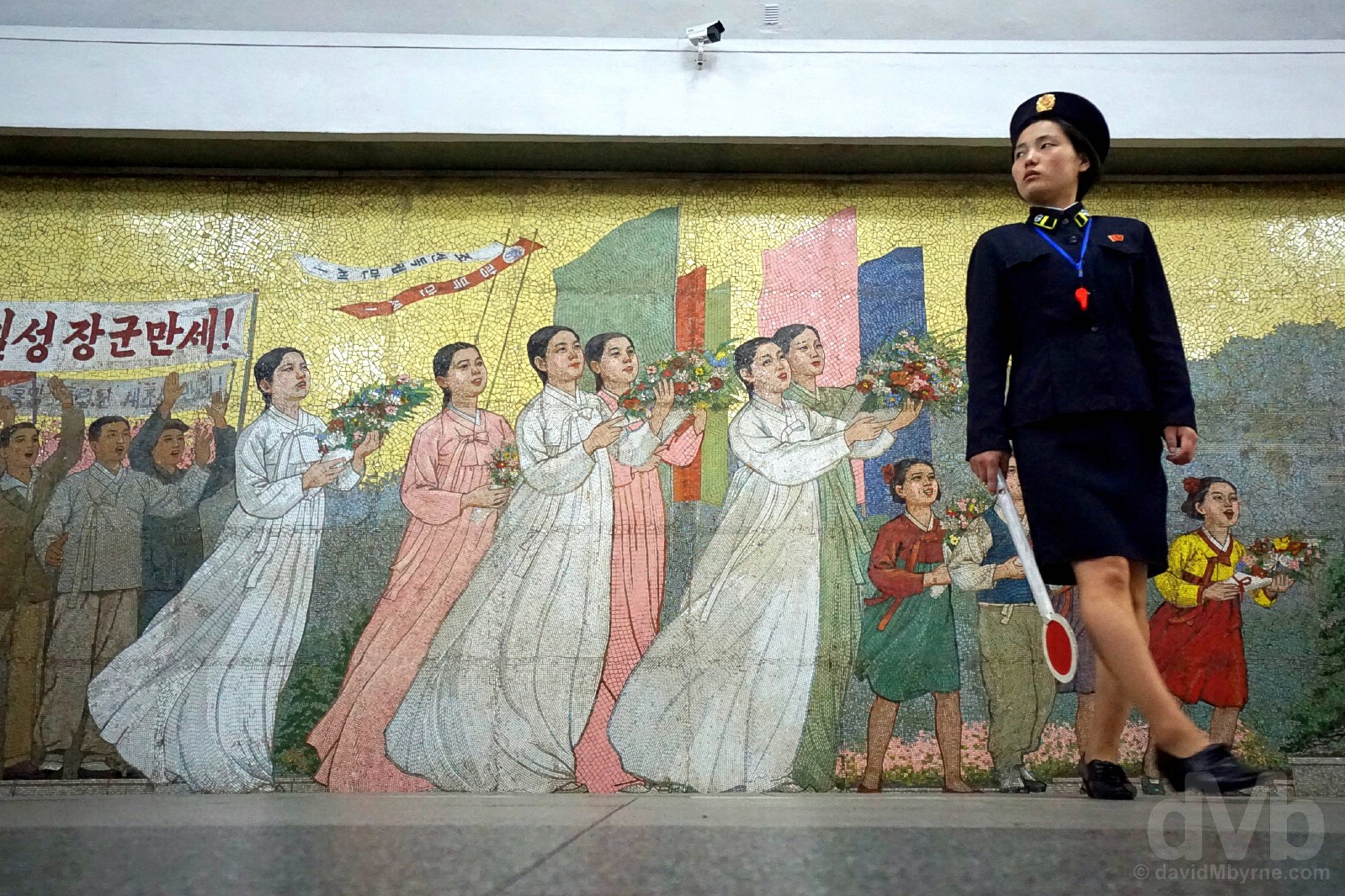
DAY 2 11:09 – KAESON STATION – On the platform of Kaeson Station of the Pyongyang Metro, Pyongyang, North Korea. August 15, 2017.
I only saw three, but seemingly each of the Pyongyang Metro system’s 16 stations are visually unique, and all are ultra-nationalistic in theme. Murals, statues, bronze plaques and mosaics promoting socialist efficiency and accomplishment while depicting anti-US rhetoric to impressionable commuters are standard inside most stations. Entitled ‘Victory over Japan Day’, the 30-metre-long mosaic on the platform of Kaeson Station, part of which is seen here, commemorates the independence of Korea in 1945. As impressive as the mosaic was, it was the attendant that caught my attention – I noticed her but she was adept and ignoring/looking right through me. Decked out in a military-style uniform (as with all public service roles in North Korea), these stony-faced attendants are found on each platform and move in a purposeful and militaristic manner, raising their paddles with each arriving and departing train.
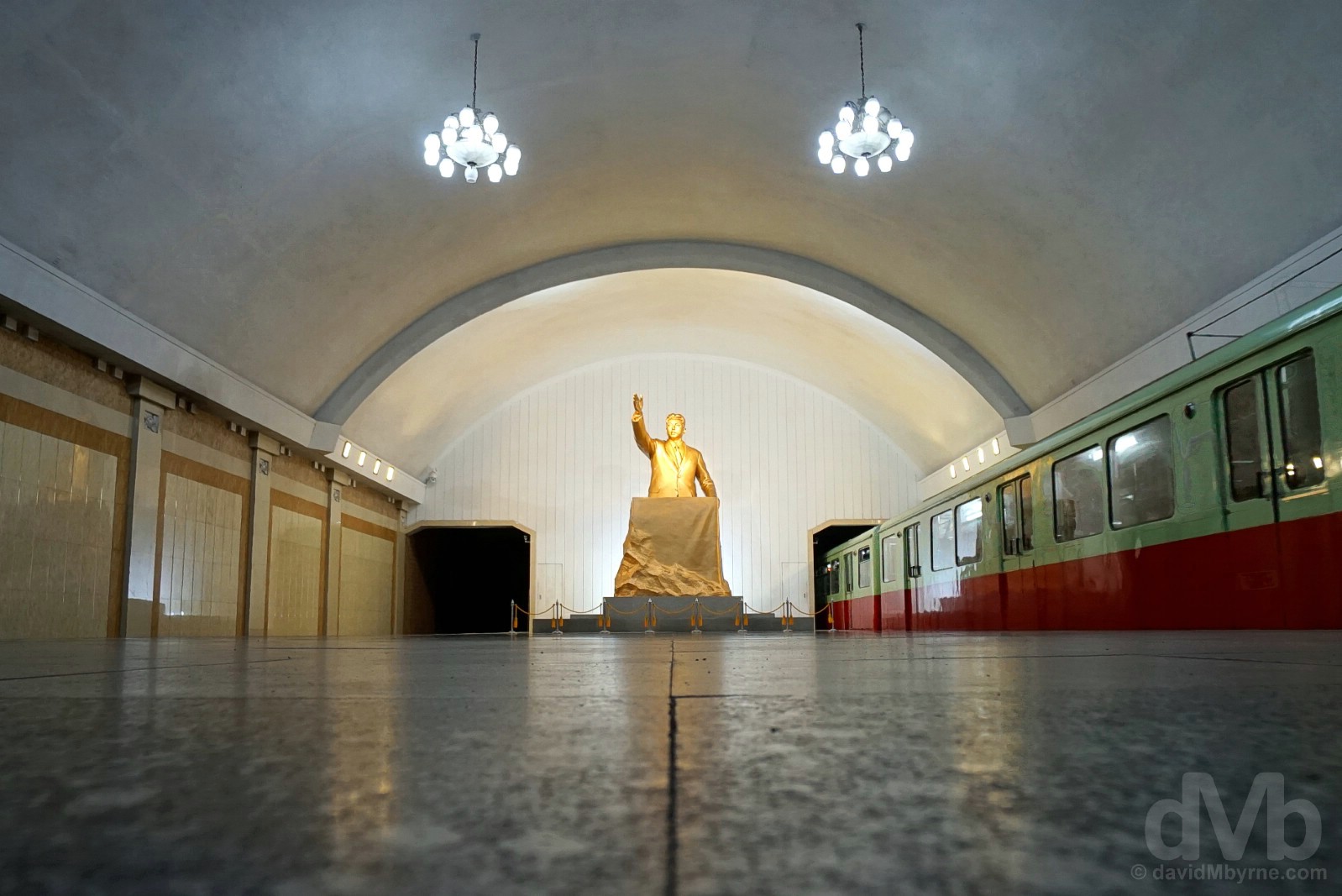
DAY 2 11:11 – A gleaming Kim Il-sung statue on the platform of Kaeson Station of the Pyongyang Metro, Pyongyang, North Korea. August 15, 2017.
While the platform of Kaeson Station was just as polished as the others, it wasn’t as impressively illuminated. That said, there was no lack of light at the end of the platform, the gleaming gold statue of the main man, Kim Il-sung, unmissable.
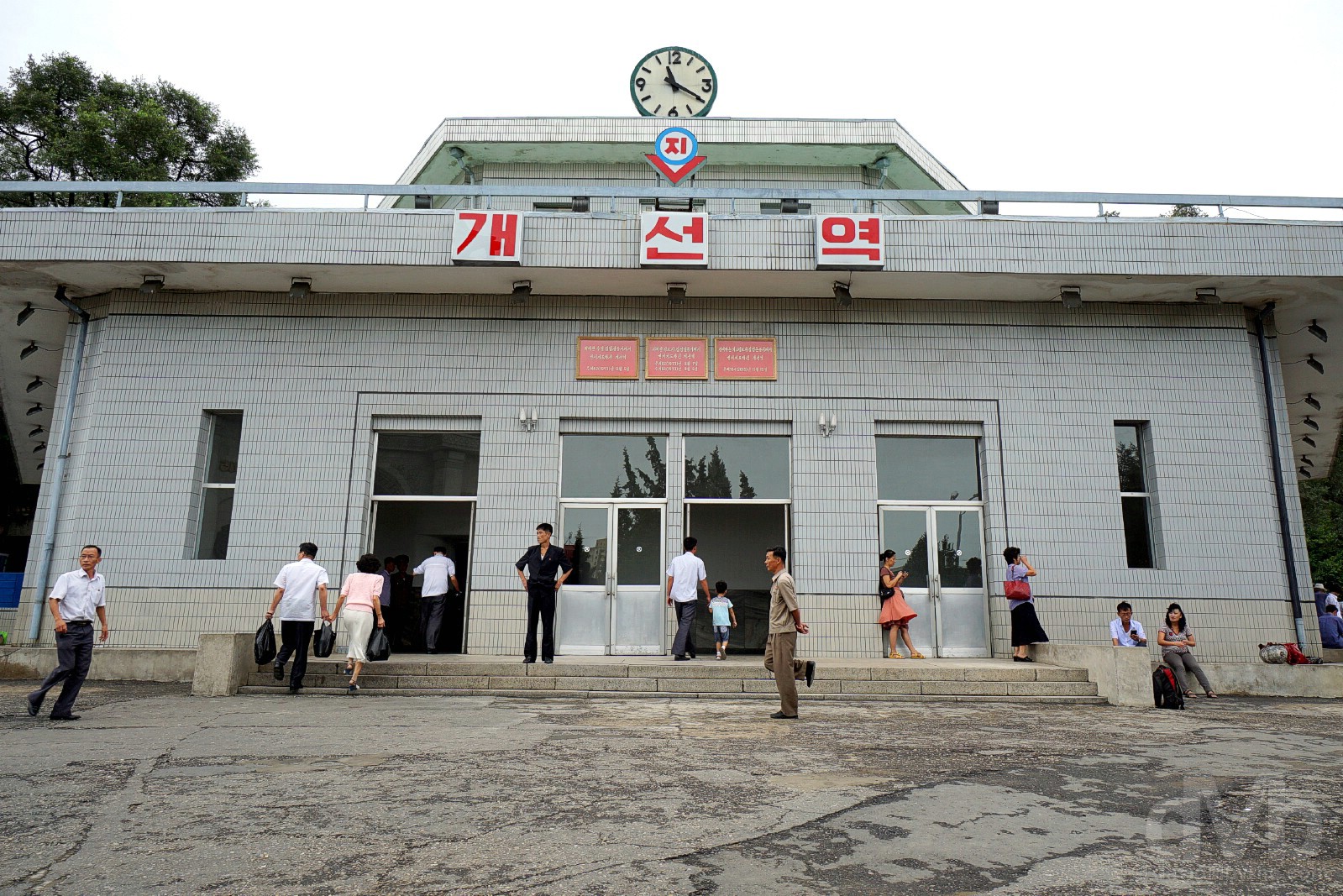
DAY 2 11:20 – Up for air and back above ground. The entrance to Kaeson Station of the Pyongyang Metro System, Pyongyang, North Korea. August 15, 2017.
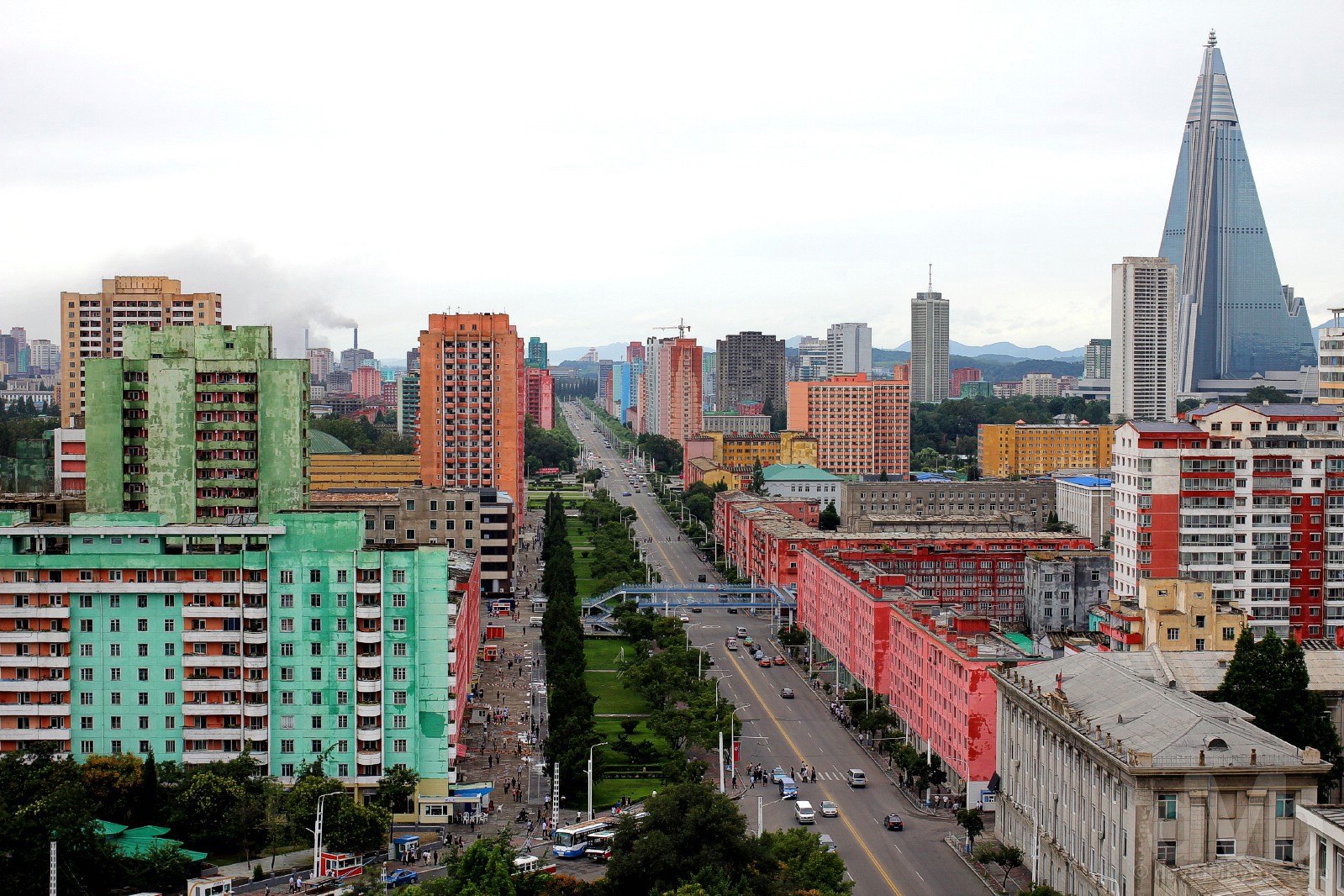
DAY 2 11:43 – PYONGYANG & THE RYUGYONG HOTEL – As seen from the top of the Arch of Triumph, Pyongyang, North Korea. August 15, 2017.
The cavernous innards of the Arch of Triumph were every bit as impressive as its exterior, if a tad hollow; vast spaces with high ceilings and all enclosed by polished & reflective marble walls (it’s almost like filling these vast spaces was an afterthought to the North Koreans). We didn’t have time to watch the 30-minute-long video detailing the history of the Arch that the friendly and traditional hanbok-wearing staff in the base of the Arch wanted us to watch, heading straight for the structure’s viewing platform instead from where the views of the surrounding city were awesome. We weren’t exactly in the clouds and we’d get higher on this day, quite a bit higher, but it was here atop Pyongyang’s most famous replica where I first fully appreciated how much of a one-off this city really is; I’d never experienced an urban sprawl like it. Boxy, ordered, spacious, uncrowded, silent and colourful, a curious and oh-so singular mix of Siberian bland & Caribbean/Cuban pastel. Leveled during the Korean War, the city was rebuilt according to a design reflecting Kim Il-sung’s vision of creating a city, a showcase capital and a living testament to socialist efficiency and accomplishment and one that would boost post-war morale. What I very much doubt was part of The Great Leader’s vision at the time is today the city’s most prominent landmark and easily the tallest building in North Korea, the massive pyramid-shaped, three-winged white elephant that is the 330-metre-tall (1,080 ft), 105-storey Ryugyong Hotel. Planned as a mixed-use development and envisioned by the regime as a channel for Western investors to step into the marketplace, construction started in 1987 but was halted in 1992 when US$750 million had already been spent and when the money ran out due to the economic crisis resulting from the fall of the Soviet Union. At that stage of proceedings the building had topped out, but lacked any interior fittings or windows appearing on the skyline for well over a decade as nothing but a massive concrete shell; a rusting construction crane remained at its apex which the BBC called “a reminder of the totalitarian state’s thwarted ambition”, while the halt in construction, the rumours of problems and the mystery about its future led foreign media sources to dub it “the worst building in the world”, “Hotel of Doom” and “Phantom Hotel.” After 16 years of inactivity, construction by Egypt’s Orascom Group resumed again in April 2008, the firm having entered into a US$400 million deal with the North Korean government to build and run a 3G mobile phone network. Claiming their telecommunications deal was not directly related to the Ryugyong Hotel work, Orascom stated their plan was to, at the very least, give the structure a face lift to make it look both less of an eyesore and finished. Mission accomplished. The exterior was completed in 2011 with dates to open in both 2012 & 2013 subsequently missed. Some claim today that the Ryugong’s top floors are in use, but it’s safe to assume the building remains largely unopened making it far and away the tallest unfinished building in the world, and one that I think, unfinished or no, looks awesome. Nearly always in view (not surprisingly, this was the first Pyongyang landmark I laid eyes on, and from about 20 kilometres outside the city when approaching it on the train), we passed the Ryugong many times during the course of our drives around the city (incredulously given its bulk, it always seemed to sneak up on us), but unfortunately never got out (weren’t allowed out) to take a closer look.
– The Two Koreas, A Contemporary History, Third Edition (p181-182)
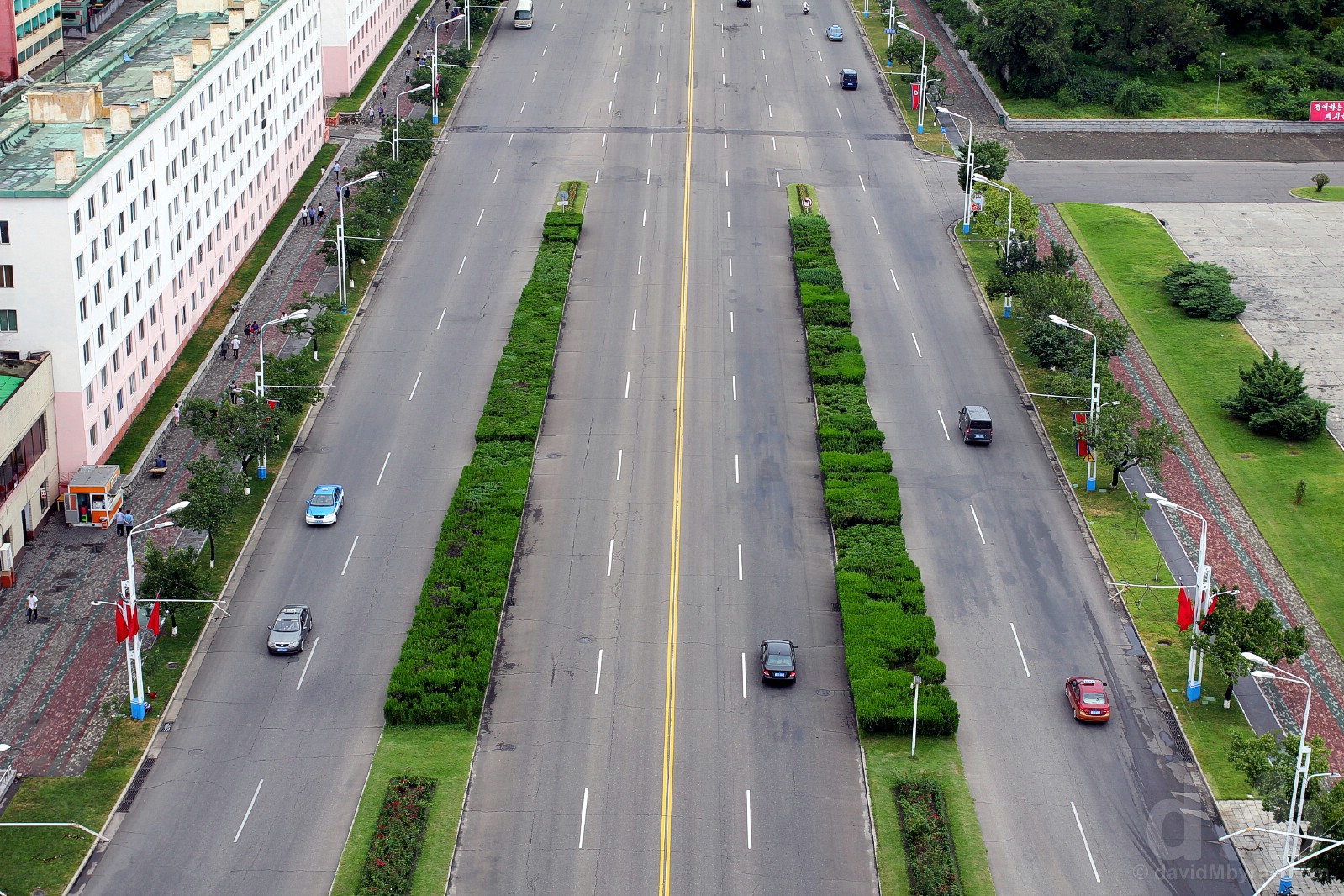
DAY 2 11:47 – EMPTY ROADS – The streets of Pyongyang as seen from the top of the Arch of Triumph, Pyongyang, North Korea. August 15, 2017.
Pyongyang’s streets are laid out in a north-south, east-west grid, giving the city an orderly appearance, the wide, tree-lined boulevards branching out from the Arch of Triumph as empty as all the others. No congestion charges here. According to 2006 figures from the CIA World Factbook, only 3% of North Korea’s roads are paved, or about 730 kilometres of the country’s 25,000-kilometer road network. Needless to say, the bulk of the paved roads are to be found in and around Pyongyang, the showpiece capital.
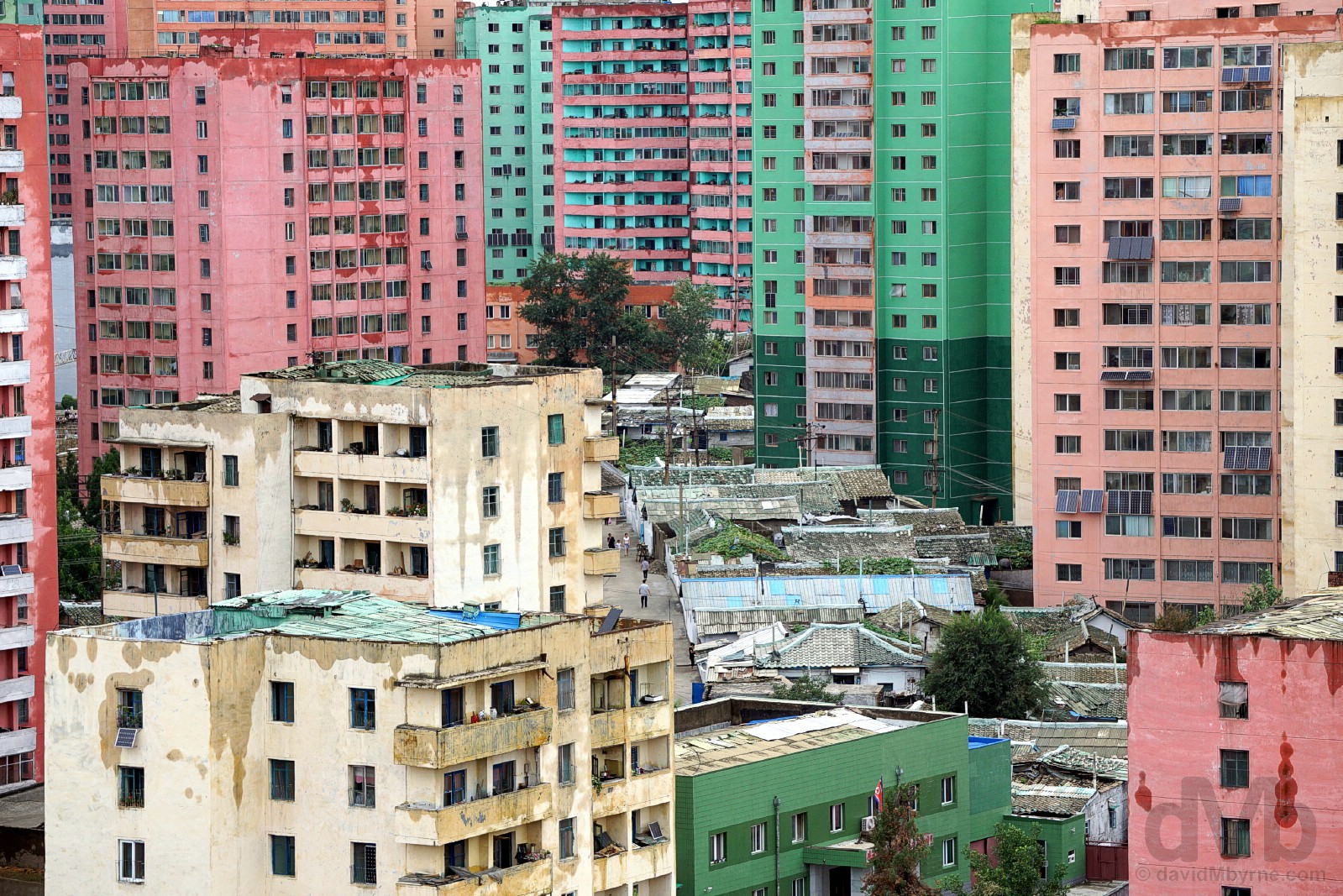
DAY 2 11:53 – PRIVILEGED PYONGYANGITES – Residences as seen from the top of the Arch of Triumph, Pyongyang, North Korea. August 15, 2017.
Some 2.5-3.5 million people live in Pyongyang, North Korea’s showpiece and constitutionally designated as the country’s capital, about one-tenth of the overall population. The privileged one-tenth. It is said only those who show exceptional loyalty to the regime are afforded the luxury of living here, the authorities maintaining a restrictive regime of movement into the city. Inhabitants are mostly divided into administrative units of 5,000 to 6,000 people (dong) and occupy the colourful government-supplied high-rise apartment buildings that dominate the cityscape, most of which date from the 1970’s and 1980’s and which are said to be poorly insulated and lack elevators and central heating. And while the government in 2011 launched a mass construction campaign aiming to build new homes & upgrade others (supposedly in response to Kim Jong-il describing one area as “pitiful”), some residences certainly look like they could do with a spruce up, like this cluster of high-rises & low-rise shacks. Needless to say, a visit to an unkempt residential area of the city, as seen here with the aid of a zoom lens from the lofty heights of the Arch of Triumph, was not on our changeable itinerary no matter how changeable that changeable itinerary was.
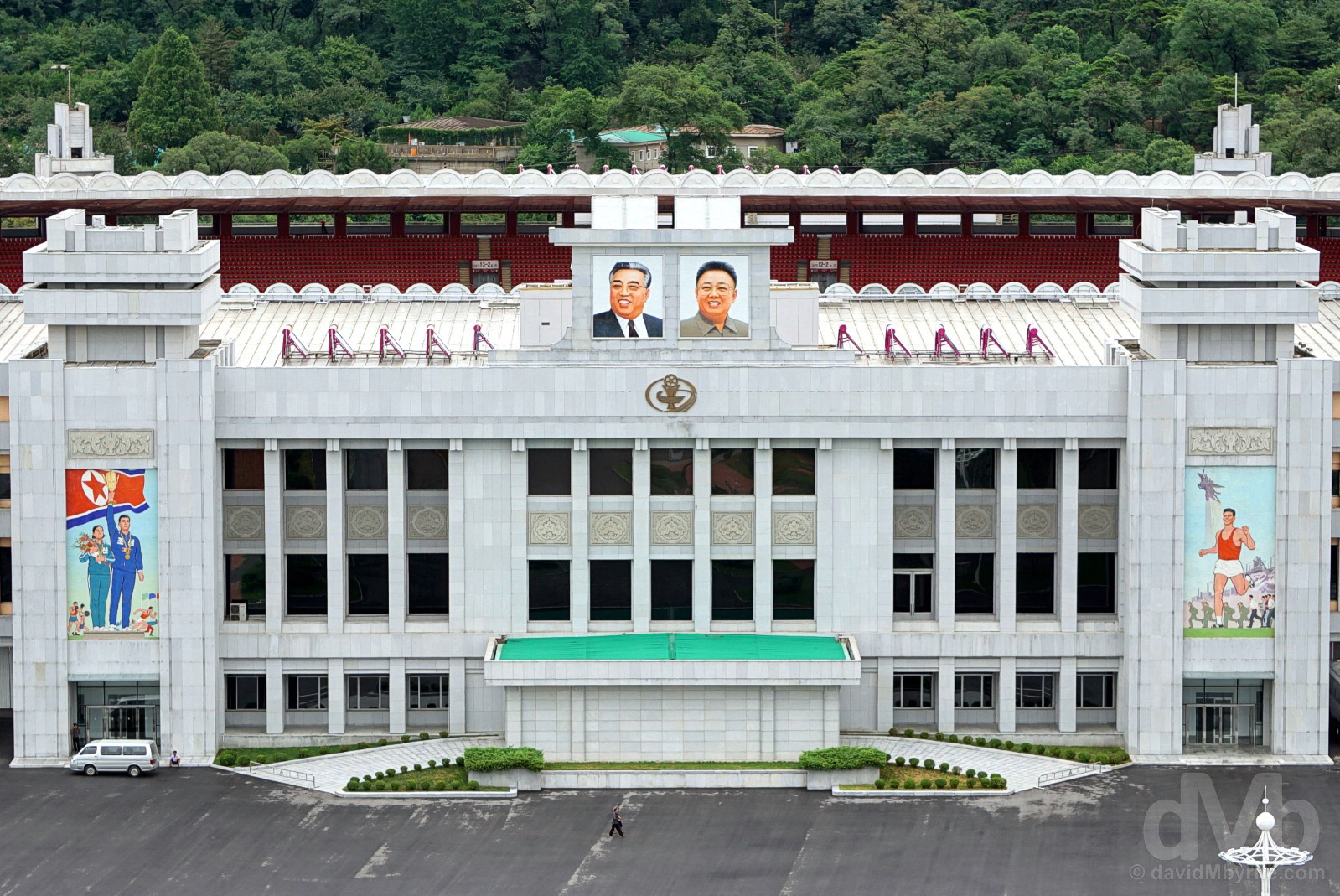
DAY 2 12:01 – KIM IL-SUNG STADIUM – Kim Il-sung Stadium as seen from the Arch of Triumph, Pyongyang, North Korea. August 15, 2017.
With a capacity of 50,000, this is Pyongyang’s forgotten stadium playing second fiddle to the city’s 115,000-capacity Rungrado 1st of May Stadium, the world’s largest stadium (see Juche Tower pictures below). Built in 1926, rebuilt in 1969 following American bombing during the Korean War and renovated in 1982, it is mostly used for soccer, North Korea’s most popular sport; the majority of the national team’s games are played here.
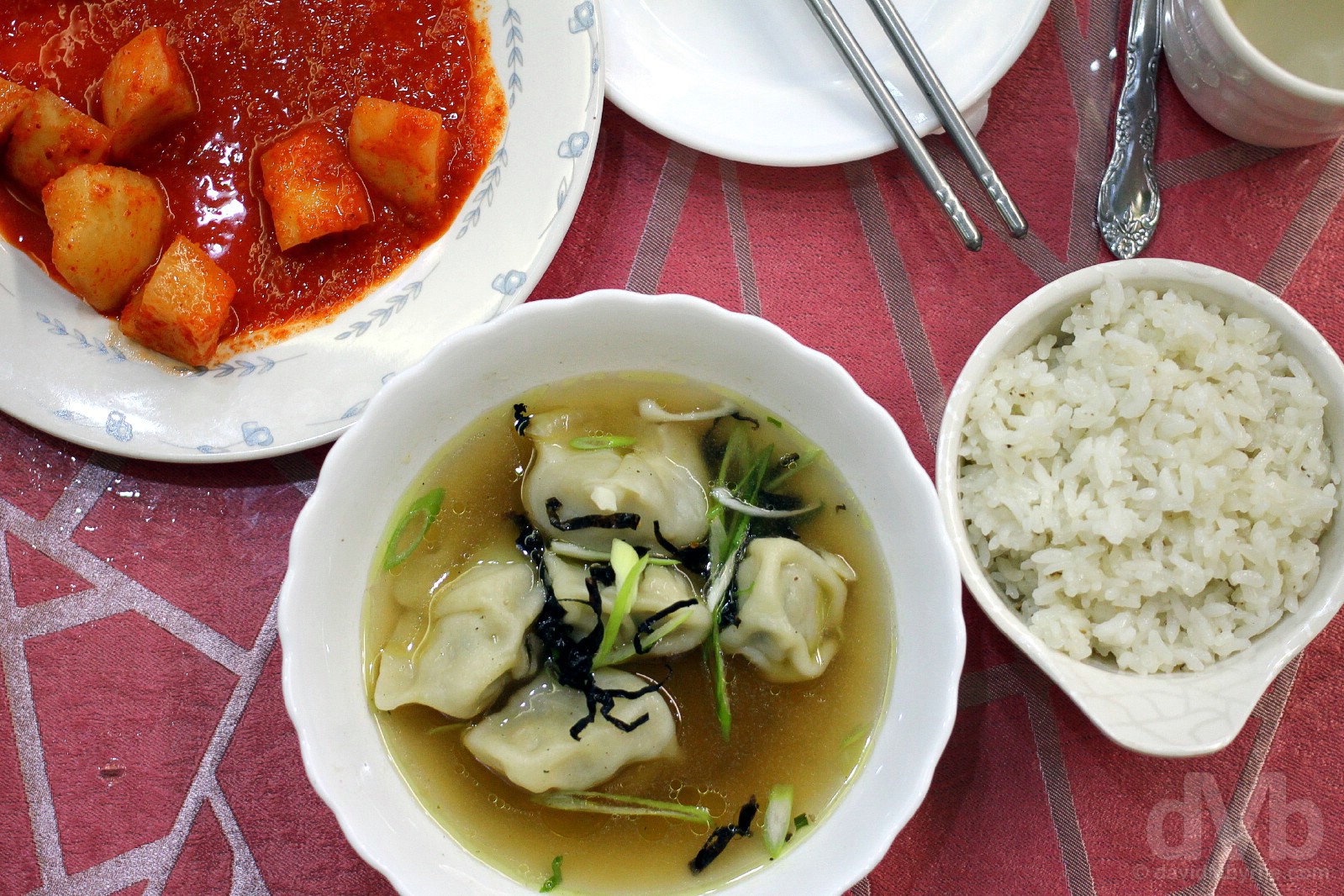
DAY 2 12:55 – LUNCH – Mandu-guk (Dumpling soup), Pyongyang, North Korea. August 15, 2017.
Our second for-foreigners restaurant meal and it was becoming more and more apparent that there are very few restaurants where the average North Koreans go – it seems eating out is a pleasure reserved for foreigners, diplomats etc.
Monument to Party Founding & Cultural Exhibition Centre
IMAGE || Monument to Party Founding, Pyongyang. August 15 2017.
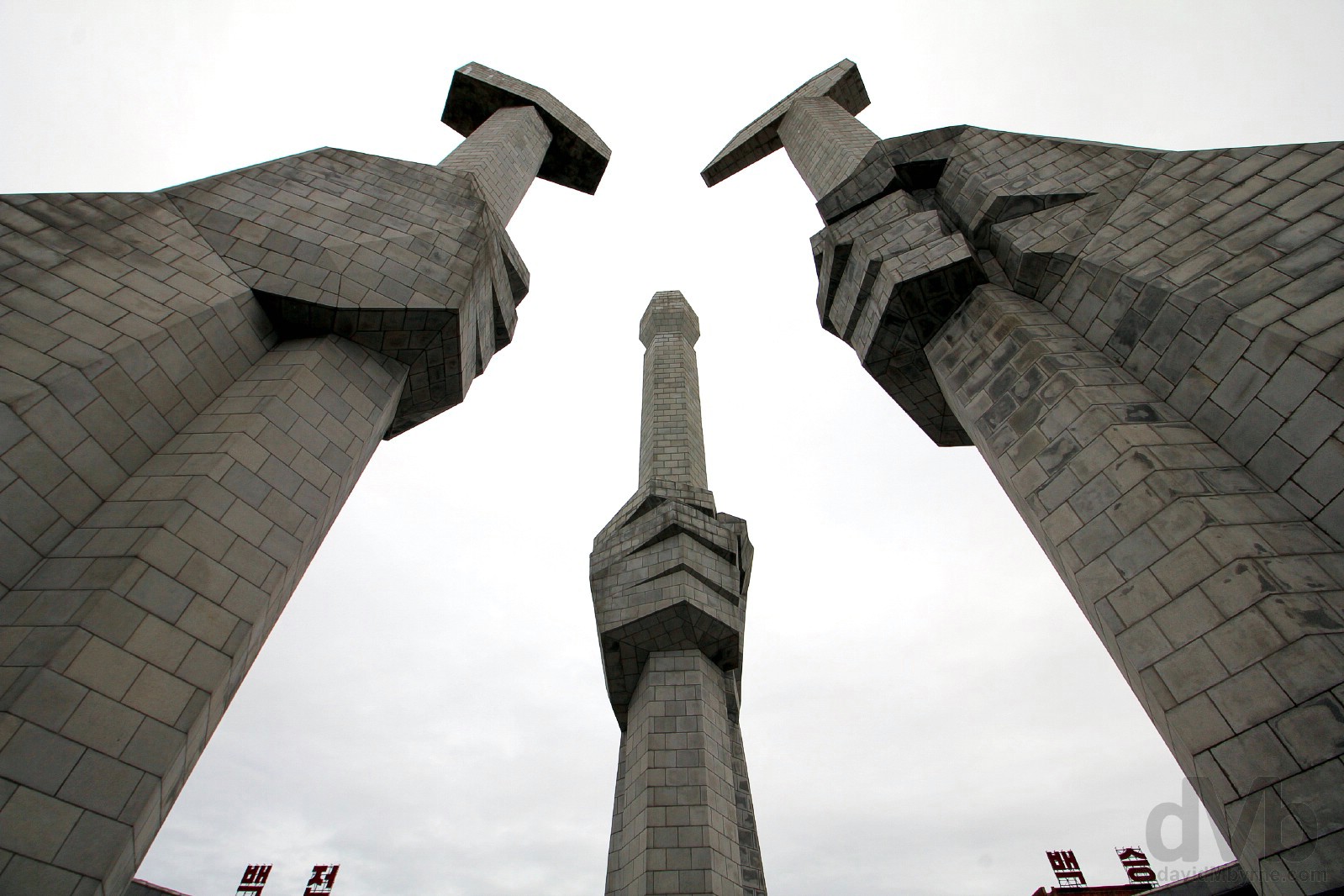
The clinched fist hammer (left), calligraphy brush (centre) & sickle (right), the three tools that form the insignia on the flag of the ruling Workers’ Party of Korea, towering above the Monument to Party Founding in Pyongyang, North Korea. August 15, 2017.
– The Two Koreas, A Contemporary History, Third Edition (p15)
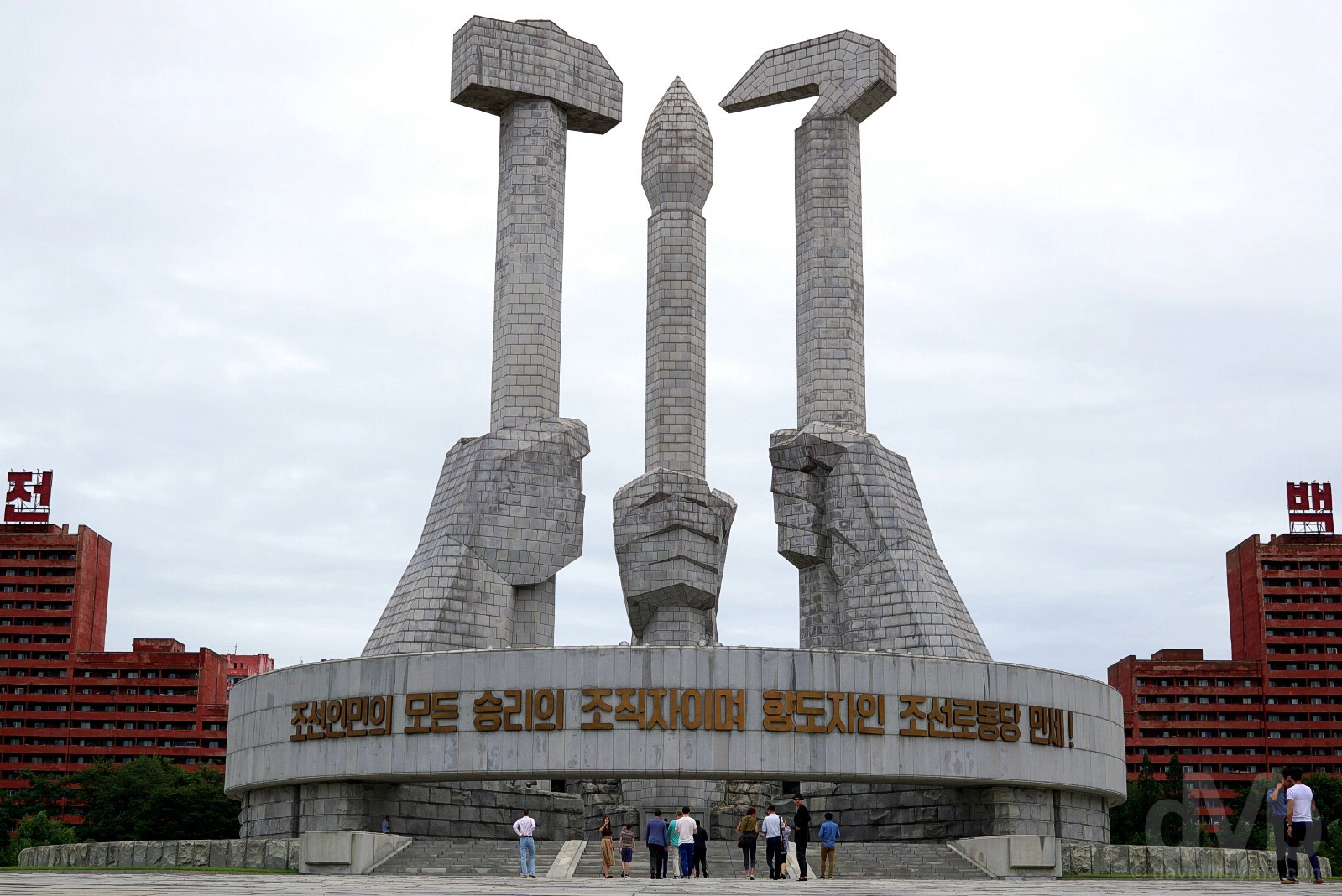
DAY 2 14:01 – MONUMENT TO PARTY FOUNDING – Our tour group atthe base ofthe towering Monument to Party Founding, Pyongyang, North Korea. August 15, 2017.
OK, so let’s get the symbolism out of the way. The massive hammer, sickle & calligraphy brush signify workers, farmers and intellectuals respectively, the three pillars of the state. It’s 50 metres high as it was completed on October 10 1995, the 50th anniversary of the foundation of the ruling Workers’ Party, a definitive deadline for completion if ever there was one. The number of slabs comprising the belt on the lower reaches of the monument (216) and its inner diameter (42 metres) signify Kim Jong-il’s date of birth, officially February 16 1942 (although the Russians contest he was born on the same date in 1941). Finally, the monument’s 70-metre base diameter signifies the 70-year history of the party from the days of the Down-With-Imperialism Union, or DIU (founded in October 1926 by Kim Il-sung while in exile in China in order to fight against Japanese imperialism and to promote Marxism–Leninism, it is considered to be the root and foundation of the Workers’ Party of Korea). As for the lettering. On the monument itself the lettering on the belt roughly translates to “Long live the Workers Party of Korea, which organizes and guides all victories for the Korean people!” while the two red (supposedly) waving flag-shaped buildings flanking the monument display lettering which reads “Ever Victorious”. It’s all very big. It’s all very symbolic. It’s all very impressive.
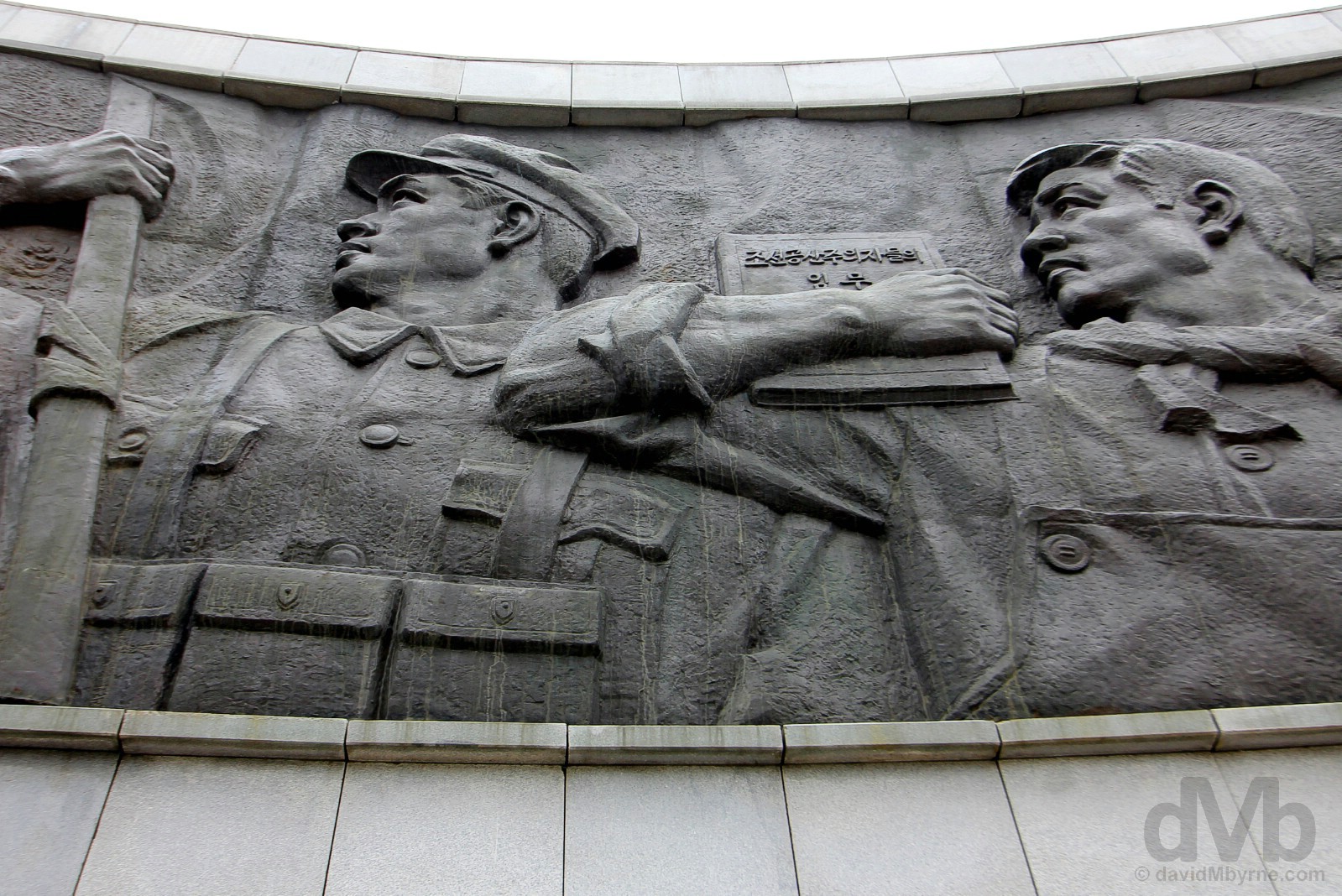
DAY 2 14:11 – Monument to Party Founding, Pyongyang, North Korea. August 15, 2017.
But wait, there’s more. Visible from the centre of the monument, where even a wide-angle lens comes up short (this is fisheye territory), three massive bronze reliefs on the inner belt – itself said to signify the single-hearted unity of the leader, Party and people – also ooze symbolism. Covering the history of the party, this is a portion of a relief said to be depicting “the glorious revolutionary traditions of the Workers’ Party of Korea” during the pre-independence armed anti-Japanese struggle.
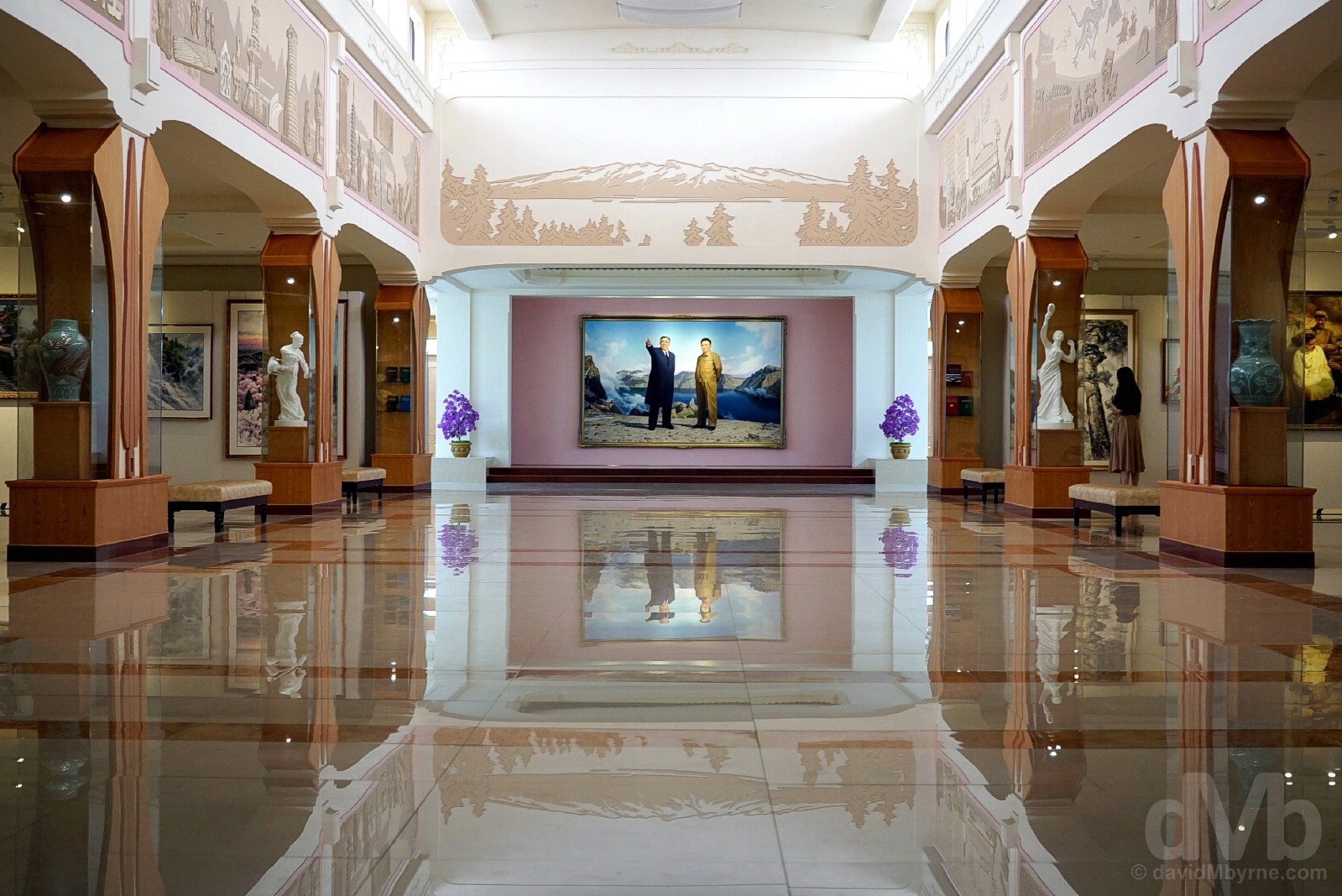
DAY 2 14:34 – CULTURAL EXHIBITION CENTRE – Cultural Exhibition Centre, Pyongyang, North Korea. August 15, 2017.
A short walk from the Monument to Party Founding was the Cultural Exhibition Centre. Part museum, part library, part art gallery and part photo gallery, it was mostly, and not surprisingly, a showcase for the Kims displaying as it did both written works by and picture of the leaders. Pictures weren’t allowed in here and we were followed to ensure we’d comply. I still managed a few shots, mostly pictures of pictures. Also, there was no way I was leaving without getting a picture of the highly polished and reflective floor, one I doubt stays anyway begrimed for very long, if at all, and a surface one might genuinely feel guilty traversing (I kinda did).
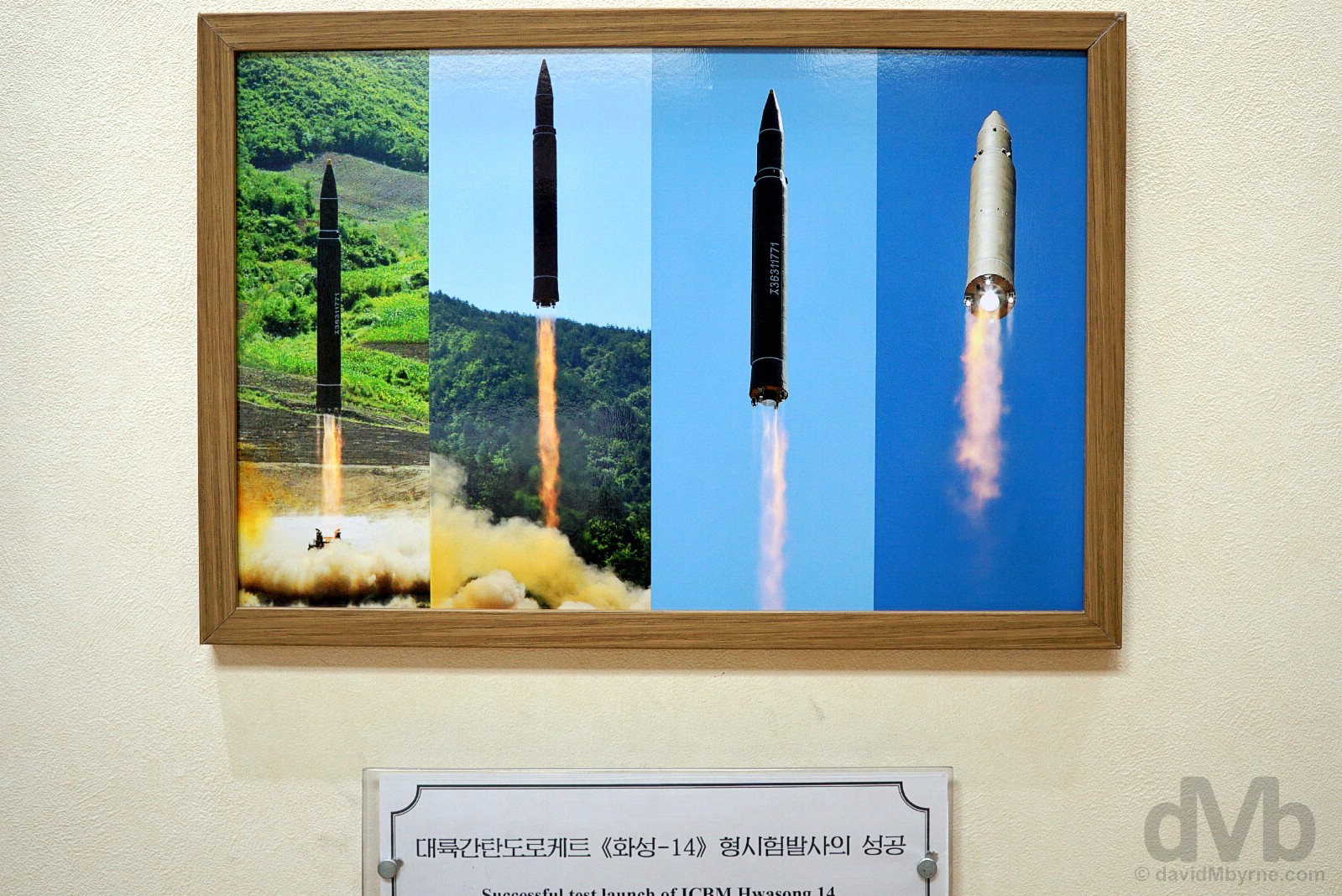
DAY 2 14:38 – HWASONG 14 – Cultural Exhibition Centre, Pyongyang, North Korea. August 15, 2017.
A point, shoot and hope effort here saw me missing the entire caption, but it’s still discernible – ‘Successful test launch of ICBM Hwasong 14’. The most recent development in the on-going soap opera that is the North’s nuclear and ballistic missile programme, Hwasong 14, a DPRK-developed mobile intercontinental ballistic missile (ICBM), was first successfully launched only 42 days earlier, on July 4, American Independence Day (yep, lots more symbolism in here also). Widely condemned by the international community, the launch was a moment of national pride for North Koreans. A picture beside this one showed a delirious Kim Jong-un, standing in front of a massive & highly polished fine-wood boardroom table in the middle of a field in the middle of nowhere and with a pair of binoculars in hand, high-fiving his general at the successful launch, a picture that was no doubt widely distributed to the masses by state media at the time. I’d would have loved to capture a picture of that particular picture, but decided to quit while I was ahead and make for the door instead.
– The Two Koreas, A Contemporary History, Third Edition (p194)
– Headline in Rodong Sinmun, the official press of the Workers’ Party of Korea
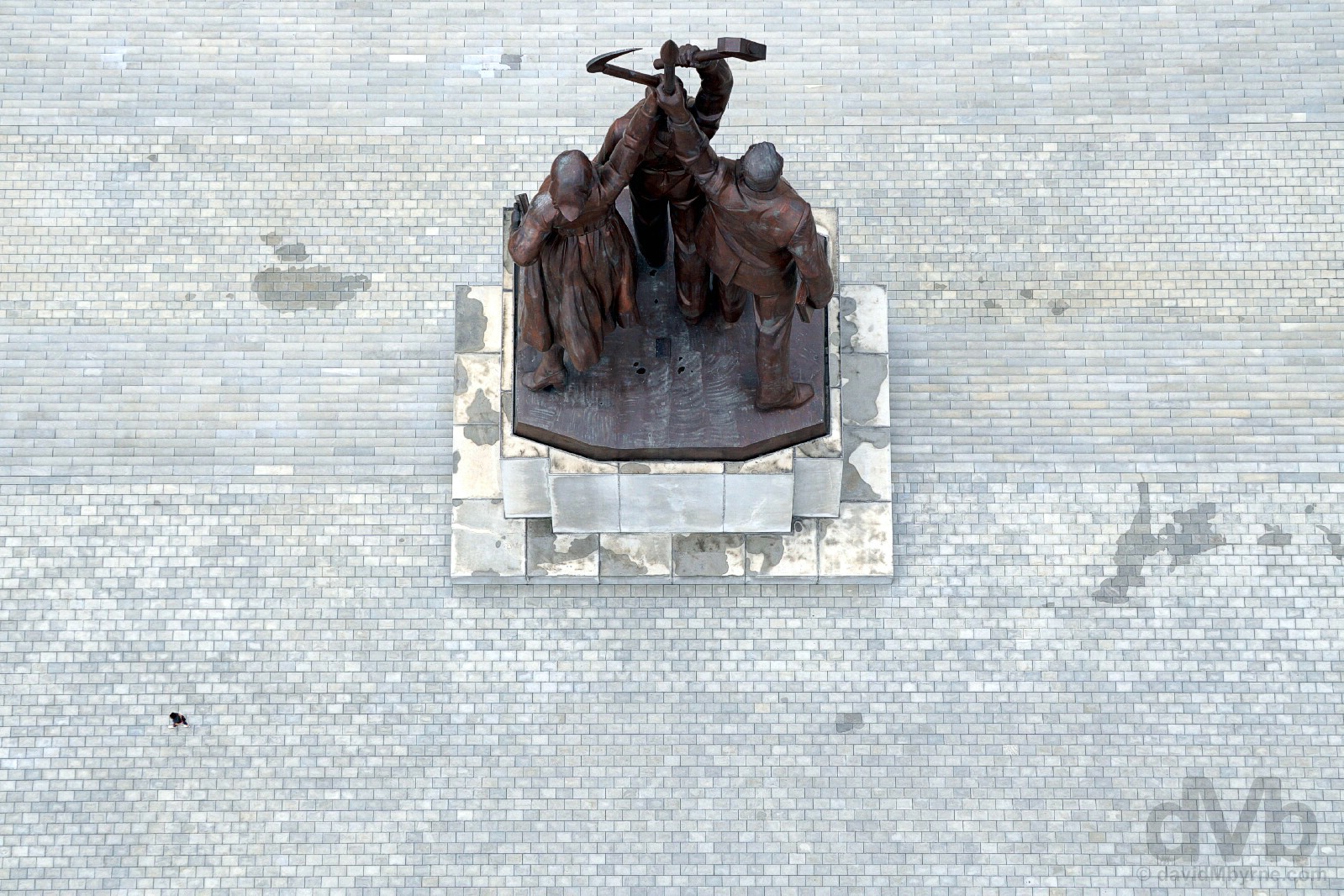
Looking small walking by the Workers’ Party Monument at the base of the Juche Tower as seen from the viewing deck near its apex. Pyongyang, North Korea. August 15, 2017.
Juche
I’ll happily confess to not knowing a whole lot about Juche prior to visiting North Korea. Once here it’s unavoidable – it’s Juche this, Juche that, Juche the other. The closest thing officially atheist North Korea has to a religion, Juche, roughly translating to ‘self-reliance’, is the national ideology, North Korea’s very own brand of unique and not-for-export Confucianist-tinged communism. Developed by Kim Il-sung as the Marxist-Leninist socialism model he wanted for his nation, one inspired by but distinguishable from both Soviet & Chinese philosophies, Juche is the cornerstone of the state’s ultra-nationalism, not to mention its isolation, and an ideology that was routinely added to and/or altered in order to justify governing decisions (Dictator’s prerogative, I guess). Ignoring the fact that Juche is a myth (North Korea has never been self-reliant, surviving entirely on Moscow for economic support from its formation in 1948 right up until the USSR collapse in 1991, after which the North Korea’s state-run economy fell apart and its people starved in huge numbers), the ideology still controls every aspect of everyday life for everyday North Koreans. It therefore comes as no surprise that the state capital also has a physical manifestation of their ideology, the city’s pointy 170-metre-high Juche Tower. Just the latest mammoth and heavy-on-symbolism Pyongyang landmark we were to visit on this day, it was to be the highest of all our Pyongyang highs.
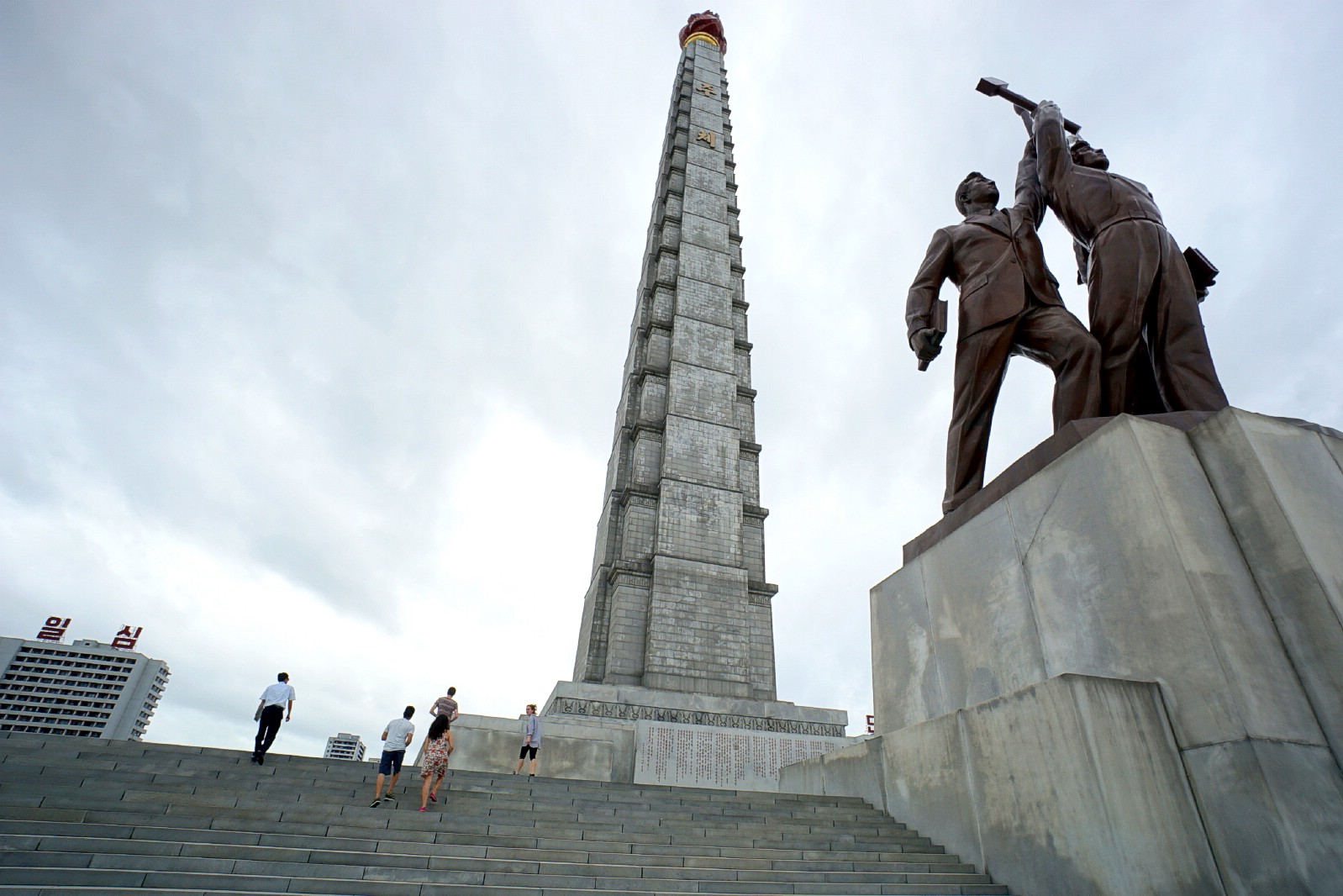
DAY 2 15:08 – JUCHE TOWER – The Workers’ Monument at the base of the 170-metre-high Juche Tower in Pyongyang, North Korea. August 15, 2017.
Yet another Pyongyang landmark that was built in 1982 to commemorate Kim Il-sung’s 70th birthday and with a design officially accredited to his son Kim Jong-il (I smell a rat), the 170-metre-tall Juche Tower was, and just like the Arch of Triumph, built with the aid of 25,550 blocks, one for each day of the Great Leader’s life up to the occasion of his 70th birthday. Topped by a 20-metre-high, 45-ton illuminated metal torch, the tapering granite spire itself is 150 metres high making it the tallest granite structure on earth and the second-tallest monumental column in the world (after the 173-metre-high San Jacinto Monument in Texas). But, and more importantly, the overall structure is taller, albeit by less than a metre, than the Washington Monument in Washington D.C., itself the world’s tallest stone structure and after which the Juche Tower is said to have been modelled. The massive 30-metre-high bronze Workers’ Monument fronting the tower is yet another shout-out to the ruling Workers’ Party, showing as it does three idealised figures holding a hammer, a sickle and a brush. You probably get the idea by now.
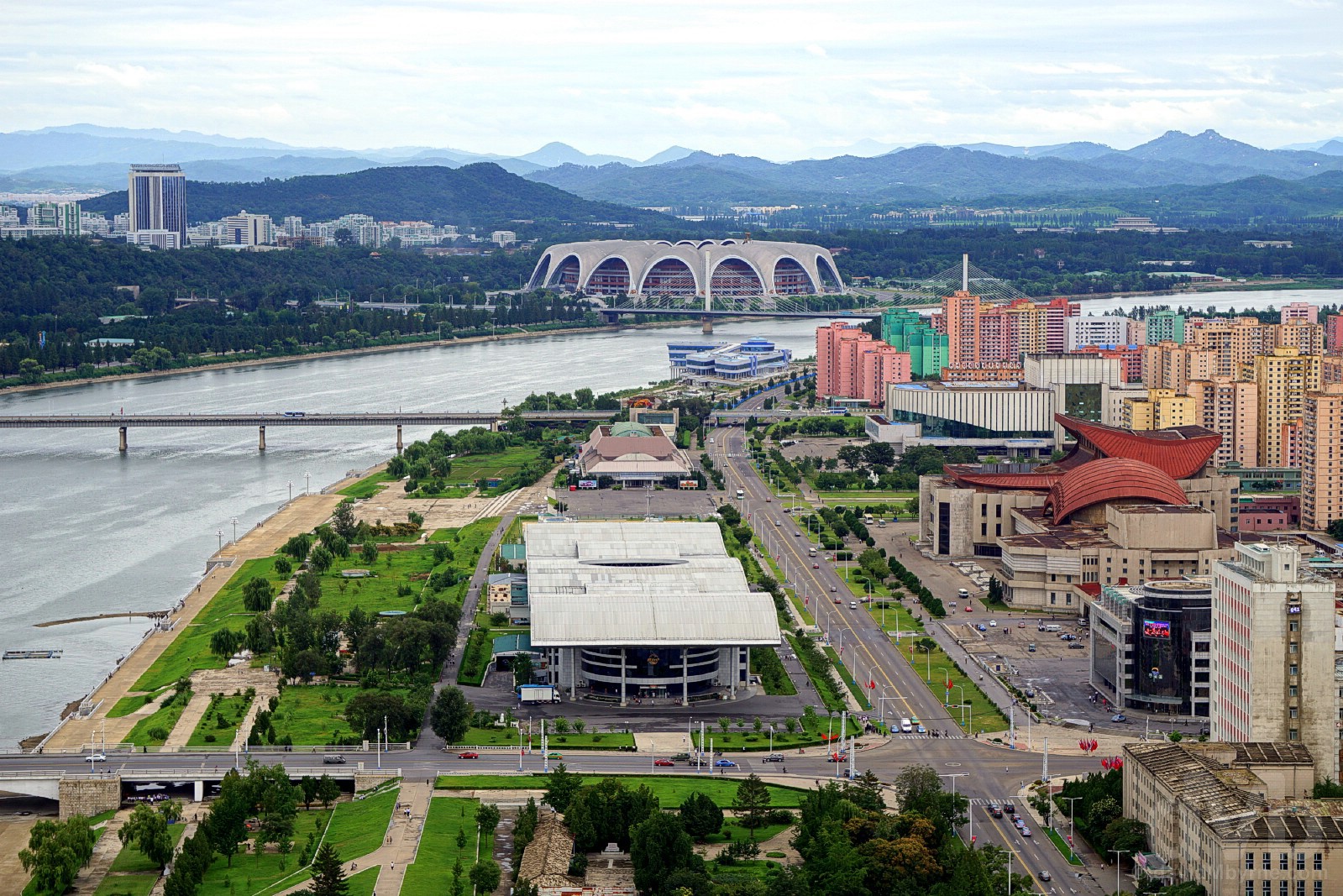
DAY 2 15:21 – JUCHE TOWER VISTAS – The Taedong River, Northern Pyongyang and the Rungrado 1st of May Stadium, the world’s largest, as seen from the viewing deck of the Juche Tower, Pyongyang, North Korea. August 15, 2017.
The tower’s impressive elevator does a good job of delivering people to its viewing deck located atop the granite but below the torch. Needless to say the views were epic, loftier & more expansive but less intimate views of the city than the views we were afforded from atop the Arch of Triumph earlier in the day. This is a view looking north towards the distinctive form of the Rungrado 1st of May Stadium. Built in the late 1980’s and with a distinctive 16-arch scalloped roof arranged in a ring to resemble a magnolia blossom, it can accommodate 115,000 spectators making it the largest stadium in the world. A multi-use venue, it gets little use these days as most sporting activity takes place in the city’s smaller Kim Il-sung Stadium. Apart from its all-conquering capacity, the stadium is known as the location for the (mostly) annual Arirang Festival performances, a.k.a. the Mass Games, a massive choreographed politicised gymnastics and artistic performance celebrating Kim Il-sung and the North Korean nation, a logistical masterpiece in artistic ability and choreography and an unmatched visual extravaganza involving some 100,000+ participants that has been recgonised by the Guinness Book of Records as the largest of its kind in the world. An annual event that was staged in late summer between 2002 and 2013 (although there was no event in 2006), it has only been held once since (in 2015) with future of the events somewhat in doubt, something I find surprising given how proud North Koreans are of their performing arts, not to mention how impressive a spectacle it is in marketing the country overseas.

DAY 2 15:30 – A panorama looking across the Taedong River towards Kim Il-sung Square & western Pyongyang as seen from the top of the Juche Tower in Pyongyang, North Korea. August 15, 2017.
The fountains in the Taedong River were on today, although – and damn – I can’t say I noticed them being on yesterday evening when we were waking through Kim Il-sung Square (seem here in the centre of the shot). I’m not sure of this is mid-afternoon Pyongyang normality or not. Surely they wouldn’t turn them on for our benefit, would they?
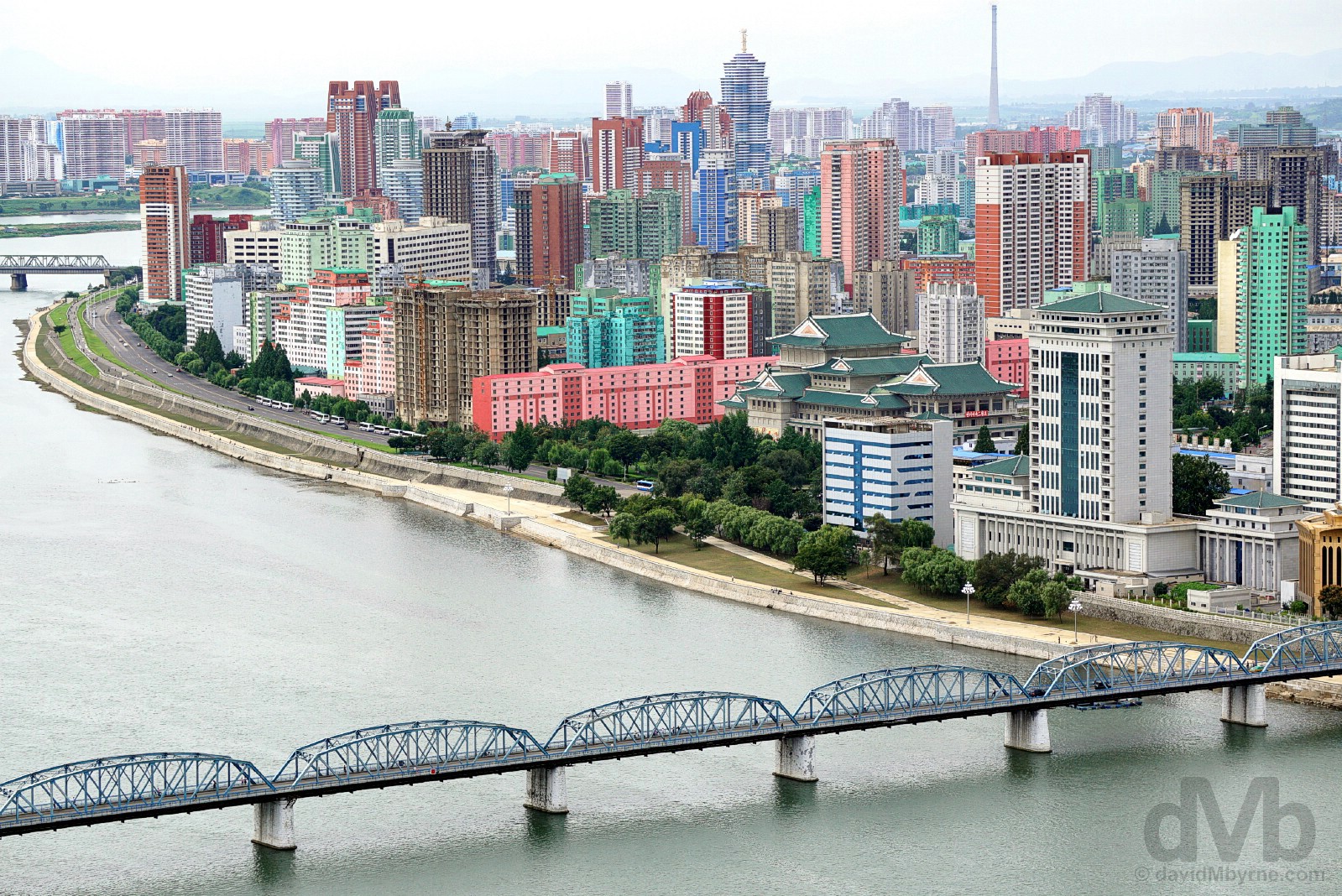
DAY 2 15:32 – Looking southwest across the Taedong River as seen from the top of the Juche Tower, Pyongyang, North Korea. August 15, 2017.
A large riverfront traditional Korean-style edifice adds a little touch of Asia to a district of boxy, Soviet-looking Pyongyang high-rises.
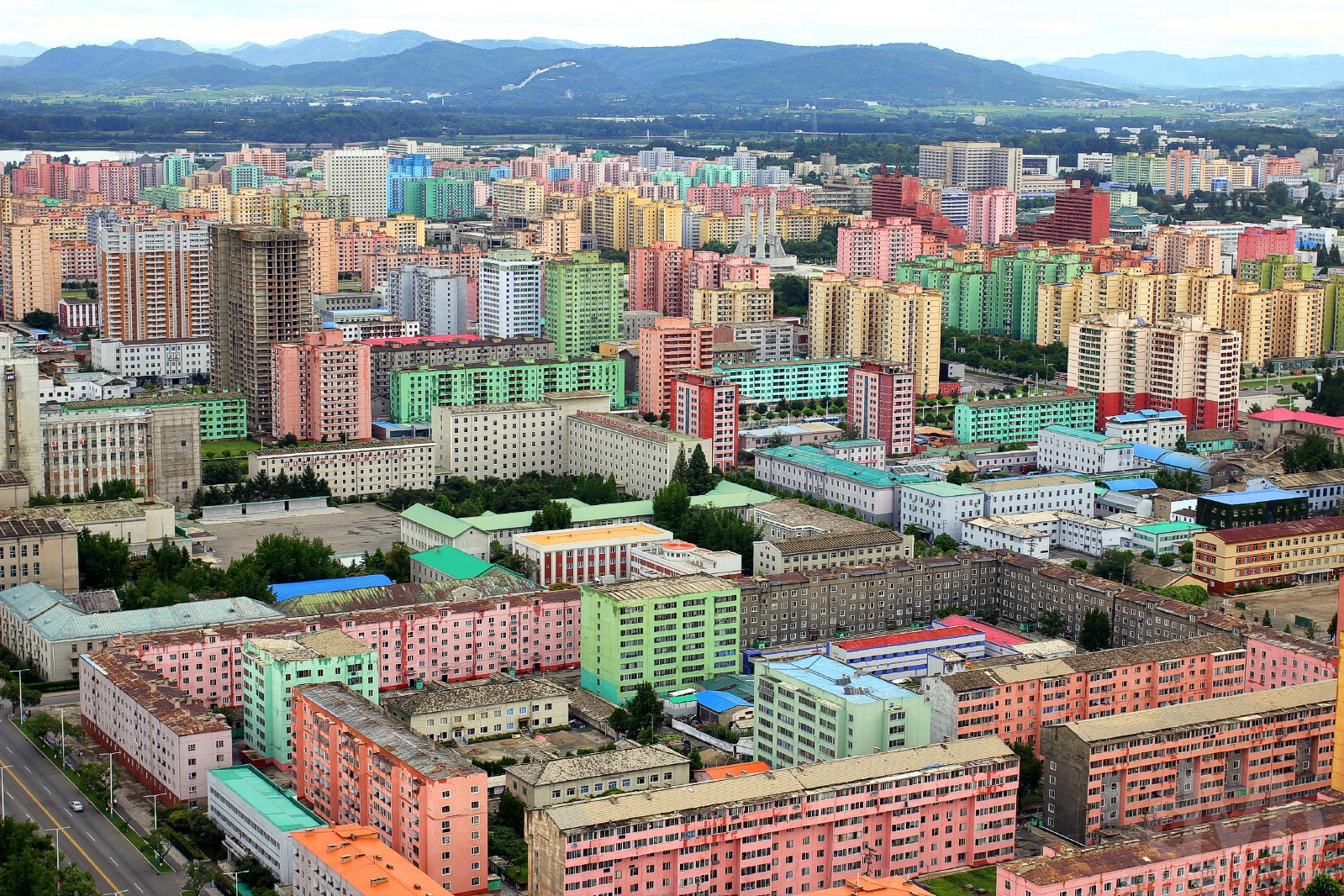
DAY 2 15:35 – LEGOLAND – Looking beyond the colourful residential complexes to the fringes of the city as seen from the Juche Tower in Pyongyang, North Korea. August 15, 2017.
The elevation of the Juche Tower means you can clearly seen the outskirts of the North Korean capital, the colourful mass of residential high-rises seen here (spot the Monument to Party Founding among the awesomely unique Legoland-esque cityscape) eventually giving way to the countryside. It’s not that far away, showing just how compact a city it really is. Ordered and visually unique it may be, but sprawling it ain’t.
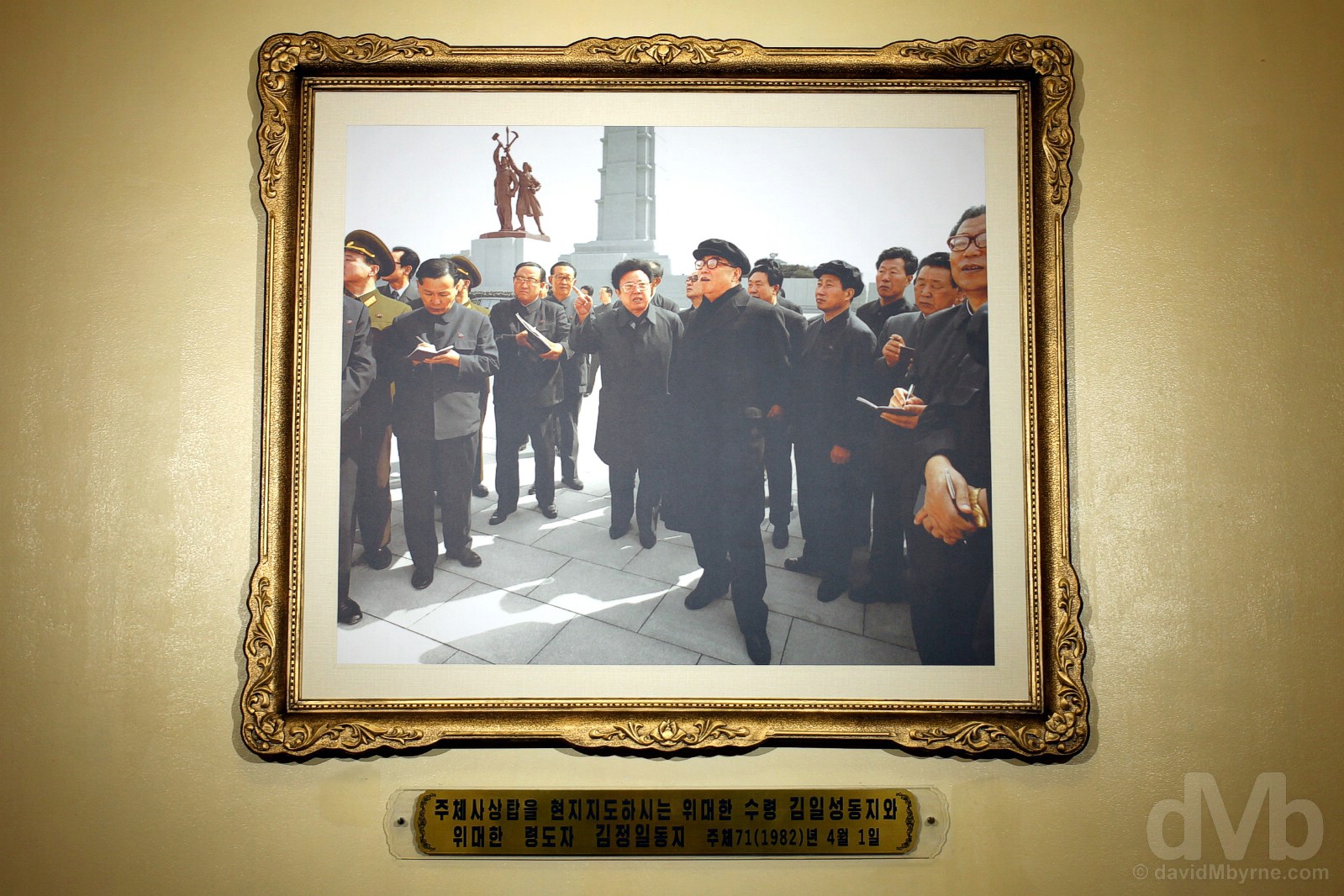
DAY 2 15:46 – A picture on display at the base of the Juche Tower showing Kim Il-sung, The Great Leader, & Kim Jong-il, The Dear Leader, at the Juche Tower shortly after its opening in 1982 (Juche 71). Juche Tower, Pyongyang, North Korea. August 15, 2017.
Back at ground level, the base of the Juche Tower displayed various pictures of the city & the leaders, pictures one was allowed to photograph. Pictures like this, of the revered leaders inspecting factories, educational facilities, agriculture plantations or military installations, regularly appear in present-day media publications just as if they’re current events and even though The Great Leader – President for life remember – has now been dead for over 23 years, The Dear Leader dead for almost 6 years.
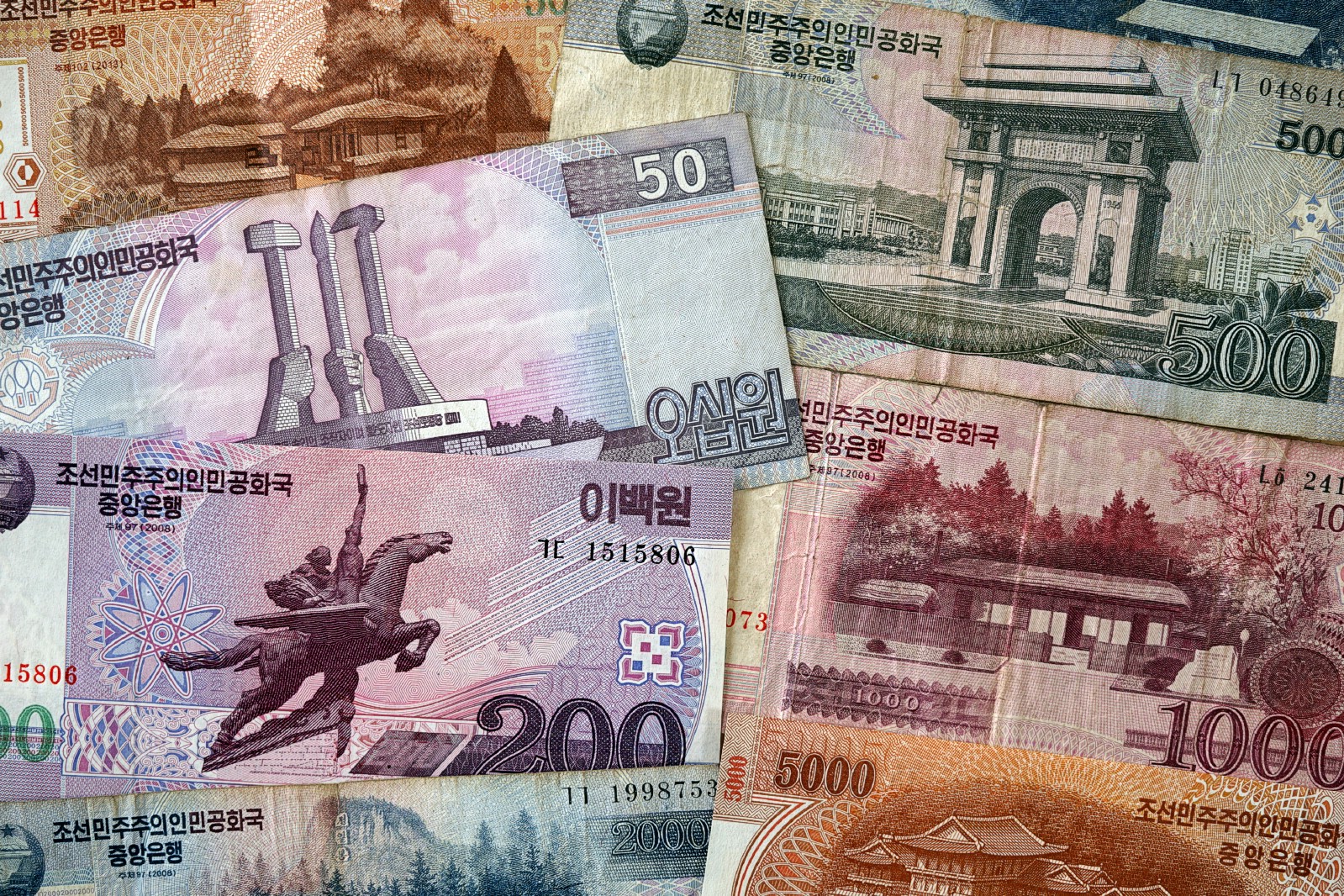
DAY 2 16:20 – NORTH KOREAN WON (KPW) – North Korean Won (KPW). Bought to buy with in the Kwangbok Department Store but retained as a souvenir.
Kwangbok Department Store
With an average wage in North Korea of less than €10 a month, dependence on the State is an accepted part of life for the majority of everyday North Koreans. Needless to say, shopping options are limited. Several government-run markets & department stores, where prices are extremely low by Western standards, do exist, selling a wide range of foods & consumer goods such as shoes and DIY materials to the middle & upper classes. We visited the Kwangbok Department Store where cameras were not allowed (we were told to leave our cameras on the bus). Thus, I have no pictures of its 3-level interior, somewhere you can stock up on mostly imported goods and local produce. All manner of goods really; the Kwangbok curiously reminded me of Walmart, a one-stop shopping local selling everything you might need, although none of it carried a capitalist brand (I searched high & low for a familiar logo among the clothes of the 2nd floor, a pair of Made-in-God-Only-Knows-Where Aiddias runners/sneakers making me do a double take). A hangout for the Pyongyang middle & upper classes, I’m not sure if the locals being consumers in the Kwangbok Department Store (& there were plenty of them) were actually spending money or cashing in their government-supplied tokens, or both – North Koreans are issued State provisions which vary according to their job/status, all men, for example, receiving a certain weekly allocation of beer from the regime. The thrill for me of the Kwangbok Department Store, famous throughout North Korea as the venue for Kim Jong-il’s final public appearance in 2011, was being able to roam freely (we were given 45 minutes) while shopping with North Korean currency, obtained through changing Euros at a little booth on the ground floor. My only outlay, my only purchase in North Korea with North Korean currency was a KPW1,500 (€0.16) slice of sponge cake from the third floor food court, it eating into the KPW48,000 I received for handing over €5 downstairs (there is, and as of August 2017, approximately KPW9,000+ to the €). Although it’s legally not permitted to take North Korean currency out of the country, I held onto the rest of my KPW as a souvenir, before heading outside for some fascinating people watching in view of the massive screen on the facade of the department store blaring revolutionary images and anthems. Sitting there waiting for the rendezvous time to roll around while simultaneously lamenting the lack of pictures I’d have to show from this particular experience, it (& the time spent in the department store itself) was one of only two moments when in North Korea that I was free of the group and the guides, only the second time I felt even a modicum of independence when of course in reality I was anything but independent. In a way I could understand how the North Koreans fall for this.
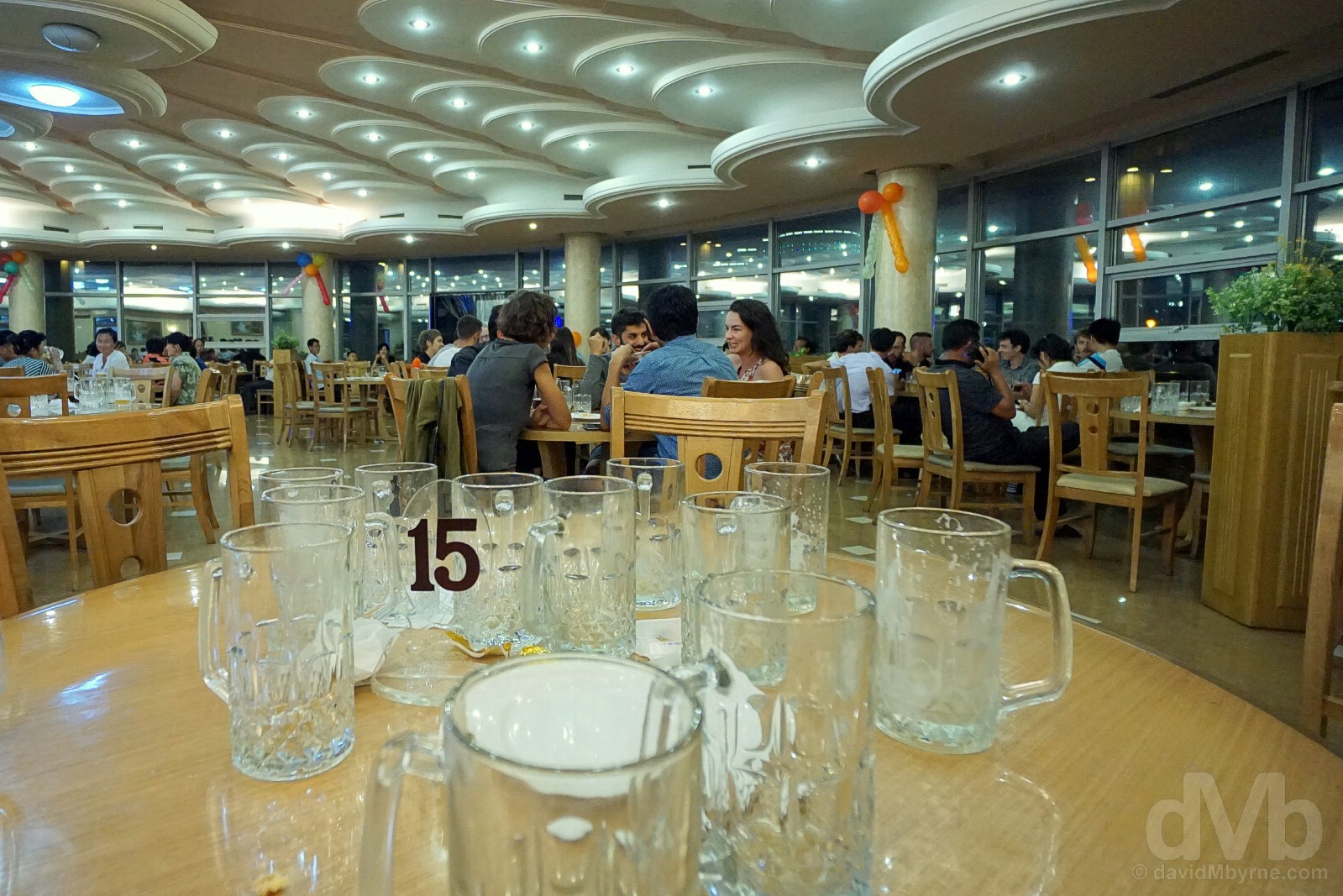
DAY 2 19:30 – NORTH KOREAN CRAFT BEER ‘BAR’ – Glasses on table 15 void of craft beers. Pyongyang, North Korea. August 15, 2017.
It sounded better than it was, the reality of drinking craft beer among North Koreans in a North Korean ‘bar’ falling well short of the vision sold. The company was good and the chocolate-infused craft beer even better, but the rice beer was my favoured tipple among the various brews on tap (there’s a thriving microbrewery culture in North Korea, a country that seems to like its beer just as much as its southern neighbours do). It’s just that the setting was more sterile cafeteria, resplendent with cafeteria trolley ladies, less bar. If this is indeed a real North Korea bar then I guess they don’t really do bars in North Korea, which in hindsight didn’t really surprise me.
Kaeson Youth Park & Dinner
IMAGE || Riding The Tower in Kaeson Youth Park, Pyongyang. August 15 2017.
We lingered at the ‘bar’ longer than planned (as I said, the beer was good), most of us assuming we’d drank into and beyond our allocated funfair fun time. But no, not quite. Our last outing of Day 2 proved to be one of its most memorable and, along with the earlier visit to the Kwangbok Department Store, the one which had us questioning most the seemingly fabricated aspect of Pyongyang life as presented to foreigners. Can hundreds, many thousands, of seemingly normal and fun-loving North Koreans enjoying the thrill of an amusement park really be fabricated? Would they go to those lengths just for our benefit, to peddle a perception? Of course not, but that’s the frame of mind one adopts when experiencing and simultaneously trying to make sense of North Korea, and especially when one visits somewhere as everyday normal as Pyongyang’s Kaeson Youth Park.
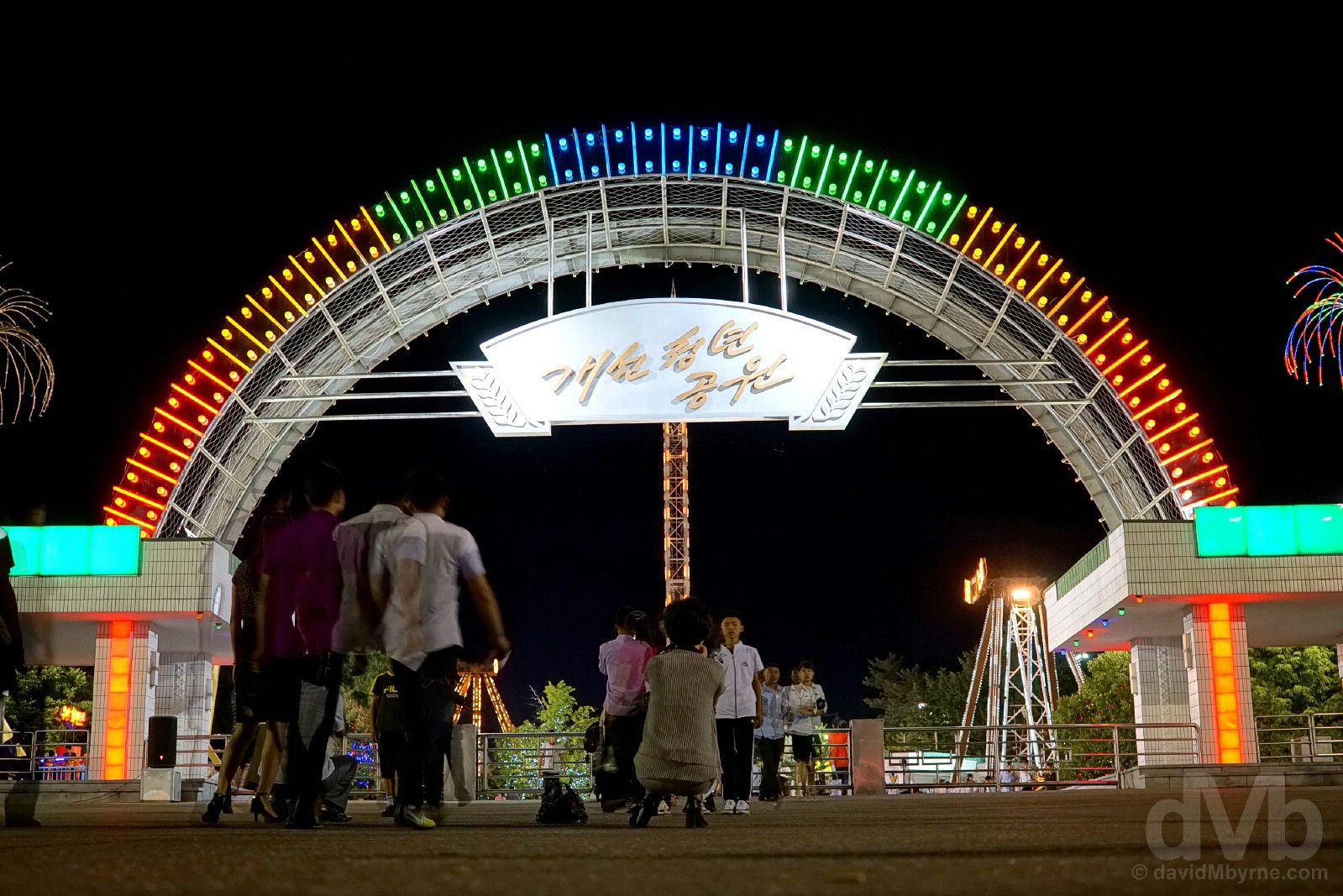
At the entrance to the Kaeson Youth Park, Pyongyang, North Korea. August 15, 2017.
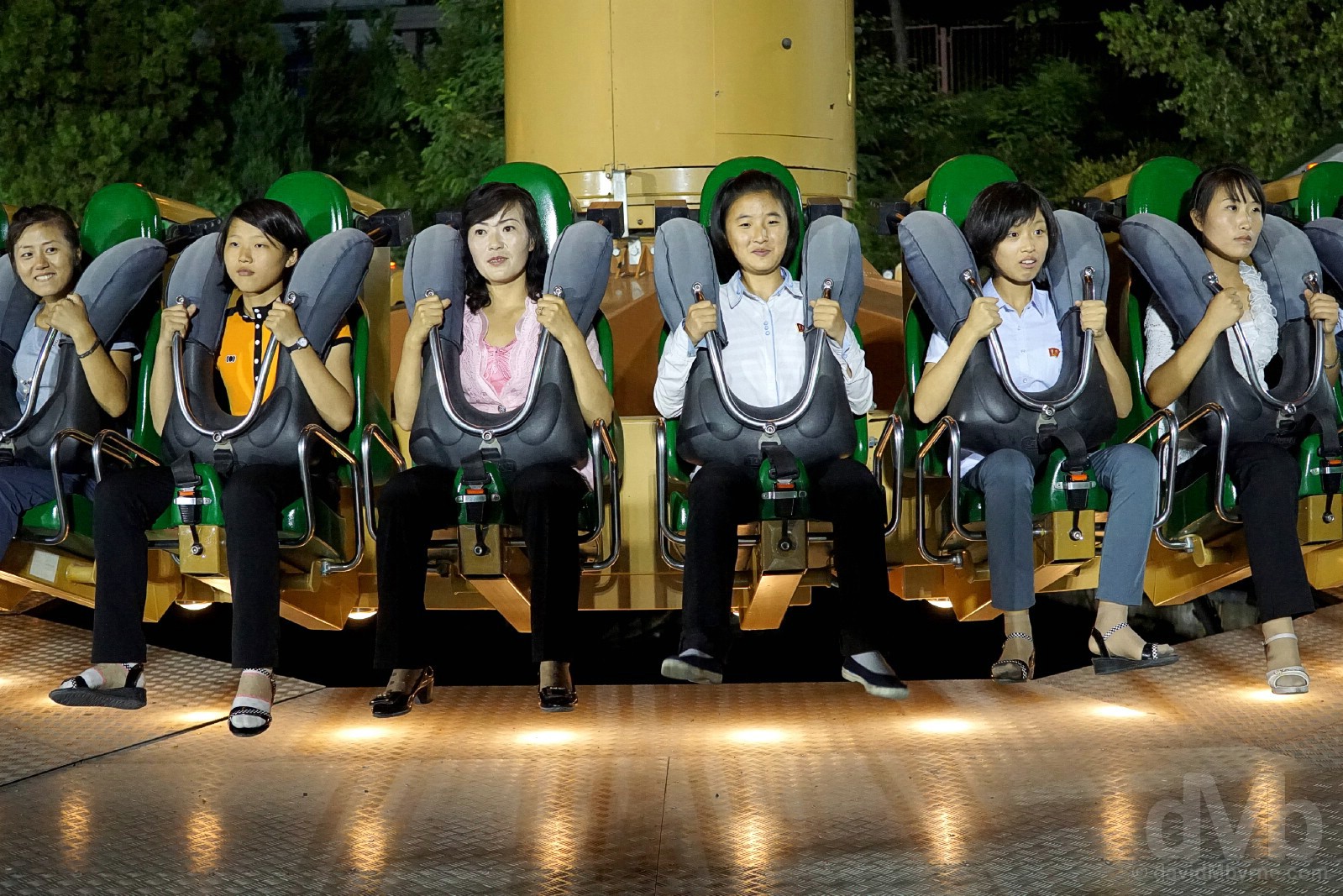
DAY 2 20:13 – KAESON YOUTH PARK – Waiting for takeoff on the Frisbee of Kaeson Youth Park, Pyongyang, North Korea. August 15, 2017.
The 100-acre Kaeson Youth Park originally opened in 1984 but quickly fell into disrepair. Renovated in 2009 and housing various high-capacity gut-churning rides imported from Italy, today it’s back to being Pyongyang’s main amusement park and the most modern of North Korea’s three amusement parks (there are seemingly many more abandoned around the country… the North Koreans do love their amusement parks). We took a walk from one end of the busy park to the other, drawing intense interest from the locals as we went, a curious mix of equally curious queuing adults and wide-eyed children. Our time here was short but we were told that anyone willing to stump up €5 a ride – many, many multiples of what the locals pay (KPW600 I believe, or about €0.05) – would get the VIP treatment and be ushered to the top of the queue. No one did, happy instead to drink in the jovial atmosphere and watch screaming North Koreans as they tried to deal with rapidly increasing and decreasing g-forces. The whole park was a fascinating spectacle. I captured this picture of locals, interestingly all females, waiting for the park’s massive pendulum-like Frisbee attraction to do its thing, their faces a mix of trepidation & contentment.

DAY 2 21:02 – KOREAN BBQ DINNER – Lamb BBQ, Pyongyang, North Korea. August 15, 2017.
You can’t come to Korea, be it North or South, and not have BBQ, even on fleeting visits. It was coming eventually and dinner on Day 2 proved to be a typically-Korean communal BBQ. I might be guilty of being blasé where Korean BBQ is concerned, but the choice of meet on this night was something unexpected. Lamb is rare and expensive south of the border in affluent & pork-loving South Korea, and thus I can only assume that to also be the case in impoverished North Korea. Yes, you eat well in North Korea as a foreigner on a tour. No complaints here.
Day 3
“We didn’t have time to read any of the (I assume propaganda-heavy) displays as we were hastily moved, clock ticking, with military precision from one area of the museum to another, the spectacle of the place coupled with the anti-US rhetoric & economical truths being happily spouted by our guide more that sufficient entertainment.”
IMAGE || The Victorious Fatherland Liberation War Museum, Pyongyang. August 16 2017.
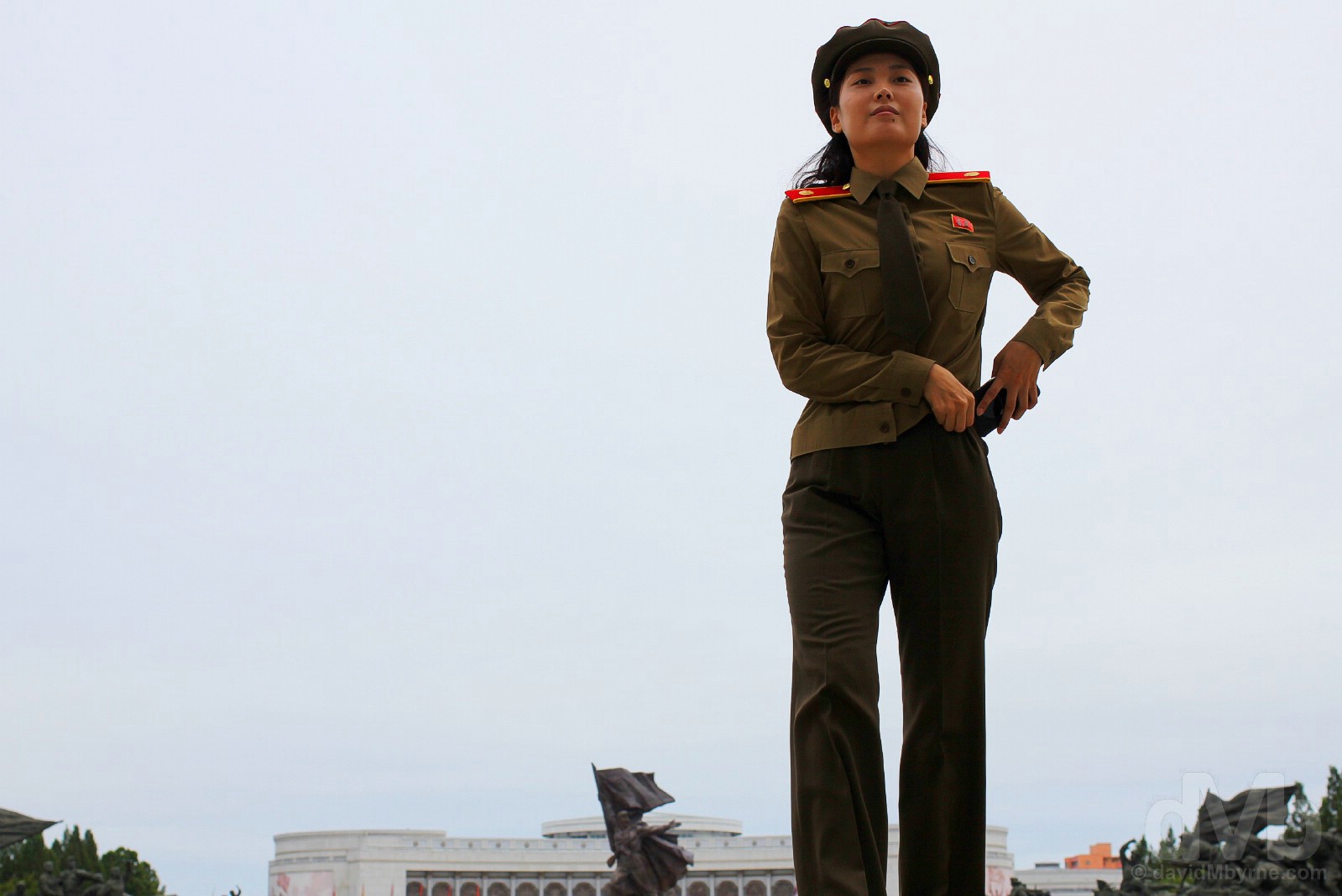
DAY 3 08:25 – MUSEUM GUIDE – Our awesome guide at the awesomely named Victorious Fatherland Liberation War Museum, Pyongyang, North Korea. August 16, 2017.
We had a train to catch but still managed to squeeze in a condensed visit to city’s Victorious Fatherland Liberation War Museum. The museum details the 1950-1953 Korean War which the North Koreans call the Fatherland Liberation War & which I have to assume, given the museum’s name, that they claim they won even though 1) they didn’t and 2) it – the war – is still technically ongoing. The museum occupies yet another awesome Pyongyang edifice that was obviously built to impress. Impress it did, both inside & out, but the highlight of our visit to the showpiece museum was without doubt the guide who chaperoned us through its cavernous halls and up its sweeping marble staircases. She was all business, efficiency personified as she worked to a tight deadline in a bid to whisk us through the highlights of the not-yet-open-for-business-on-this-particular-day museum – it was too early in the day for Joe Public so we had the place to ourselves for the duration of our visit. Her utterance of English was impressive and her spiel memorable, her pronunciation of the word ‘lackeys’ in particular, which she uttered more than once when talking about acts of ‘aggression’ perpetrated by the US and its ‘puppet government’ (South Korea), bringing a smile to my face on more than one occasion.
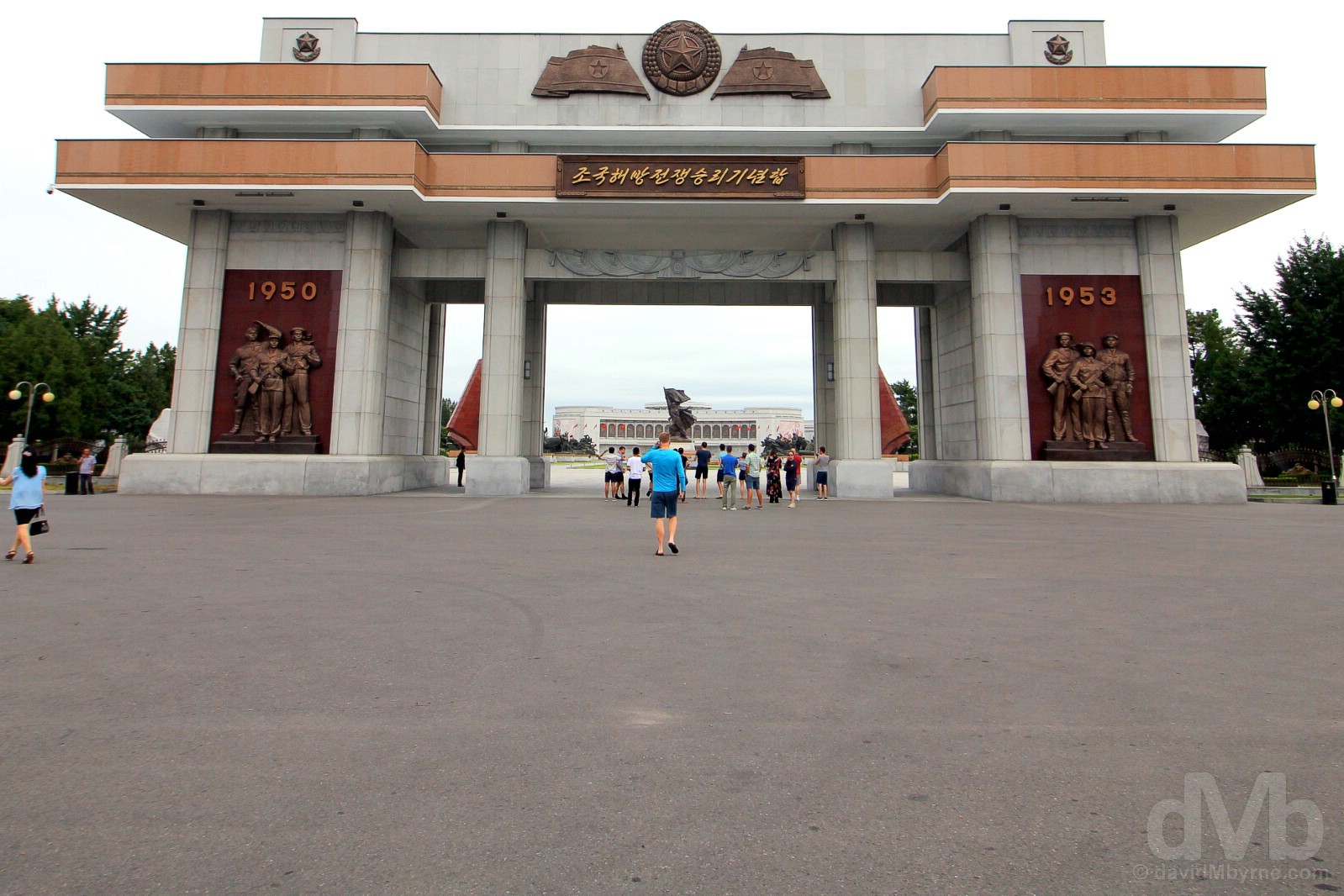
DAY 3 08:16 – VICTORIOUS FATHERLAND LIBERATION WAR MUSEUM – The entrance to the Victorious Fatherland Liberation War Museum in Pyongyang, North Korea. August 16, 2017.
Originally opened in 1953, the year the war it presents was paused (North & South Korea are still technically at war) and moved to this uber impressive purpose-built facility in 1963, this is considered North Korea’s preeminent museum, and it’s not hard to see why. Again, everything is big, the statues tall, the spaces vast & polished. We didn’t have time to read any of the (I assume propaganda-heavy) displays as we were hastily moved, clock ticking, with military precision from one area of the museum to another, the spectacle of the place coupled with the anti-US rhetoric & economical truths being happily spouted by our guide more that sufficient entertainment.
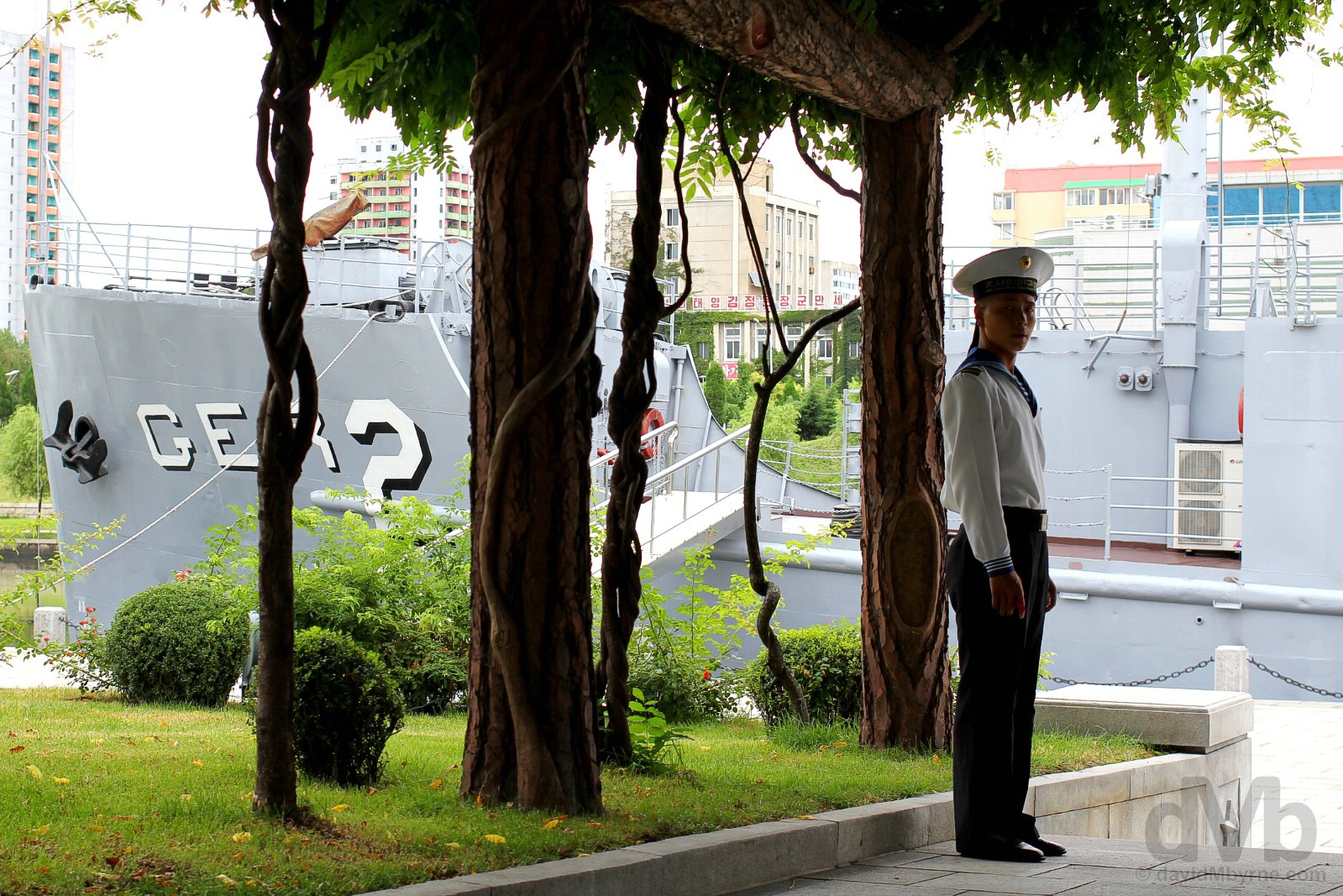
DAY 3 08:35 – AMERICAN TROPHIES/USS PUEBLO – Guarding the USS Pueblo in the grounds of the Victorious Fatherland Liberation War Museum, Pyongyang, North Korea. August 16, 2017.
There are many American trophies on display in the vast 3-level museum – planes, tanks, weaponry, armoured vehicles and various other warring bit & bobs – but pride of place goes to the USS Pueblo, probably North Korea’s most prized possession. Launched in 1944, the small Pueblo was an environmental research ship attached to Navy intelligence as a spy ship. It was attacked and seised in January 1968 by the North Korean Navy, they claiming it deliberately entered their territorial waters (needless to say the US rebuff this accusation, claiming they were in international waters). One sailor was killed in the assault and 82 were captured; they would go on to endure an 11-month prison & torture ordeal with the whole incident rising Cold War tensions between Western democracies and the Soviet Union & China. Proudly displayed today by the North Koreans, the Pueblo is still listed to this day as a commissioned US Navy vessel, it being the only ship of the US Navy still on the commissioned roster but currently being held captive (a US Senate resolution in 2008 officially declared the vessel ‘hijacked’ by ‘a foreign military’).
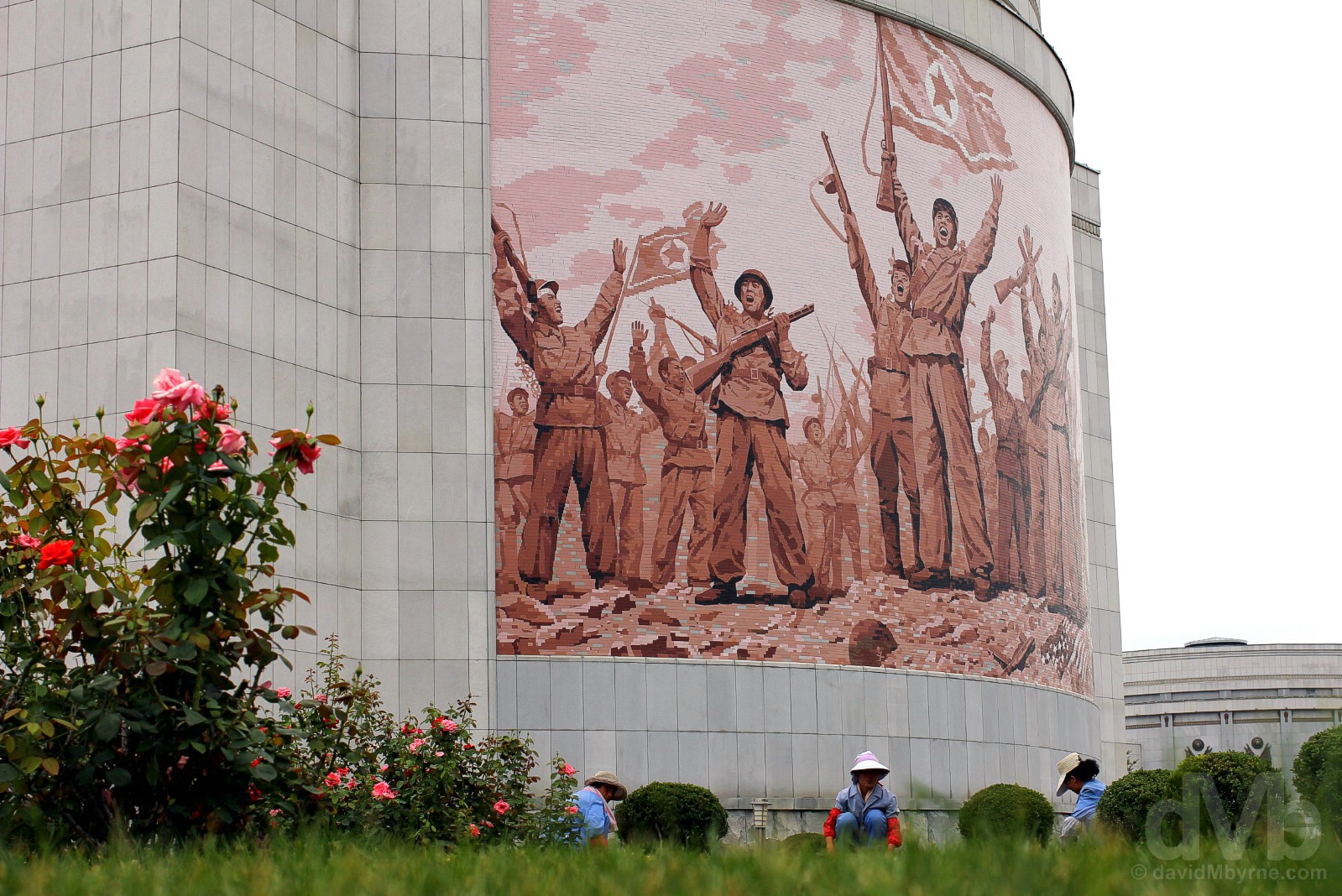
DAY 3 08:37 – Tending to the immaculate grounds of the Victorious Fatherland Liberation War Museum, Pyongyang, North Korea. August 16, 2017.
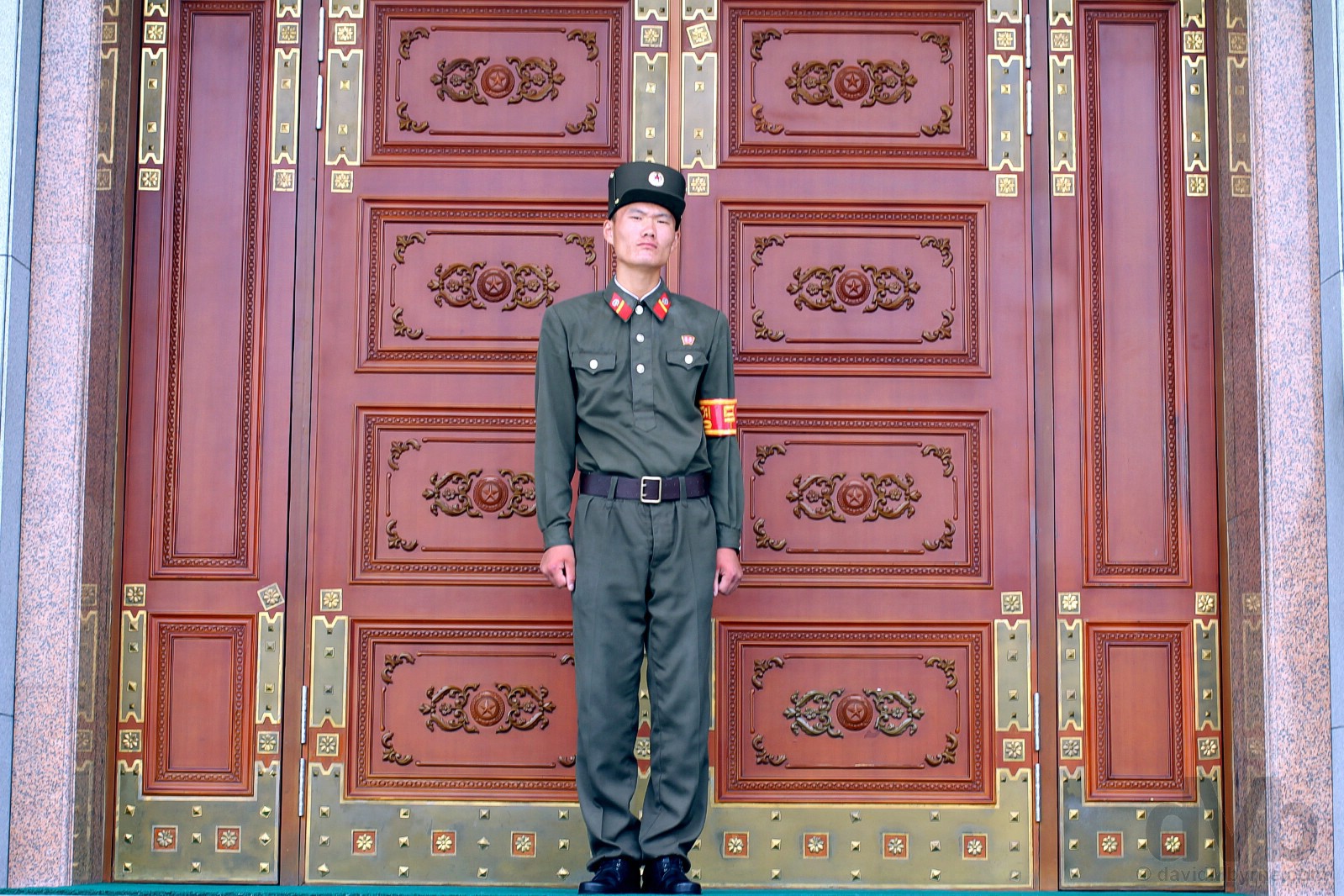
DAY 3 08:40 – The Victorious Fatherland Liberation War Museum, Pyongyang, North Korea. August 16, 2017.
Behind these doors, where cameras are not allowed, the first sight that greets visitors is a 4-meter-tall colored statue atop a sweeping flight of stairs of what looks remarkably like Kim Jong-un, but is actually a youthful representation of his grandfather, The Great Leader Kim Il-sung. From there it’s up, up, up via more sweeping staircases and halls of polished marble – we were never not going to be marched through the ‘Hall Showing the US Imperialist Aggressors Atrocities‘ or the neighbouring ‘Hall Showing the Strengthening of National Defence Capacity after the War’ – to the impressive 360-degree revolving top-floor battlefield diorama portraying the July 1950 Battle of Taejon. It was a decisive battle of the Korean War in which the North Koreans claimed a victory over a US/South Korean coalition & captured what was to be the highest ranking American officer they’d capture during the course of the whole 1905-1953 war, reason enough I guess to immortalise the battle on what is one of the largest dioramas on earth.

DAY 3 09:20 – Young Pioneers tour group outside the Victorious Fatherland Liberation War Museum 40 minutes prior to our departure from the city. Pyongyang, North Korea. August 16, 2017.
I shun tours whenever possible. I’ve nothing against them, but independently is how I travel. Sometimes, however, in order to get somewhere one has no option but to have their hand held. I’ve been lucky with groups I’ve been a part of in the past, this North Korea tour gathering no exception – they were a varied and fun bunch of people.
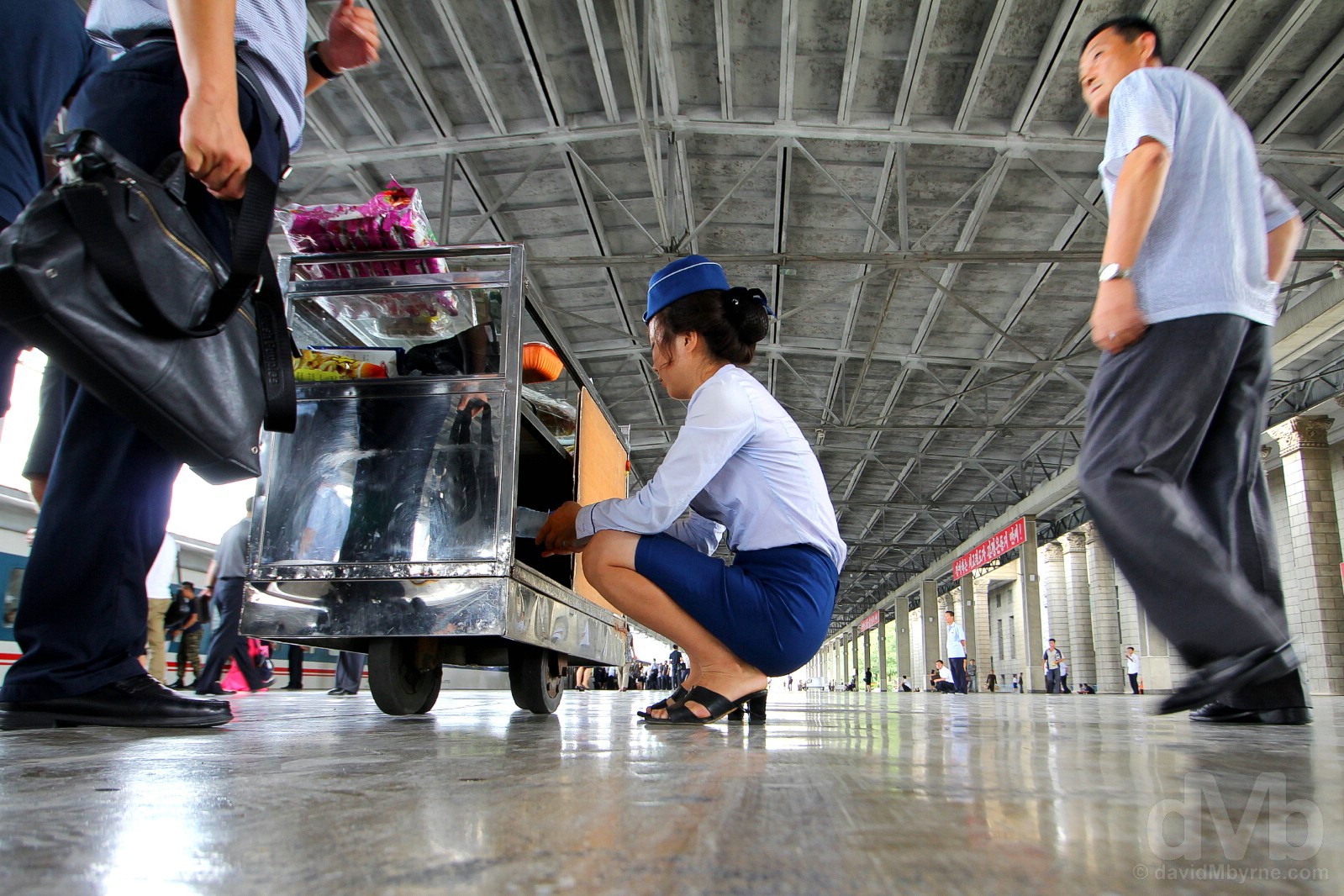
DAY 3 09:57 – Trolley lady. Pyongyang Station, Pyongyang, North Korea. August 16, 2017.
Too Soon?
There’s rarely much to say about a departure. Everyone knows the outcome. The departure from North Korea came about as expected and maybe sooner than most might have wanted. That said, the consensus, at least in my carriage compartment, seemed to be that more time in the country would simply serve to prolong the deception as opposed to giving a greater understanding of North Korea, something I doubt any visiting foreigner will ever truly attain.
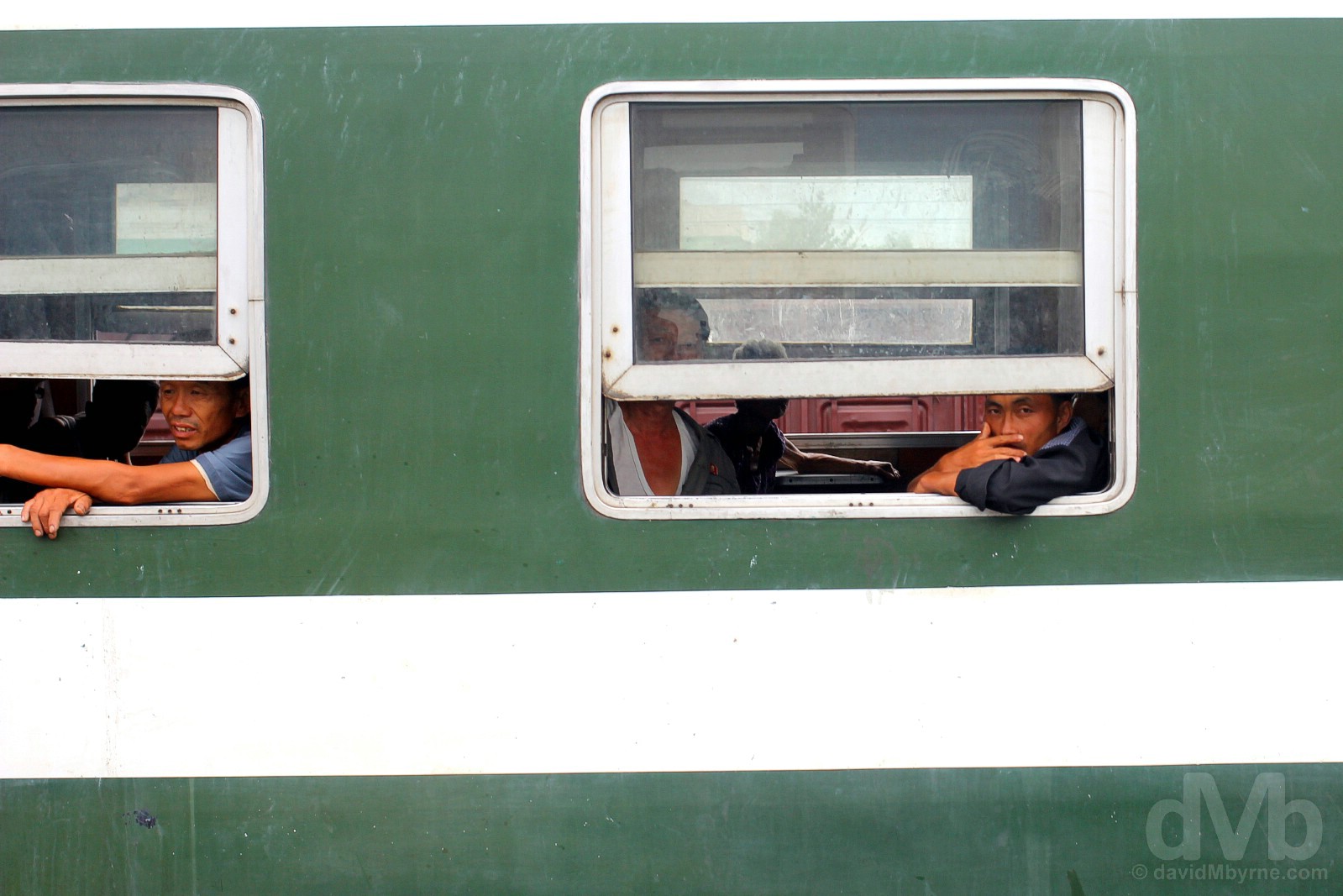
DAY 3 12:48 – Riding the Pyongui Line rails between Pyongyang & Sinuiju, North Korea. August 16, 2017.
My camera was quiet on the return train ride back to Sinuiju & the border with China. I did take a few shots from the train en route, my last in North Korea.
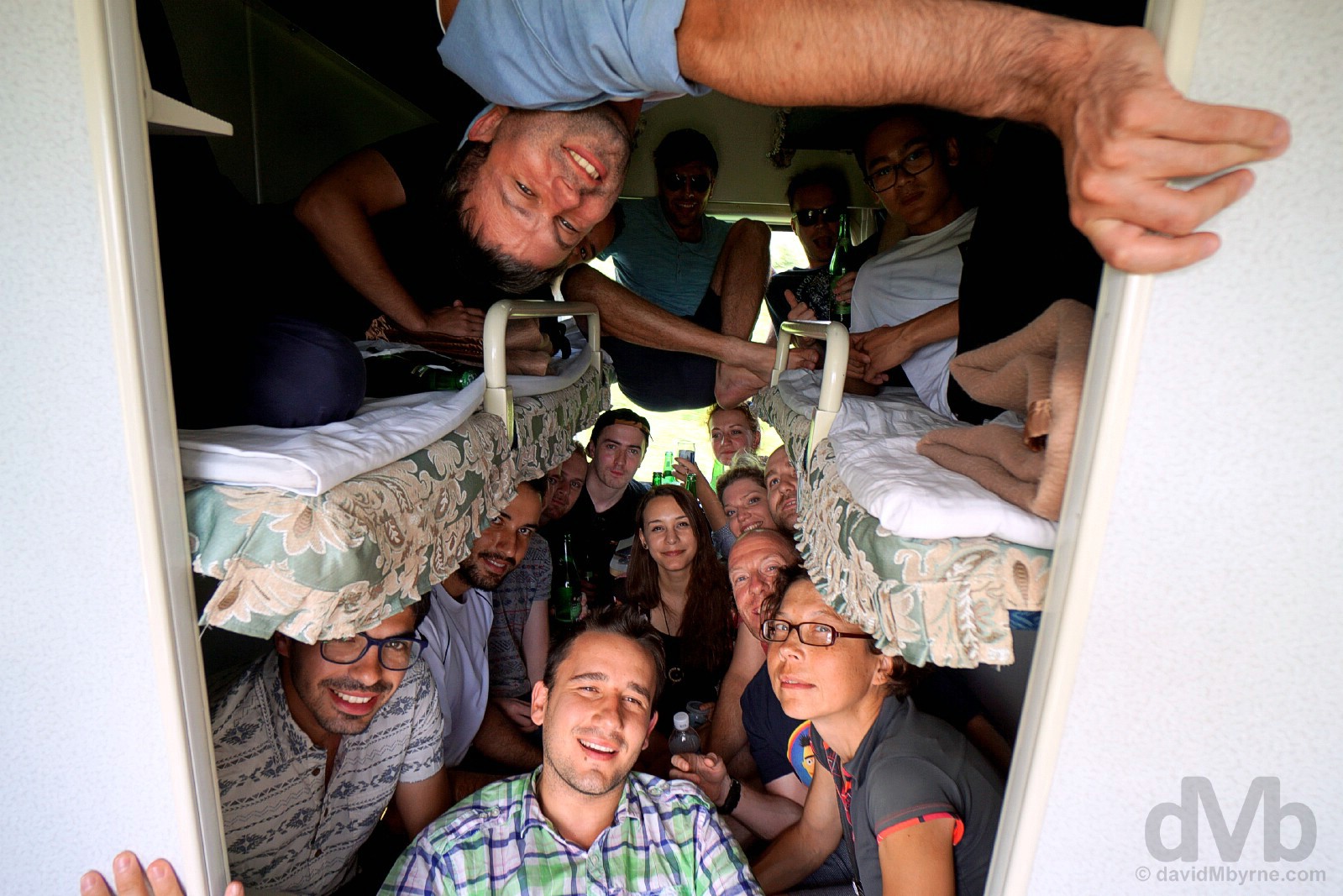
DAY 3 14:16 – Carriage bunk group shot en route from Pyongyang & Sinuiju, North Korea. August 16, 2017.
I knew before even getting to North Korea that I’d probably leave it none the wiser. And so it proved. Easily the most transparent aspect of the Hermit Kingdom is its closed nature. Its secrecy. North Korea divulges very little, even to those who make the effort to go there, and anything it does divulge is carefully presented, meticulously staged. Or is it? Can a packed metro system in the middle of the day be staged? Swarms of shoppers in a busy 3-level department store? How about hundreds, maybe thousands, of smiling faces in busy a nighttime fun fair? That shit is real, and it’s as normal as gets in most countries around the world not called North Korea.
– The Two Koreas, A Contemporary History, Third Edition (p459)
In North Korea the everyday normal sights my foreign eyes witnessed invariably come with an asterisk, with doubt as to their authenticity, for no other reason than this being North Korea. Maybe the DPRK is more ‘normal’ than we’re led to believe, more ‘normal’ than is widely portrayed. Maybe, maybe not. My problem having now been there is that I still don’t know, and knowingly never will.

